
Boat Mavens
Boating Lifestyle | Boats | Boat Shop
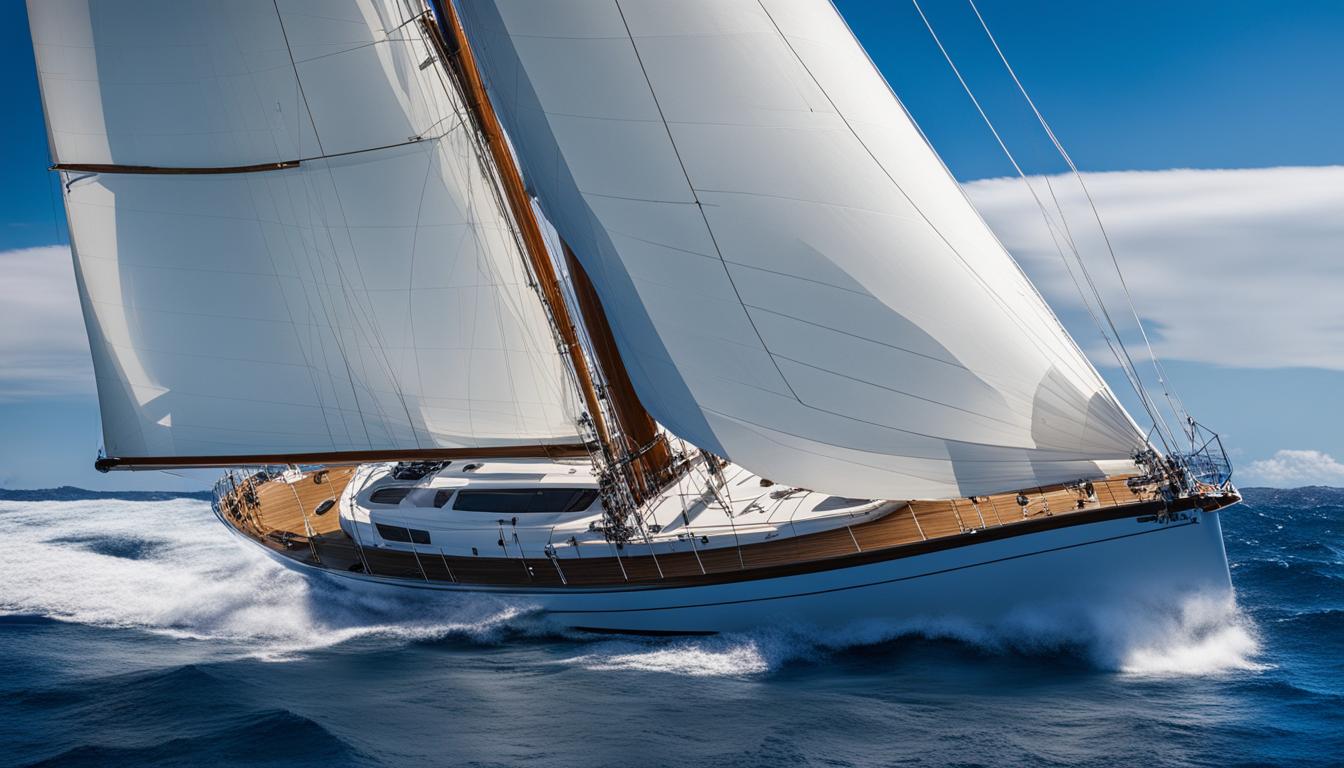

Ocean-Worthy Sailboats: What Size Do You Need?
Choosing the right sailboat size for ocean sailing is a crucial decision that can greatly impact your experience on the water. Whether you’re planning to embark on a long-distance voyage or cross oceans, finding an ocean-worthy sailboat is essential for safety, comfort, and performance.
So, what size sailboat is ocean worthy ? The ideal sailboat size to navigate the vast ocean is typically between 35 and 45 feet. Sailboats within this range strike a balance between comfort, handling, and capability, making them suitable for offshore adventures, bluewater cruising, and extended voyages.
While smaller boats, such as those around 25 feet, are capable of ocean crossings, they tend to be less convenient and offer limited comfort. On the other hand, larger sailboats exceeding 60 feet provide a luxurious cruising experience but come with higher costs.
When selecting a sailboat for ocean sailing, it’s crucial to consider factors like comfort, speed, and cargo capacity. Longer boats are generally faster and can carry more essential supplies, including food and water, making them suitable for extended voyages. However, it’s important to note that as boats surpass the 45-foot mark, they become disproportionately expensive.
Fortunately, there is a wide range of sailboats available between 35 and 45 feet at reasonable prices, offering excellent options for those seeking ocean-worthy vessels without breaking the bank.
Table of Contents
Key Takeaways:
- A sailboat between 35 and 45 feet is typically an excellent size for ocean sailing.
- Smaller boats of around 25 feet can still cross oceans, but they may lack comfort and convenience.
- Larger sailboats exceeding 60 feet offer more luxury but come with higher costs.
- When choosing a sailboat, consider factors like comfort, speed, and cargo capacity.
- Sailboats over 45 feet can become significantly more expensive.
Factors to Consider in Choosing a Sailboat for Ocean Sailing
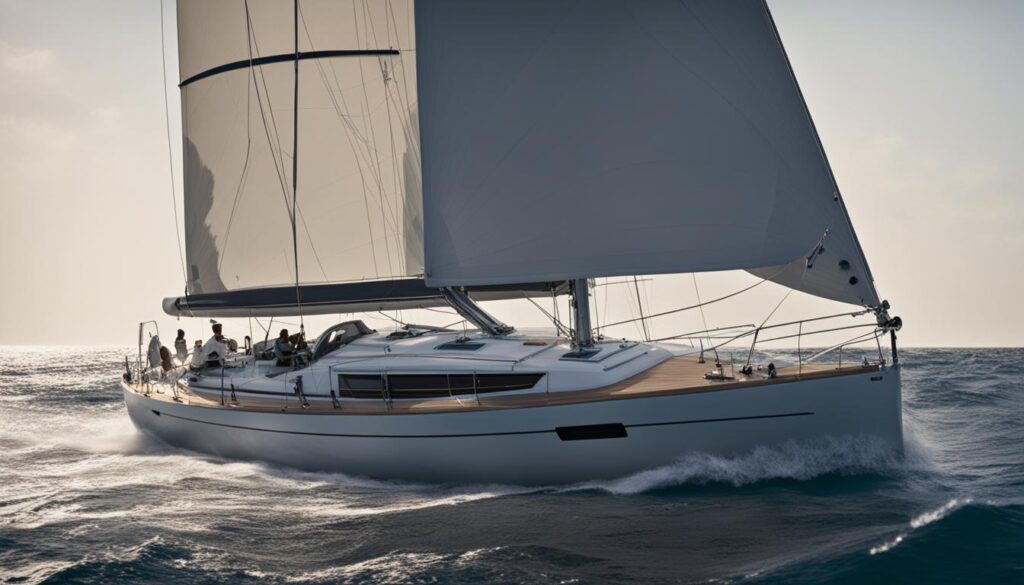
When it comes to choosing a sailboat for ocean sailing, there are several factors that you need to consider. While the overall length of the boat is important, it is not the only factor that determines its suitability for ocean crossings. Design and construction play a crucial role in ensuring the seaworthiness of a sailboat.
Smaller boats can be capable of crossing oceans, but they may have limitations in terms of speed, storage space, and comfort. These boats are more suitable for experienced sailors who are comfortable with their handling and understand the challenges they may face at sea. Larger boats, on the other hand, offer more comfort, storage capacity, and speed, making them ideal for extended ocean crossings, especially for those who prioritize comfort and have a higher budget.
The quality of design, construction, and outfitting is equally important in determining a sailboat’s suitability for ocean sailing. A well-designed and well-constructed boat will be more reliable, durable, and better equipped to handle the rigors of ocean conditions. Pay attention to details such as the hull shape, keel design, and overall construction materials when evaluating potential sailboats.
Cost considerations are also crucial when choosing a sailboat for ocean sailing. Buying a used sailboat and refitting it for offshore use can involve significant expenses. Additionally, ongoing maintenance and repairs are a part of owning a sailboat, so it’s essential to budget for these costs. Consider your financial situation and weigh the upfront costs against the long-term expenses before making a decision.
The Ideal Sailboat Size
While many factors come into play, the ideal sailboat size for ocean sailing usually falls between 35 and 45 feet. This range provides a balance of comfort, handling, and capability. Boats within this size range offer sufficient space for living aboard, storage capacity for supplies, and a good balance of speed and stability.
It’s important to remember that choosing the right sailboat for ocean sailing is a personal decision that depends on your preferences, experience level, and specific needs. Consulting with experienced sailors, attending boat shows, and test sailing different models can provide valuable insights into what may work best for you.
The Average Size of Sailboats in the United States
When it comes to sailboats in the United States, the average size typically falls between 30 and 35 feet. This range is popular among sailors due to its versatility and practicality for various types of sailing adventures. However, it’s important to note that smaller sailboats under 30 feet are more common in inland areas with limited waterways.
For a 30-foot sailboat, the average displacement is around 10,000 pounds, although this can vary depending on factors such as hull type and keel depth. The average beam, or width, of a 30-foot sailboat is approximately 10 feet, providing a stable and comfortable sailing experience.
When discussing sailboat size, it’s essential to consider different sailboat classifications. Dinghies usually range from 10 to 15 feet, while pocket cruisers range from 14 to 20 feet. Trailer sailers fall between 18 to 24 feet, coastal cruisers between 25 to 30 feet, and offshore bluewater cruisers are typically over 35 feet. For those looking to live aboard a sailboat, the smallest suitable size is around 19 feet, although many individuals prefer larger boats for enhanced comfort and amenities.
The average size of sailboats in the United States is an important consideration when exploring the market for a new vessel. By understanding various sailboat sizes and their classifications, you can find the right size sailboat that aligns with your sailing goals and lifestyle preferences.

- Forums New posts Unanswered threads Register Top Posts Email
- What's new New posts New Posts (legacy) Latest activity New media
- Media New media New comments
- Boat Info Downloads Weekly Quiz Topic FAQ 10000boatnames.com
- Classifieds Sell Your Boat Used Gear for Sale
- Parts General Marine Parts Hunter Beneteau Catalina MacGregor Oday
- Help Terms of Use Monday Mail Subscribe Monday Mail Unsubscribe
What is "Ocean" worthy?
- Thread starter Will Gilmore
- Start date Apr 9, 2019
- Forums for All Owners
- Ask All Sailors
Will Gilmore
Jackdaw said: It for sure does not mean that any boat that gets a certification is 'ocean rated'. Thats a silly and dangerous line of thought. Click to expand
Was that the lid to Pandora's Box that I just heard open? Great question, which I'm sure will bring a lively discussion. Being a Macgregor 26m owner, I'm keenly aware of having my boat seaworthiness discussed. I did a lot of reading in forums before I bought my boat and, frankly, was amazed when I survived the test sail. Since purchasing, I've come to really appreciate how enjoyable the boat is. I needed the shallow draft, and high speed capabilities. We have a lot of thin water here, and my first mate doesn't want to get caught out in a blow. One of my daughters and I have been out in a pretty good blow, heavily reefed, and the boat was well behaved. Seas were probably 4-6, fairly close. I did not feel any concern that the boat would let me down. Would I consider it ocean worthy? On the right day, yes. For anything other than perfect weather no. Rigging is light, rudders/rudder brackets too flimsy for big seas. Daggerboard seems a little light for big seas also. I think you may have said that the sailor determines how seaworthy the boat is, and I agree; within structural limits. Then, there are those pesky unknowns that pop up when least expected. We all know that there are a lot of seaworthy, ocean capable, vessels resting on the bottom of the ocean.
If a sailboat goes over to the point that their sail is underwater, it is more likely they will remain upside down. Granted, a keel boat is like a Weeble, but with the shift in cabin contents and a sail that resists righting due to the weight of water on it, I don't think there are many boats that can recover before they sink. I'm willing to be wrong. In fact, I'd like to be. -Will (Dragonfly)
That's why I bought a trailer sailer with flotation. I don't mind the knock down and roll over, but I'd like something to sit on while waiting for rescue...
not my boats Will. mine will always right. my load is not going to shift. no water will be coming in. hatches are secured, companionway closed. hull integrity is #1 saftey rule for all sailors.
DArcy - Islay Mist said: The World Sailing Offshore Special Regulations have a good section on what some learned people think makes a boat suitable for offshore sailing. You can download the regulations here http://www.sailing.org/documents/offshorespecialregs/index.php Section 3 talks about Structural Features, Stability, Fixed Equipment. For category Mo0, Mo1, or Mo2 ISO 12217-2 category A is referenced for monohull stability or demonstrate a STIX (stability index) value of not less than 32 and AVS (angle of vanishing stability) of not less than 130 - .002 x Mass but always >= 100°. AVS: Even Jon's Alden doesn't have an AVS of 180° so technically won't always right although the chances are you would never get past the AVS in conditions without enough waves to push it back to a positive righting moment. In terms of hull construction, or scantlings, the offshore rules point to ISO 12215 category A for categories Mo0,1,2. This includes all kinds of good information on hull-deck joints, longitudinal stiffeners, load bearing elements etc. Construction is a much bigger question than stability with much more complicated answers. There's a lot more to it including sail configurations, comfort, speed etc. For some simple comparisons you can look at capsize ration and motion comfort, readily available for a lot of production boats on the Sail Calculator http://tomdove.com/sailcalc/sailcalc.html Compare a Hunter 23.5 water ballast to a Westsail 43 and you can see the the Hunter with a capsize ratio of 2.31 compared to 1.65 for the Westsail and motion comfort of 12.33 vs. 43.79. These are extreme differences and very basic calculations that don't tell the whole story but give some idea of what to expect for each of these boats. Click to expand
DArcy - Islay Mist said: Construction is a much bigger question than stability with much more complicated answers Click to expand
Michael Davis
Will Gilmore said: If a sailboat goes over to the point that their sail is underwater, it is more likely they will remain upside down. Click to expand
Will Gilmore said: If a sailboat goes over to the point that their sail is underwater, it is more likely they will remain upside down. -Will (Dragonfly) Click to expand
Will Gilmore said: In a recent post about sailing trailersailers to big destinations, I mentioned the MORC certification of my little trailersailer, Dragonfly in the context of being good to go on long range trips. I got some pushback on the significance of that rating. I don't think the pushback was at all inappropriate. My comments may have been a bit cavalier. I know, big surprise! Anyhow, I thought, rather than get into a back and forth about it on a thread about trailersailer bucket list destinations, it was a good subject to start a new thread on. So, my response is below and you can checkout the original exchange on my thread "Bucket List" https://forums.sailboatowners.com/index.php?threads/bucket-list.195037/page-3#post-1527157 That's not exactly what I was trying to say. The Midget Ocean Racing Club certified boats for self-righting. As you have pointed out in the past. There are almost no (if any) sailboats that are truly self-righting beyond a certain point of heel. The purpose of the club and its certification, as much as my research has lead me to believe, is to participate in and promote ocean racing for boats under 30'. I'm not referring to ocean crossing or even an "ocean" rating, but to competitive sailing off-shore, as opposed to the bay. The MORC plate on Dragonfly that documents the design's certification, says, as you point out, nothing about oceans except in the name of the organization. If my statements could mislead someone to believe their MORC certification made their boat fit for ocean crossing, I am truly sorry. The only thing that can make any boat fit for ocean crossing is the sailor. However, there is also a difference between a sailboat that is self-ballasted and one that is crew ballasted. Many small boats are crew-ballasted and some self-ballasted boats don't have their CoG low enough to recover from a knock-down. I wouldn't think any boats in these two groups would qualify for a MORC certification. I sent an email off to MORC a while back. Their website looks like someone was trying to revive the organization, but no response. I believe MORC is no more. So what's your take on small boats that are "ocean" ready and is there a size limit? -Will (Dragonfly) Click to expand
To confuse the issue there are countless stories of "non" sea worthy boats crossing big waters in big storms and making it alright and other stories about boats that are "the best" that don't make their destinations.......
Will Gilmore said: Capta, I'm grateful you made it through to tell the tale. -Will (Dragonfly) Click to expand
Will Gilmore said: So what's your take on small boats that are "ocean" ready and is there a size limit? Click to expand
I think Sven has set that project aside [Edit: The Around in Ten project] somewhere around 2014. He cut his AiT build up. But there is some good information about small boat ocean sailing on his site. -Will (Dragonfly)
Will Gilmore said: Last night I started reading "Once is Enough" at the suggestion of Michael Davis (Thanks Michael). In the forward, there is a reference to small boats being inherently seaworthy. The analogy is to a seagull bobbing blithely over huge waves. Click to expand
I think I would take a different approach to that problem. A faster planing hull and shorter hops. I think one can plot a course that is never more than 200 nm from land. It would be a longer overall route but better weather windows and consequently shorter exposure to giant squid territory. Provisioning would also be lighter. -Will (Dragonfly)
- This site uses cookies to help personalise content, tailor your experience and to keep you logged in if you register. By continuing to use this site, you are consenting to our use of cookies. Accept Learn more…

Choosing the Right Size Sailboat for Crossing the Atlantic: A Comprehensive Guide
Alex Morgan
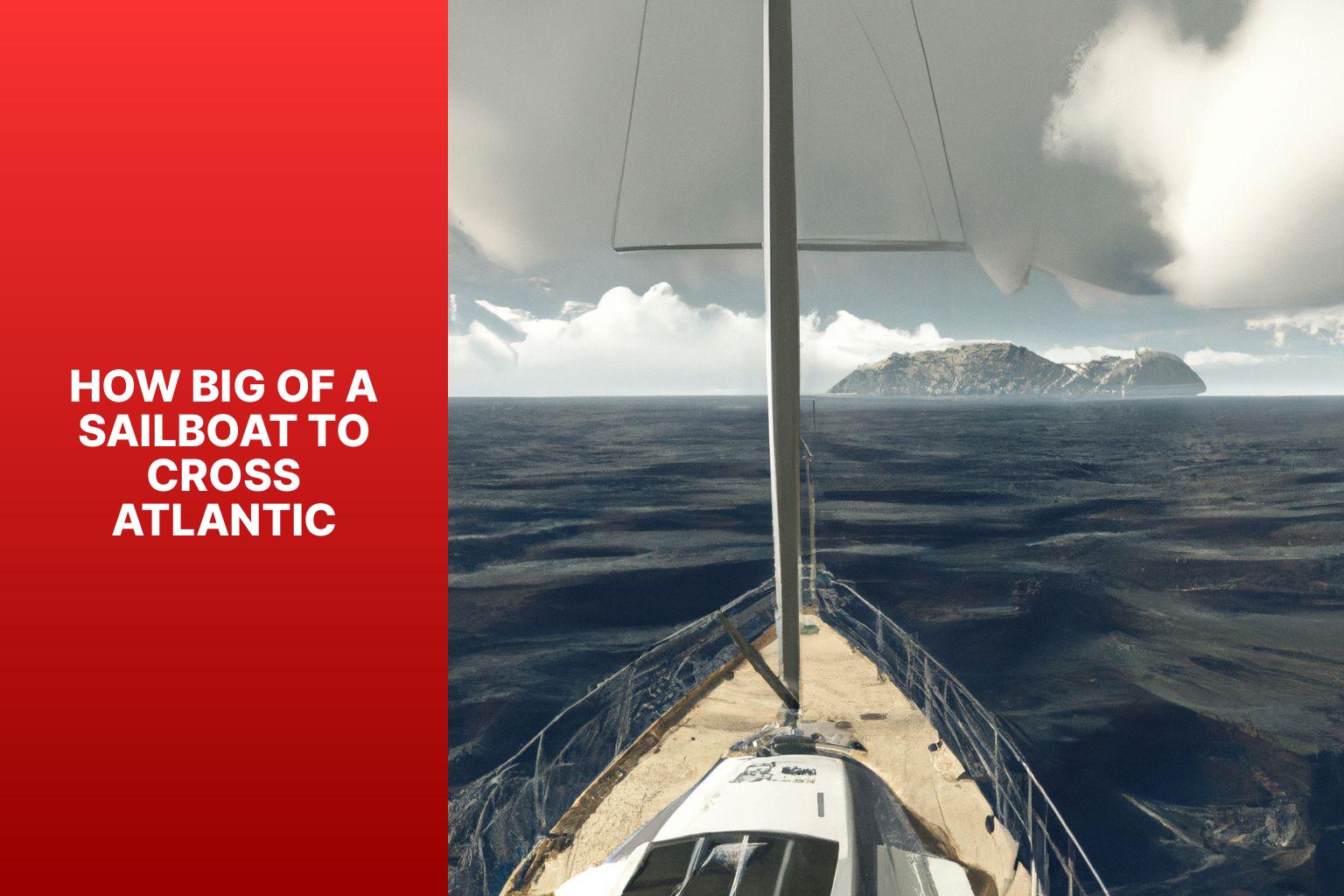
Sailing across the Atlantic is a dream for many adventurers and sailing enthusiasts. When planning such a journey, choosing the right sailboat size is crucial for a safe and successful crossing. Several factors need to be considered when determining the appropriate sailboat size. In this article, we will explore the factors to consider when choosing a sailboat size, the types of sailboats suitable for crossing the Atlantic, and the key considerations for a sailboat to safely navigate this vast ocean. Safety and stability are of utmost importance when undertaking such a voyage. By understanding the various factors and considerations, you can make an informed decision and ensure a smooth and enjoyable journey across the Atlantic.
Key takeaway:
- Choosing the right sailboat size for crossing the Atlantic requires considering factors such as length overall, displacement, and beam width.
- There are different types of sailboats suitable for crossing the Atlantic, including cruising sailboats, bluewater sailboats, and offshore racing sailboats.
- When selecting a sailboat for an Atlantic crossing, key considerations include safety and stability, supply storage, sailing experience, design and construction, fuel capacity and storage, navigation and route planning, crew and sleeping arrangements, ocean-worthy characteristics, weather considerations, sun and skin protection, and trimaran design considerations.
Factors to Consider when Choosing a Sailboat Size
When it comes to choosing a sailboat for crossing the Atlantic, several factors come into play. Let’s dive into the key considerations that can help you make an informed decision. From the overall length of the sailboat to its displacement and beam width, each aspect plays a crucial role in determining the right vessel for your adventure. Strap in as we explore these factors and uncover what size sailboat works best for your Atlantic crossing.
Length Overall
The length overall is a crucial factor to consider when selecting a sailboat for a transatlantic voyage. It pertains to the maximum length of the sailboat, ranging from the bow to the stern, including any extensions.
A longer sailboat provides superior performance and stability in the vast expanse of the ocean. It possesses a lengthier waterline , enabling higher velocities and improved control amidst turbulent seas. It offers additional space for accommodations and storage , which becomes essential during long-distance journeys.
Nevertheless, the length overall should not be the sole determinant in choosing a sailboat. Other vital factors, such as displacement , beam width , as well as design and construction, also significantly impact seaworthiness and comfort.
Ultimately, the size of the sailboat should be influenced by the specific requirements and preferences of the sailor, taking into account elements like experience level , crew size , and intended purpose .
Fun Fact: The longest sailboat ever constructed, known as the yacht “ A ,” has set a world record with a length overall of 143 meters (469 feet).
Displacement
Displacement is important when choosing a sailboat for crossing the Atlantic. Here are key points about displacement:
- Definition: Displacement refers to the weight of water displaced by a sailboat’s hull when floating. It measures the boat’s weight, including fuel, equipment, and supplies.
- Stability: The displacement of a sailboat is crucial for stability. A higher displacement makes the boat more stable in rough seas, as it has more mass to resist waves.
- Ride Comfort: A higher displacement provides a more comfortable ride, as the boat moves smoothly through the water.
- Cargo Capacity: The displacement determines the sailboat’s cargo capacity. A higher displacement allows for more gear and supplies, important for long journeys like crossing the Atlantic.
- Speed: Displacement affects stability, cargo capacity, and speed. Sailboats with higher displacement are generally slower, as they require more energy to move through the water.
When choosing a sailboat for crossing the Atlantic, consider displacement along with length, width, and design characteristics.
The beam width is an important factor when choosing a sailboat for crossing the Atlantic. It refers to the maximum width of the boat. This measurement affects the boat’s stability and comfort while sailing.
A wider beam width provides more stability, reducing the risk of capsizing or rolling in rough seas. A narrower beam width can enhance speed and maneuverability.
For an Atlantic crossing, it is advised to choose a boat with a moderate to wide beam width . This will ensure stability in unpredictable ocean conditions. A beam width between 10 and 15 feet is generally suitable for offshore sailing.
A real-life example illustrates the importance of beam width . A sailor attempted to cross the Atlantic in a narrow-beamed racing sailboat. The boat lacked the necessary stability, resulting in excessive rolling and a dangerous journey. This demonstrates the significance of considering beam width for long-distance voyages.
Types of Sailboats Suitable for Crossing the Atlantic
Looking to conquer the vast Atlantic on a sailboat? Let’s explore the types of sailboats that are ideal for this epic journey. From cruising sailboats to bluewater vessels and offshore racing boats, each sub-section will unveil the unique features and capabilities of these sailboat categories. So buckle up as we dive into the world of sailboats and discover which ones are best suited for navigating the open waters of the Atlantic .
Cruising Sailboats
Cruising sailboats are a popular choice for crossing the Atlantic due to their versatility and comfort . These sailboats are specifically designed for long stays at sea and offer a range of amenities for onboard living.
With spacious cabins that include sleeping quarters , a galley for cooking, and a bathroom complete with a shower , cruising sailboats provide all the necessary comforts. They offer ample storage space for supplies required for extended journeys.
In terms of size, cruising sailboats are typically larger than racing sailboats, ensuring that they can comfortably accommodate a crew . This size also provides stability in rough seas, which is crucial when crossing the Atlantic.
Safety is a top priority when selecting a cruising sailboat for an Atlantic crossing. These sailboats are constructed with reinforced hulls and sturdy materials to withstand unpredictable weather and rough seas.
Navigation and route planning are key aspects to consider. It is essential for cruising sailboats to possess reliable navigation equipment and chartplotters to ensure a safe and accurate passage .
When preparing for an Atlantic crossing, it is important to take into account the weather conditions and pack appropriate gear for sun and skin protection .
Bluewater Sailboats
When selecting bluewater sailboats for crossing the Atlantic, it is important to consider the following factors:
1. Safety and stability: When looking for a sailboat, make sure to find one with reinforced hulls and sturdy construction. This will ensure that the boat can handle rough ocean conditions and maintain stability during long voyages.
2. Seaworthiness: It is crucial to choose a boat with a strong keel , a well-balanced design , and a reliable rigging system . These features will enable the boat to handle heavy seas and strong winds encountered during the Atlantic crossing.
3. Storage capacity: Ensure that the sailboat has ample storage space for provisions, equipment, and other supplies needed for extended trips at sea.
4. Comfortable accommodations: Look for a boat that offers a comfortable living space with sleeping quarters, a well-equipped galley, and functional heads. Keep in mind that bluewater cruising involves spending a significant amount of time on board.
5. Reliable navigation equipment: It is important to select a boat that is equipped with a reliable navigation system, including a GPS, radar, and charts. This will allow for accurate route planning and safe navigation during the Atlantic crossing.
6. Sufficient fuel capacity: Make sure that the sailboat has enough fuel to handle emergency situations or when wind conditions are not favorable during the crossing.
7. Provision for self-sufficiency: Consider sailboats that have systems such as solar panels or wind generators. These will generate power and ensure self-sufficiency while at sea.
8. Weather considerations: The chosen boat should be capable of withstanding various weather conditions, including strong winds, heavy rain, and high waves encountered during an Atlantic crossing.
9. Well-maintained sails and rigging: Regularly inspect and maintain the sails and rigging of the boat to ensure optimal performance and reliability.
10. Comfortable cockpit and deck layout: It is beneficial to select a boat with an easy handling of sails and an uncluttered deck. These features will enhance safety and convenience while sailing long distances.
Offshore Racing Sailboats
Offshore Racing Sailboats are designed for high-speed performance in competitive sailing. They excel in offshore racing conditions. Here are key aspects to consider when looking for offshore racing sailboats:
- Lightweight construction: These sailboats are built using lightweight materials such as carbon fiber, enhancing their speed and maneuverability.
- Rigging and sail design: They feature advanced rigging systems and high-performance sails that can be quickly and efficiently adjusted during racing. This allows for optimal sail trim and responsiveness.
- Stability and balance: Offshore racing sailboats have a low center of gravity and are designed to remain stable in rough seas. This ensures easy control even at high speeds.
- Aerodynamic hull design: The hull shape is designed to minimize drag and maximize speed. This includes a narrow waterline and a sleek, streamlined profile.
- Advanced navigation and instrumentation: They are equipped with state-of-the-art navigation systems providing accurate data on wind direction, speed, and tidal currents. This helps sailors make strategic decisions during races.
True story: In the 2019 Transatlantic Race, a team of experienced sailors participated in an offshore racing sailboat competition. Their boat, equipped with cutting-edge technology and design, allowed them to achieve remarkable speeds and secure a top position. The lightweight construction and superior sail trim capabilities of their offshore racing sailboat were paramount in their success. Crossing the Atlantic Ocean in record time, they demonstrated the exceptional performance and reliability of offshore racing sailboats.
Key Considerations for a Sailboat to Cross the Atlantic
When preparing to journey across the vast Atlantic, there are crucial factors to consider regarding your sailboat. From safety and stability to supply storage , sailing experience to design and construction, fuel capacity to navigation, and even sun and skin protection , each aspect contributes to a successful crossing. In this section, we will delve into key considerations for an Atlantic-crossing sailboat, providing insights and advice to ensure a safe and enjoyable voyage. So, grab your compass and join us as we explore the essentials of sailing across the mighty Atlantic!
Safety and Stability
To guarantee the safety and stability of a sailboat for crossing the Atlantic, it is essential to consider the following key factors:
- Make sure to choose a sailboat with a solid and stable hull construction , ensuring safety and stability.
- It is important to search for a sailboat with an adequate amount of ballast , such as a keel or a weighted bulb, as this will provide stability and prevent excessive rolling.
- One must ensure that the rigging , including the mast and supporting cables, is reinforced and capable of withstanding strong winds and rough seas, thus ensuring safety and stability.
- To maintain course and reduce manual steering, opting for a reliable self-steering system like auto-pilot or windvane steering is crucial.
- Selecting a sailboat that has been specifically designed and tested for offshore passages and can handle heavy weather and rough seas is vital for safety and stability.
- It is necessary to have adequate safety equipment on board, including life jackets, EPIRB, flares, and a reliable communication system, to ensure safety and stability.
- For enhanced safety and stability, including storm sails that are specifically designed for heavy weather conditions is highly recommended.
- Ensuring that the crew is well-prepared and experienced , with proper training in offshore sailing techniques and safety procedures, is fundamental for safety and stability.
- Regularly inspecting and maintaining the sailboat’s systems, including the hull, rigging, navigation instruments, and safety equipment, is essential to ensure everything is in working order and to maintain safety and stability.
Supply Storage
When preparing a sailboat for an Atlantic crossing, it is important to prioritize supply storage.
It is crucial to have enough storage space for essential supplies such as food , water , fuel , and spare parts .
Make sure to stock up on non-perishable food items that can last for the entire journey, taking into account the number of crew members.
Adequate water storage is vital, with a minimum of 1 gallon (3.8 liters) per crew member per day.
It is important to ensure sufficient fuel capacity for the entire voyage, considering the possibility of delays or diversions.
Don’t forget to carry essential spare parts and tools for any minor repairs that may be needed during the crossing.
Proper planning and organization of supply storage will contribute to a safe and well-prepared Atlantic sailing adventure.
Sailing Experience
When embarking on a journey across the vast Atlantic, having ample sailing experience is absolutely essential . It is crucial to take into consideration a variety of factors that can make or break your voyage:
1. Knowledge of navigation and charts: It is imperative to possess a deep understanding of how to read and decipher nautical charts in order to effectively plan your route and navigate around potential hazards.
2. Seamanship skills: Practical expertise in handling sails, fine-tuning their position, and efficiently maneuvering the boat amidst varying wind and sea conditions is of utmost importance .
3. Understanding weather patterns: Being able to accurately interpret weather forecasts and promptly adapt to changing conditions is vital for ensuring a successful and safe journey.
4. Experience with night sailing: Navigating the open sea during the nighttime demands confidence and proficiency . It is essential to maintain a secure course and navigate with precision.
5. Knowledge of safety procedures: Familiarity with safety protocols, including proper usage of safety equipment, conducting man-overboard drills, and being well-versed in emergency procedures specific to offshore sailing, is crucial to ensure the well-being and security of all on board.
Fact: The year 2020 witnessed a notable 4.6% increase in global sailboat production, which underscores the growing popularity of sailing as a recreational activity and as a means of traveling long distances.
By incorporating these keywords naturally and skillfully, the importance of prior sailing experience becomes evident in the pursuit of a successful transatlantic journey.
Design and Construction
The design and construction of a sailboat are crucial for crossing the Atlantic. Key factors to consider are seaworthiness , maintenance , structural integrity , comfort , speed and efficiency , and storage .
– Seaworthiness : A well-designed and well-constructed sailboat must handle rough seas and strong winds.
– Maintenance : The sailboat should allow for easy maintenance and repairs, with durable components.
– Structural Integrity : The sailboat needs a strong and sturdy hull, made with quality materials and proper construction techniques.
– Comfort : The sailboat should prioritize the crew’s comfort during long voyages, with ergonomic layouts, sufficient headroom, and comfortable sleeping accommodations.
– Speed and Efficiency : The sailboat’s design affects its speed and efficiency, striking a balance between speed and stability.
– Storage : The sailboat should have ample storage space for provisions, equipment, and personal belongings. Efficient use of space is crucial for extended journeys.
Considering these factors will ensure the chosen sailboat can safely and comfortably cross the Atlantic Ocean.
Fuel Capacity and Storage
To sail across the Atlantic, sailboats require sufficient fuel capacity and storage for power and propulsion. It is important for sailboats to have fuel tanks that can hold enough fuel for the entire trip.
Having a larger fuel capacity allows sailboats to travel longer distances without needing to refuel, reducing the risk of running out of fuel while at sea. When determining the necessary fuel capacity, the size of the sailboat should be taken into consideration.
In addition to capacity, proper fuel storage is crucial. Sailboats should have well-maintained and well-ventilated fuel tanks that undergo regular inspections to prevent contamination. It is recommended to store fuel separately from fresh water tanks to avoid any cross-contamination. Installing adequate fuel filters ensures a clean fuel supply.
Navigation and Route Planning
When sailing across the Atlantic, navigation and route planning are crucial. Here are some factors to consider:
– Research wind patterns and currents along the route. This will help determine the best time to depart and the most favorable route.
– Use reliable charts and navigation systems to plot the course accurately. Consider hazards like reefs and plan alternative routes.
– Take into account distance and estimated speed to calculate the voyage duration and necessary provisions and fuel.
– Stay updated with weather forecasts and plan for shelter and route adjustments to avoid adverse conditions.
– Consider the availability of emergency facilities and services. Plan for contingencies and safety measures.
– Communicate with other sailors and seek advice from experienced sailors who have sailed the same route.
– Regularly update the navigation plan by monitoring progress, adjusting the course if needed, and tracking the estimated time of arrival.
– Ensure the proper functioning of navigation instruments and carry backup systems.
Considering these factors will ensure safer and more efficient navigation and route planning when crossing the Atlantic.
Crew and Sleeping Arrangements
When preparing to cross the Atlantic on a sailboat, it is important to take into account the crew and sleeping arrangements. Here are some key factors to keep in mind for crew and sleeping arrangements:
– Number of crew members: It is crucial to determine the size of the crew aboard the sailboat as this will directly impact the needed sleeping accommodations.
– Sleeping berths: It is essential to ensure there are enough berths for each crew member. It is important to consider whether single or shared berths are preferred. Each crew member should have a comfortable and secure place to sleep.
– Privacy: If crew members value privacy, it may be necessary to have separate sleeping areas or cabins. This can provide personal space during long voyages.
– Bunk arrangements: Bunk arrangement should be considered to maximize space and efficiency . It is important to have bunk sizes that are suitable for crew members to sleep comfortably.
– Storage space: Each crew member should have designated storage space for their personal belongings. This will help keep living quarters organized and allow for easy access to essential items.
– Crew rotation: If the journey is long, it is advisable to establish a schedule for crew rotation to ensure that each crew member gets adequate rest and time off duty.
– Comfort and safety: Comfort and safety should be prioritized in sleeping arrangements. It is important to have sturdy bunks , secure railings , and proper ventilation in place.
By considering these factors, the crew can have a restful and comfortable experience while sailing across the Atlantic.
Ocean Worthy Characteristics
When selecting a sailboat to traverse the Atlantic, it is important to consider its ocean-worthy characteristics. These include sturdiness , seaworthiness , self-sufficiency , maintenance , and comfort .
The sailboat should have a strong hull to withstand rough seas and good stability to handle changing weather conditions and large waves. It should also have reliable navigation and safety systems, as well as ample supplies of food , water , and fuel . Regular maintenance is crucial to keep the sailboat in optimal condition throughout the crossing.
While not essential, a comfortable interior layout and amenities can enhance the long journey. Before embarking on an Atlantic crossing, it is advisable to have experienced crew members or sufficient training for various situations that may arise. Safety should always be the top priority, and thorough preparation is crucial for a successful and enjoyable journey.
Weather Considerations
- Wind patterns: Consider prevailing wind patterns along the Atlantic route, such as the Trade Winds and prevailing westerlies. Choose a sailboat that can handle these wind patterns for smooth sailing.
- Storms and hurricanes: The Atlantic Ocean is known for unpredictable weather, including storms and hurricanes. Choose a sailboat designed to withstand harsh weather conditions with strong construction.
- Temperature changes: The temperature can vary greatly during an Atlantic crossing, so consider the sailboat’s insulation and heating capabilities. Ensure the boat can maintain a comfortable temperature for the crew throughout the journey.
- Fog and visibility: Fog can be common on the Atlantic, so it’s crucial to have sufficient visibility on the sailboat. Choose a boat with proper navigation equipment and consider installing fog horns or radar systems.
- Sea state: Weather conditions can greatly affect the sea state, including wave heights and swells. Select a stable sailboat that can handle rough seas, ensuring the safety and comfort of the crew.
- Weather forecasting: Reliable weather forecasts are essential for planning and navigating an Atlantic crossing. Ensure the sailboat has reliable communication systems for up-to-date weather information while at sea.
- Severe weather avoidance: Monitor weather patterns and be prepared to avoid severe weather events while crossing the Atlantic. Choose a sailboat that allows for quick maneuvers and has a skilled crew capable of handling adverse weather conditions.
- Emergency preparedness: Despite careful planning, weather conditions can change rapidly at sea. Select a sailboat equipped with safety gear, including life jackets, emergency beacons, and backup communication systems, to ensure the crew’s safety in case of unexpected weather emergencies.
Sun and Skin Protection
Prioritize sun and skin protection when sailing across the Atlantic for a safe and enjoyable journey. Consider the following:
- Use Sunscreen: Apply broad-spectrum sunscreen with a high SPF to protect your skin from harmful UV rays. Aim for at least SPF 30 and reapply every two hours or more if sweating or swimming.
- Wear Protective Clothing: Cover your body with lightweight, breathable clothing for good coverage. Long-sleeved shirts, wide-brimmed hats, and sunglasses can help shield you from the sun.
- Seek Shade: Find shaded areas on deck to minimize direct sun exposure. Use bimini tops or sunshades for additional shade if needed.
- Stay Hydrated: Drink plenty of water to prevent dehydration and keep your skin hydrated. Avoid excess alcohol and caffeine, as they can dehydrate the body.
- Protect Your Eyes: Wear polarized sunglasses to reduce glare and protect your eyes from harmful UV rays.
- Monitor UV Index: Regularly check the UV index and plan activities accordingly. Avoid prolonged periods in direct sunlight during peak UV hours.
Remember, sun and skin protection is crucial to prevent sunburns, heatstroke, and long-term skin damage. Implement these measures to prioritize safety and well-being for you and your crew.
Trimaran Design Considerations
When considering trimaran design for crossing the Atlantic, it is important to take into account several key factors. Stability is a crucial consideration. Trimarans offer excellent stability due to their wide beam and multiple hulls. This ensures a smoother and more stable ride throughout the journey.
Speed is another important aspect to consider. Trimarans are renowned for their speed and efficiency, allowing for faster crossings compared to monohull sailboats. With their sleek design and lightweight construction, trimarans can travel at impressive speeds while conserving energy.
Seaworthiness is vital when choosing a trimaran for Atlantic crossings. It is essential to select a design that is specifically built and tested for offshore conditions. This ensures that the trimaran can handle the challenges and harsh conditions of the Atlantic Ocean, providing a safe and reliable vessel for the journey.
Accommodations should not be overlooked. It is crucial to carefully consider the size and layout of the cabins and living spaces on the trimaran. This guarantees comfort and convenience during the long and sometimes strenuous journey across the Atlantic.
Safety features are of utmost importance. When selecting a trimaran, it is essential to look for one equipped with self-righting capability and strong construction materials. These features provide added safety and assurance during challenging situations.
Storage capacity is another consideration to keep in mind. A trimaran should have sufficient storage space for supplies, equipment, and provisions needed for a transatlantic voyage. This ensures that all essential items are easily accessible and properly stowed during the journey.
Rigging and sail configuration are crucial for optimal performance and ease of handling in varying wind conditions. It is advisable to choose a trimaran with a rigging and sail setup that can be adjusted to adapt to different wind speeds and directions. This allows for a smoother and more efficient sailing experience.
Navigation and communication systems are essential for safe and effective navigation across the Atlantic. It is vital to verify that the trimaran is equipped with reliable and advanced navigation and communication systems. This ensures that the sailors have the necessary tools to navigate accurately and stay connected during the voyage.
By carefully considering these trimaran design considerations, you can select a sailboat that is well-suited for a successful crossing of the Atlantic. These factors ensure that the trimaran is stable, fast, seaworthy, comfortable, safe, well-equipped, and efficient, providing a reliable and enjoyable experience for the journey ahead.
Some Facts About How Big Of A Sailboat To Cross Atlantic:
- ✅ To cross the Atlantic Ocean, a sailboat of at least 30 or 40 feet is necessary for safety, seaworthiness, and comfort. (Source: Best Boat Report)
- ✅ Small boats can sail offshore and even cross oceans if they are well-designed and constructed. (Source: Seattle Yachts)
- ✅ The smallest sailboat to successfully cross the Atlantic Ocean was 5 feet and 4 inches long. (Source: Godownsize)
- ✅ Boat size is less important than the quality of design, construction, and outfitting when it comes to sailing offshore. (Source: Seattle Yachts)
- ✅ Boat size affects speed and comfort during the journey, with larger boats offering more space for passengers and supplies. (Source: Marine Broker)
Frequently Asked Questions
What size sailboat is recommended for crossing the atlantic ocean.
The recommended size for crossing the Atlantic Ocean is at least 30 or 40 feet. Larger boats provide more safety, storage space, and comfort during the journey.
Is it possible to cross the Atlantic in smaller sailboats?
While the recommended size is 30 or 40 feet, it is possible to cross the Atlantic in smaller sailboats. Smaller boats may be more dangerous and less convenient, especially during rough weather conditions.
What factors should be considered when selecting a sailboat for ocean crossing?
When selecting a sailboat for ocean crossing, factors such as sailboat type, keel type, rudder type, and number of hulls should be considered. These factors can impact the performance and seaworthiness of the boat.
How long does it take to cross the Atlantic Ocean in a sailboat?
The duration of the journey depends on various factors such as the chosen route, sailing skills, weather conditions, and boat type. On average, it takes about 3 to 4 weeks to cross the Atlantic Ocean in a sailboat.
Can motorboats be used for crossing the Atlantic?
Yes, motorboats can be used for crossing the Atlantic, but they require a significant amount of fuel storage and may need backup motors. Sailboats, on the other hand, rely on wind power and can be more unpredictable.
What are some examples of small sailboats that have successfully crossed the Atlantic?
Some examples of small sailboats that have successfully crossed the Atlantic include the Piver 25 trimaran, the Contessa 26 and 32, and the Nugget. These boats are well-designed and constructed for offshore sailing.
About the author
Leave a Reply Cancel reply
Your email address will not be published. Required fields are marked *
Save my name, email, and website in this browser for the next time I comment.
Latest posts

The history of sailing – from ancient times to modern adventures
History of Sailing Sailing is a time-honored tradition that has evolved over millennia, from its humble beginnings as a means of transportation to a beloved modern-day recreational activity. The history of sailing is a fascinating journey that spans cultures and centuries, rich in innovation and adventure. In this article, we’ll explore the remarkable evolution of…

Sailing Solo: Adventures and Challenges of Single-Handed Sailing
Solo Sailing Sailing has always been a pursuit of freedom, adventure, and self-discovery. While sailing with a crew is a fantastic experience, there’s a unique allure to sailing solo – just you, the wind, and the open sea. Single-handed sailing, as it’s often called, is a journey of self-reliance, resilience, and the ultimate test of…

Sustainable Sailing: Eco-Friendly Practices on the boat
Eco Friendly Sailing Sailing is an exhilarating and timeless way to explore the beauty of the open water, but it’s important to remember that our oceans and environment need our protection. Sustainable sailing, which involves eco-friendly practices and mindful decision-making, allows sailors to enjoy their adventures while minimizing their impact on the environment. In this…

What Size Sailboat Do I Need? Must-Read Before You Choose
Buying a sailboat is a huge investment and requires planning and forethought before you begin.
Knowing your needs and requirements before you start shopping is crucial to making the buying process easier.
That being said, knowing how big of a boat you need is the first step:
Here’s How to Choose What Size Sailboat you Need:
Consider your needs before buying your boat. If you are a solo sailor or have a huge family, if you cruise or race, or if you want to sail the ocean, your needs and size of the boat will change. Most sailboats range between 15-40 feet. Depending on your needs, you may need 15-25 or 25-40 feet.
Table of Contents

What is the Best-Sized Sailboat for a Family of 4?
You will not need as much room for a family of 4 that is racing and/or daysailing.
You won’t need the stowage for provisions or offshore equipment, and you expect to bump into one another now and then when tacking.
Keeping in mind that all boats are different and headrooms can differ even on boats of the same length, a good size would be 25-28 feet. If the kids are younger, a smaller boat is better, and if they are teens or pre-teens, a larger boat is preferable.
On longer trips, you need more space per person and storage. This is especially true if you are going to be liveaboards.
Liveaboard families will probably need a 36-42 foot range.
What is the Minimum Size Sailboat for Rough Weather?
Most modern sailboats are manufactured to handle rough weather for at least a reasonable amount of time.
Knowledge of construction and rigging and manufacturing standards are very high in the marine industry (liability has made this a certainty over the years).
With that being said, you’d still want to be in at least a 24-foot boat if you want to sustain storm conditions for a significant length of time. A rugged boat like the J/24, while designed as a one-design racer, can take a lot of pounding.
You would not necessarily want to cross the ocean in that size boat (though it can and has been done), but you can handle most of the rough weather you encounter along the coast.
What Size Sailboat Can you Live on Comfortably?
We need to consider whether you will be living by yourself on the boat or with your family and if you will be staying mostly at a marina or cruising offshore, living from port to port.
Personal preference for accommodations is important here, too. Some people are perfectly comfortable living in Spartan conditions, while others would find it difficult to live without the most modern amenities.
If you live by yourself on board, your options will be wider, as you will not need the room that a family will require. If this is the case, 30 feet is a pretty good choice to live in comfortably.
The Catalina 30, for example, was one of the most successful designs ever as a racer/cruiser and had plenty of space and storage and a comparatively roomy bathroom. The Cataline 30 can also go for extended cruises, so it is a good size for single-living whether you will be marina-based or going on long-distance cruises.
If a family is living aboard, you need a bigger boat.
Staying at a marina where you can spend time ashore is easier, so 36-38 feet can be a comfortable size, but this sized boat will probably become cramped if you live offshore or from point to point.
Offshore, 40-42 feet is a good size for a family of four. If your family is larger, you might have to find a 45-footer for everyone to live in comfort.
What is the Minimum Size Sailboat for Sailing the Ocean?
The record-sized boat to cross the Atlantic is just over five feet in length, but that was a feat of endurance and not a comfortable or safe crossing.
It is generally accepted that about a 30-footer is the minimum you’d want to take across the Atlantic or Pacific, even by experienced sailors.
This is for the combination of speed, stowage, durability, and safety.
What Size Sailboat to Sail the Caribbean?
If you are cruising through the Caribbean for a while, you want to be comfortable.
You will see all sizes of sailboats making their way between the islands, but not all of them are doing it comfortably or safely.
The most common sizes with these factors in mind are in the 30 to 35-foot range, both in monohulls and catamarans.
Many of these are charter boats, taken by people with little or no sailing experience, particularly the catamarans, so crossings between islands are usually done in calmer seas. Still, boats in this range will be able to handle any unexpected weather.
What Size Sailboat to Sail to the Bahamas?
If you are sailing to the Bahamas from Florida, the passage is not as long or difficult as going through the Caribbean and definitely not as bad as across the Atlantic.
If the trip is planned properly, you will not see any rough weather at all.
The crossing is routinely made by sailboats as small as 20 feet in length. Most sailors tend toward the 22- to 26-foot range in making the voyage safely and easily.
If you want to do it in comfort, you can’t go wrong with your 30-footer.
How Many Guests Will You Have?
Many sailors prefer to sail solo.
If you prefer solo sailing, you will probably not need as big a boat as you do not require the amount of space and storage you would with a crew on board.
This is not always true because you need a larger boat for durability and storage if you are doing distance solo sailing.
For most sailors, though, the company of their friends and family is a prime draw of being out on the water. If you intend to have more people with you, you will certainly need a larger boat.
The more people you intend to take with you regularly, the larger the boat will need to be.
Will You Be Doing Serious or Casual Sailing?
Depending on your level of seriousness, your choice of boat size will vary.
Smaller boats are easier to maintain, more fun to take out on weekends, and don’t have a lot of upkeep. However, bigger boats will end up costing you so much more, need a lot of attention, and will generally require a lot of experience.
Some of the highest costs here are sails. This is not just because of the sail area, but cloth weight and material, as well. So a new mainsail for a 30-foot boat will cost twice or more than one for a 20-foot boat.
Furthermore, marinas charge slip fees based on the boat’s length, or at least the size of the slip. The difference between the slip fees for a 25-foot boat and a 30-foot boat can be hundreds of dollars a year.
Also, larger boats always require more work. Because they are longer, they have more surface area that needs to be cleaned and repaired, more teak that needs to be treated, and more hardware that needs to be maintained and replaced.
A casual sailor is often less inclined to spend the time and money required to maintain a larger boat so that they will gravitate toward a smaller one.
The serious sailor understands the commitment in time and money, so they expect it. Because they are more dedicated to sailing, they usually will end up with a larger boat.
Will You be Racing, Cruising, or Both?
If you are primarily racing, you need to determine whether you will be doing one-design or handicap:
Handicap Racing:
In handicap racing, your boat will be assigned a rating based on its documented performance, and other boats will owe you time, or you will owe them time over the length of the racecourse, expressed in seconds per mile.
This is more about the performance of your crew and their experience as well. In this case, any size boat can compete, though fleets are usually broken up at certain ratings.
So a 22-foot boat will be in a different class than a 40-foot boat, and they will not be competing directly with each other unless the fleet is small and so they are all combined.
One-Design Racing:
In one-design racing, all boats are the same as one another, whether Lasers, J/24s, or Vipers.
If you want to go that route, your choice in size of a boat will be made for you.
If you intend to do both racing and cruising and do not go the one design route, you are free to choose the size of boat that you wish. You will probably opt for a little larger-sized boat, as you are a little more serious about your sailing.
There are many sailboats made with both racing and cruising in mind. This “hybrid design” started in the 1970s with the explosion of sailing’s popularity, and today most boats are made to accomplish both.
The exceptions to this are the pure racing boats, which are generally very uncomfortable to do any pleasure cruising in over any significant distance, anyway.
So, What Boat Size Works for You?
If you are doing casual solo sailing, you might look at dinghies around 15 feet.
A Sunfish-style boat is ideal, as it is easy to sail and get up to speed. Likewise, serious solo racers might look in the 15-foot range, such as Lasers or Moths. These are all trailerable.
If you want to stay in dinghies, there are many 2-person boats, often classic classes like Hamptons or popular boats like the Hobie 16 catamarans. There are many larger dinghies around, such as the Thistle, which has active racing classes and requires a crew of 3.
If you are a casual solo cruiser, you might look in the 19 to 23-foot range. At this size, a sailboat is still relatively easy to handle. There are a variety of small daysailers made with this in mind.
Serious solo cruisers will look for larger boats, as they will frequently be sailing, and frequently it will be distance cruising. Longer boats will have better speed and more room, and these sailors will handle the larger size.
25 to 30 feet is a good size for these sailors, but it is not rare to see an experienced solo sailor taking a 35 or 40-footer across an ocean.
If you are taking out a crew of 4 people regularly, you will be looking in the 25 to 30-foot range as a cruiser, whether serious or casual, with serious being at the longer end. If you anticipate 6 to 8 people regularly, 35 or 40 or more feet will be more comfortable.
Serious and casual racers will be found in almost any size boat from 20 to 45 feet. One design will determine the exact boat if you go that route, but otherwise, there are few limits outside of price.
The determining factors here will probably be the number of crew you can count on and the fleet you wish to compete in.
Casual racers will probably opt for smaller boats here, as it is less expensive and easier to compete short-handed if all of the crew cannot make the race. Serious racers will opt toward the larger boat here, as they are more competitive, and the best competition is usually at the upper end of the fleet.
Final Thoughts
We’ve looked at the major considerations for choosing the best size sailboat for you and/or your family and looked at what size is best for certain voyages.
Price is something we did not examine closely, except in the context of being a serious or casual sailor, but that will have to fall where it may.
The bigger boat will cost you more. If not in the initial purchase, then it will cost more in the maintenance.
The bottom line is what you want to accomplish in your sailing and how many people in your crew.
References:
The Six Types of Daysailers
Ten Best Sailboats To Live In
Click to share...

Home » Blog » Buy a boat » 5 best small sailboats for sailing around the world
5 best small sailboats for sailing around the world
By Author Fiona McGlynn
Posted on Last updated: April 19, 2023

A small sailboat can take you big places
Small sailboats are the ticket to going cruising NOW — not when you retire, save up enough money, or find the “perfect” bluewater cruising boat. In fact, it’s the first principle in Lin and Larry Pardey’s cruising philosophy: “Go small, go simple, go now.”
Small yachts can be affordable, simple, and seaworthy . However, you won’t see many of them in today’s cruising grounds. In three years and 13,000 nautical miles of bluewater cruising, I could count the number of under 30-foot sailboats I’ve seen on one hand (all of them were skippered by people in their 20s and 30s).
Today’s anchorages are full of 40, 50, and 60-foot-plus ocean sailboats, but that’s not to say you can’t sail the world in a small sailboat. Just look at Alessandro di Benedetto who in 2010 broke the record for the smallest boat to sail around the world non-stop in his 21-foot Mini 6.5 .
So long as you don’t mind forgoing a few comforts, you can sail around the world on a small budget .

What makes a good blue water sailboat
While you might not think a small sailboat is up to the task of going long distances, some of the best bluewater sailboats are under 40 feet.
However, if you’re thinking about buying a boat for offshore cruising, there are a few things to know about what makes a small boat offshore capable .
Smaller equals slower
Don’t expect to be sailing at high speeds in a pocket cruiser. Smaller displacement monohulls are always going to be slower than larger displacement monohulls (see the video below to learn why smaller boats are slower). Therefore a smaller cruiser is going to take longer on a given passage, making them more vulnerable to changes in weather.
A few feet can make a big difference over a week-long passage. On the last leg of our Pacific Ocean crossing, our 35-foot sailboat narrowly avoid a storm that our buddy boat, a 28-foot sailboat, couldn’t. Our friend was only a knot slower but it meant he had to heave to for a miserable three days.

Small but sturdy
If a pocket cruiser encounters bad weather, they will be less able to outrun or avoid it. For this reason, many of the blue water sailboats in this list are heavily built and designed to take a beating.
Yacht design has changed dramatically over the last 50 years. Today, new boats are designed to be light and fast. The small sailboats in our list are 30-plus year-old designs and were built in a time when weather forecasts were less accurate and harder to come by.
Back in the day, boat were constructed with thicker fiberglass hulls than you see in modern builds. Rigs, keels, rudders, hulls and decks – everything about these small cruising sailboats was designed to stand up to strong winds and big waves. Some of the boats in this post have skeg-hung rudders and most of them are full keel boats.
The pros and cons of pocket cruiser sailboats
Pocket cruiser sailboats present certain advantages and disadvantages.
More affordable
Their smaller size makes them affordable bluewater sailboats. You can often find great deals on pocket cruisers and sometimes you can even get them for free.
You’ll also save money on retrofits and repairs because small cruising sailboats need smaller boat parts (which cost a lot less) . For example, you can get away with smaller sails, ground tackle, winches, and lighter lines than on a bigger boat.
Moorage, haul-outs, and marine services are often billed by foot of boat length . A small sailboat makes traveling the world , far more affordable!
When something major breaks (like an engine) it will be less costly to repair or replace than it would be on a bigger boat.

Less time consuming
Smaller boats tend to have simpler systems which means you’ll spend less time fixing and paying to maintain those systems. For example, most small yachts don’t have showers, watermakers , hot water, and electric anchor windlasses.
On the flip side, you’ll spend more time collecting water (the low-tech way) . On a small sailboat, this means bucket baths, catching fresh water in your sails, and hand-bombing your anchor. Though less convenient, this simplicity can save you years of preparation and saving to go sailing.
Oh, and did I mention that you’ll become a complete water meiser? Conserving water aboard becomes pretty important when you have to blue-jug every drop of it from town back to your boat.
Easier to sail
Lastly, smaller boats can be physically easier to sail , just think of the difference between raising a sail on a 25-foot boat versus a 50-foot boat! You can more easily single-hand or short-hand a small sailboat. For that reason, some of the best solo blue water sailboats are quite petite.
As mentioned above small boats are slow boats and will arrive in port, sometimes days (and even weeks) behind their faster counterparts on long offshore crossings.
Consider this scenario: two boats crossed the Atlantic on a 4,000 nautical mile route. The small boat averaged four miles an hour, while the big boat averaged seven miles an hour. If both started at the same time, the small boat will have completed the crossing two weeks after the larger sailboat!
Less spacious
Living on a boat can be challenging — living on a small sailboat, even more so! Small cruising boats don’t provide much in the way of living space and creature comforts.
Not only will you have to downsize when you move onto a boat you’ll also have to get pretty creative when it comes to boat storage.
It also makes it more difficult to accommodate crew for long periods which means there are fewer people to share work and night shifts.
If you plan on sailing with your dog , it might put a small boat right out of the question (depending on the size of your four-legged crew member).

Less comfortable
It’s not just the living situation that is less comfortable, the sailing can be pretty uncomfortable too! Pocket cruisers tend to be a far less comfortable ride than larger boats as they are more easily tossed about in big ocean swell.
Here are our 5 favorite small blue water sailboats for sailing around the world
When we sailed across the Pacific these were some of the best small sailboats that we saw. Their owners loved them and we hope you will too!
The boats in this list are under 30 feet. If you’re looking for something slightly larger, you might want to check out our post on the best bluewater sailboats under 40 feet .
Note: Price ranges are based on SailboatListings.com and YachtWorld.com listings for Aug. 2018
Albin Vega 27($7-22K USD)

The Albin Vega has earned a reputation as a bluewater cruiser through adventurous sailors like Matt Rutherford, who in 2012 completed a 309-day solo nonstop circumnavigation of the Americas via Cape Horn and the Northwest Passage (see his story in the documentary Red Dot on the Ocean ).
- Hull Type: Long fin keel
- Hull Material: GRP (fibreglass)
- Length Overall:27′ 1″ / 8.25m
- Waterline Length:23′ 0″ / 7.01m
- Beam:8′ 1″ / 2.46m
- Draft:3′ 8″ / 1.12m
- Rig Type: Masthead sloop rig
- Displacement:5,070lb / 2,300kg
- Designer:Per Brohall
- Builder:Albin Marine AB (Swed.)
- Year First Built:1965
- Year Last Built:1979
- Number Built:3,450
Cape Dory 28 ($10-32K USD)

This small cruising sailboat is cute and classic as she is rugged and roomy. With at least one known circumnavigation and plenty of shorter bluewater voyages, the Cape Dory 28 has proven herself offshore capable.
- Hull Type: Full Keel
- Length Overall:28′ 09″ / 8.56m
- Waterline Length:22′ 50″ / 6.86m
- Beam:8’ 11” / 2.72m
- Draft:4’ 3” / 1.32m
- Rig Type:Masthead Sloop
- Displacement:9,300lb / 4,218kg
- Sail Area/Displacement Ratio:52
- Displacement/Length Ratio:49
- Designer: Carl Alberg
- Builder: Cape Dory Yachts (USA)
- Year First Built:1974
- Year Last Built:1988
- Number Built: 388
Dufour 29 ($7-23K)

As small bluewater sailboats go, the Dufour 29 is a lot of boat for your buck. We know of at least one that sailed across the Pacific last year. Designed as a cruiser racer she’s both fun to sail and adventure-ready. Like many Dufour sailboats from this era, she comes equipped with fiberglass molded wine bottle holders. Leave it to the French to think of everything!
- Hull Type: Fin with skeg-hung rudder
- Length Overall:29′ 4″ / 8.94m
- Waterline Length:25′ 1″ / 7.64m
- Beam:9′ 8″ / 2.95m
- Draft:5′ 3″ / 1.60m
- Displacement:7,250lb / 3,289kg
- Designer:Michael Dufour
- Builder:Dufour (France)
- Year First Built:1975
- Year Last Built:1984
Vancouver 28 ($15-34K)

A sensible small boat with a “go-anywhere” attitude, this pocket cruiser was designed with ocean sailors in mind. One of the best cruising sailboats under 40 feet, the Vancouver 28 is great sailing in a small package.
- Hull Type:Full keel with transom hung rudder
- Length Overall: 28′ 0″ / 8.53m
- Waterline Length:22’ 11” / 6.99m
- Beam:8’ 8” / 2.64m
- Draft:4’ 4” / 1.32m
- Rig Type: Cutter rig
- Displacement:8,960lb / 4,064 kg
- Designer: Robert B Harris
- Builder: Pheon Yachts Ltd. /Northshore Yachts Ltd.
- Year First Built:1986
- Last Year Built: 2007
- Number Built: 67
Westsail 28 ($30-35K)

Described in the 1975 marketing as “a hearty little cruiser”, the Westsail 28 was designed for those who were ready to embrace the cruising life. Perfect for a solo sailor or a cozy cruising couple!
- Hull Type: Full keel with transom hung rudder
- Hull Material:GRP (fibreglass)
- Length Overall:28′ 3” / 8.61m
- Waterline Length:23’ 6” / 7.16m
- Beam:9’ 7” / 2.92m
- Displacement:13,500lb / 6,124kg
- Designer: Herb David
- Builder: Westsail Corp. (USA)
- Number Built:78
Feeling inspired? Check out the “go small” philosophy of this 21-year-old who set sail in a CS 27.
Fiona McGlynn is an award-winning boating writer who created Waterborne as a place to learn about living aboard and traveling the world by sailboat. She has written for boating magazines including BoatUS, SAIL, Cruising World, and Good Old Boat. She’s also a contributing editor at Good Old Boat and BoatUS Magazine. In 2017, Fiona and her husband completed a 3-year, 13,000-mile voyage from Vancouver to Mexico to Australia on their 35-foot sailboat.
Saturday 1st of September 2018
Very useful list, but incomplete - as it would necessarily be, considering the number of seaworthy smaller boats that are around.
In particular, you missed/omitted the Westerly "Centaur" and its follow-on model, the "Griffon". 26 feet LOA, bilge-keelers, weighing something over 6000 pounds, usually fitted with a diesel inboard.
OK, these are British designs, and not that common in the US, but still they do exist, they're built like tanks, and it's rumored that at least one Centaur has circumnavigated.
Friday 31st of August 2018
This is a helpful list, thank you. I don't think most people would consider a 28' boat a pocket cruiser, though!
Terms and Conditions - Privacy Policy
Yachting Monthly
- Digital edition

What makes a boat seaworthy?
- Duncan Kent
- April 17, 2020
What characteristics make a yacht fit for purpose? Duncan Kent explores the meaning of 'seaworthy' and how hull design and technology have changed the way we think

Hallberg-Rassy yachts have long been the epitome of a rock solid modern cruiser. These too have now changed to twin rudders. Credit: Rick Tomlinson Credit: Rick Tomlinson
A hundred years ago a yacht was considered seaworthy if it could stand up to a full gale whilst continuing to make headway under sail while still keeping its crew safe.
Today, yachts are designed and built using entirely different construction parameters, with far more emphasis on speed, ease of handling, openness and comfortable living.
Do any of the old maxims still apply or are new cruising yachts better than the classics?

A cutter rig gives you more options for reducing sail and balancing your canvas. Credit: Graham Snook/Yachting Monthly
There are many improvements to the contemporary offshore yacht that have indeed increased its seaworthiness.
Take sail plans and sail handling, for instance.
Fifty years ago it was common to battle your way to the bucking foredeck to change headsails as the wind reached screaming pitch.
Rarely would you be wearing a lifejacket either, as these consisted of big lumps of foam tied awkwardly together, which always got in the way of what you were doing.
Today, the fractional sloop rig with furling headsails is pretty much standard, so the foresails are smaller and the risk of leaving the cockpit to reef is removed.

Powered winches have revolutionised sail handling
Cutters or ‘slutters’ (twin headstays close to each other) seem to be the sail plan for long distance sailing and even downwind sails come with furlers and the yachts with bowsprits for their tacks.
The same goes for the mainsail which, even if it isn’t the furling type, is often fully battened and can usually be dropped safely into a zipped sail bag using cockpit-led sail controls.
There’s no doubt that this has brought about a massive improvement to the safety of the crew, and in turn the yacht’s general seaworthiness.
The introduction of modern ropes has also improved the life of the sailor no end.
Massively strong man-made fibres such as Spectra and Dyneema have allowed much lighter and smaller diameter lines to be used and many are changing their old steel shackles for the more user-friendly ‘soft’ shackles, eliminating the dangers of flying bits of heavy metal and making a corroded shackle pin a thing of the past.
Despite modern yachts being able to sail so much better than the classics in light airs, at some point you’ll need an engine – even if it’s just to charge your batteries.
Despite being relied upon so heavily these days, the good old marine diesel can be the cause of many headaches.
A properly designed engine installation will offer easy access to all the regular service points, particularly the water pump, fuel filters and water traps, alternator, coolant, oil filler, dipstick and filter and starter battery.
Hull design
One of today’s most prevalent and popular yacht designers is Stephen Jones, creator of the Rustler 33, 42 and 44, Starlight 35 and 39, the Hunter Mystery 35, Sadler 260, Southerly 32, 38 and 470 and many more performance cruisers as well as traditional racing designs such as the Spirit.
One of the primary reasons for his popularity is that he undoubtedly has the knack of blending tradition and technology – the result being a stunning combination of beauty and performance, rather than an indifferent compromise between new and old.

A Rustler 37, with an encapsulated keel, emerges from its mould. Credit: Graham Snook
Of his many classic designs Jones says: ‘Without doubt the modern CAD-derived hull outperforms all of those built in the days when the main criteria for a cruising yacht was just that it had to be virtually indestructible. I try to blend the aesthetically attractive elements with the best technology can offer in order to produce a yacht that doesn’t just look beautiful but is also exciting to sail.’
A great deal has changed in hull design since the advent of the famous Folkboat, some 50 years ago.
The advent of bolt-on keels has allowed bilges to be shallower, improving the yacht’s speed – especially off the wind.

Traditional long keels, with external and internal ballast, soften the motion at sea
Whereas a 50% ballast ratio used to be considered the norm for an offshore yacht, today fin keels often have the ballast placed deep down in a bulb at their tip, where it provides the greatest righting moment possible for the least amount of ballast, so it’s not uncommon to find the ratio is now more like 30-35%.
In addition, the keel’s short length reduces the wetted area and associated drag. Some insist that bolt-on keels are unseaworthy and indeed, accidents have happened where they have become detached. But these incidents are actually very rare and almost always the result of a hard grounding or poor maintenance.
Making the bilges too shallow made for a good deal of slamming when sailing to windward in many 1980-90s boats, but in later years this habit was eliminated with the introduction of finer bows with deeper entry.
Wider hulls
One downside of a wide, flat boat is that it can be almost as stable inverted as upright, so increasing the angle of heel at which the yacht’s stability vanishes (AVS) to the highest degree is very important.
Hull chines, which were originally introduced for plywood and steel boats to allow simple flat materials to be used in their construction, have made a widespread comeback over the past decade.
With sterns becoming wider and wider to improve accommodation below and cockpit space for twin wheels, any means of increasing a hull’s inherent form stability (the hull natural resistance to heeling and inversion) is welcome and hard chines appear to do just that – giving the hull defined ‘rails’ on which to run.

Modern: The Beneteau 46.1’s full-length chine and twin rudders. Credit: Guido Cantini / Beneteau
They also improve directional stability and help prevent the yacht rounding up when over-pressed.
More cruising yachts are disabled through loss of, or damage to their rudder by flotsam than almost anything else.
Traditionally, they were well protected either by a long keel or, more likely, a stout skeg at least half the depth of the rudder.

Classic: A long keel and a slender stern
The modern trend, however, appears to be for deep spade rudders with no such protection, and twin rudders are now becoming popular. Primarily they’re designed to keep steerage when the quarter of a very wide stern lifts clear of the water when heeled.
Some believe they provide redundancy in the event one is knocked off, but any amount of heel beyond 10° with a wide-sterned cruiser can cause the windward rudder to come out of the water. If you’ve lost a rudder, you are forced to remain on one tack or to sail dead downwind.
More importantly, unless you’re smart (like renowned circumnavigator Jimmy Cornell with his new Aventura ) and you ensure each rudder can be independently steered, damage to one rudder will very likely disable the entire steering system due to the linkage between them.
Although there’s a tendency these days for yacht designers to prioritise style over substance, the wide-open cockpits of the modern production cruiser can fulfil both the need for lounging space at anchor and safety at sea by making a few simple, relatively inexpensive modifications.
Before embarking on regular offshore passages, the owner needs to carry out a careful analysis of the likely risk areas and to retro-fit extra safety features such as grabrails and harness points where necessary.
The centre cockpit, made famous by Bill Dixon in his many Moody yachts, is still popular in many Swedish yachts, but like many aspects of yacht design it has its advantages and disadvantages.

The Amel 55 is designed to take her owners anywhere in the world in comfort. Credit: Graham Snook/Yachting Monthly
Being higher up and forward in the boat means that water rarely gets near it and it often imparts a feeling of security in the crew being so far above the water.
However, it does restrict the helmsman’s view forward when the genoa’s flying and it can make those prone to seasickness feel worse due to the more pronounced side-to-side movement in a beam sea.
One real bonus, however, is the raised height allows for huge aft cabins – something for which Moody and Halberg-Rassy yachts are renowned.
An aft cockpit, though more vulnerable to a steep following sea, does make you feel more in touch with the boat somehow.
A high bridge deck or similar can greatly reduce the risk of down-flooding from the stern in stormy conditions.
Below decks
The seaworthiness of a yacht is not only affected by its hull design and rig, but also how sea kindly it is below.
For a start, those wanting to cruise overnight will need a decent bunk for the off-watch crew.
By that I mean one that’s preferably close to the middle of the boat and that can be converted to a comfy, secure single berth.
In most production cruisers this will mean the saloon berths, so if you’re looking to buy it’s worth just checking the length, width and suitability of these.

The raised coachroof of the Garcia 45 Exploration gives comfort below, while granny bars at the mast keep crew on deck secure. Credit: Morris Adant
If not, then double berths can often be converted using lee cloths or boards, which can be removed or folded away when at anchor or in port. The worst place for a sea berth is in the forepeak, as this is where the motion will be greatest.
You’ll often need to add a few handrails around the boat too, especially as you descend the companionway. A little clever repositioning or subtle padding of furniture can make a difference.
One of the most important aspects of boat safety is the through hull fittings. It’s a good idea to draw a sketch of where they all are and what they do so that crew unfamiliar with the boat could find them quickly in an emergency.
Also ensure all your seacocks are good quality marine devices (Bronze or DZR), not domestic plumbing ones (worryingly common on many new boats) and that you tie a suitable softwood bung to it.
Choosing a yacht
The very first question you should ask yourself when considering buying a yacht is ‘what do I intend to do on this boat?’
The answer should then steer you towards the type of yacht suitable for your endeavours, whether they be pootling along the coast on fair weather days and tying up in a marina berth at night or taking your family on long passages in open and unprotected offshore waters.
The former is catered for by myriad production boatbuilders and should be reasonably affordable. The latter not so.
A properly designed and constructed offshore yacht will cost much more – probably three to four times as much as a production cruiser – and rightly so.
All that extra investment will be reflected in the integrity of the design, the quality of the materials used and the standard of craftsmanship put into building her.
Saying that, it’s a myth that many pocket cruisers are inherently dangerous if sailed offshore.

Roger Taylor converted his Achilles 24 to sail to some of the most remote high latitudes imaginable
I’ve often felt happier sailing a well-found 26-footer across the English Channel in a near gale than I would have felt in a modern 50ft production cruiser set up for day sailing in fine conditions.
I know this rather makes a mockery of the RCD categorisation scheme (A-ocean; B-offshore etc), but often smaller boats are only Cat B or C because the builders can’t afford the more stringent testing for higher categories.
Any sailor worth their salt will know that a large portion of a vessel’s ability to sail safely offshore is in how you prepare your boat and crew beforehand and many adventurous sailors have ventured far afield without incident in small yachts.
Roger Taylor single-handedly overcome the vagaries of the northern latitude weather systems, covering thousands of miles safely in the same type boat in which Ellen MacArthur first circumnavigated Britain.
Shane Acton’s 18ft long Caprice, Shrimpy , would never get an RCD A (Ocean) rating whatever you did to it, but she proved seaworthy enough to get Acton around the world in one piece.
Without doubt, there have been numerous innovations over the past few decades that have made offshore sailing easier.

Effective self-steering made Jean-Luc Van Den Heede’s life easier in the 2018 Golden Globe Race. The Rustler 36 was the boat of choice in the race, sailed by the first three finishers. Credit: Alain Zimeray/Golden Globe Race/PPL
A crew of two can now easily handle the latest 60ft yacht, thanks in particular to cockpit sail controls, electrically assisted deck gear and up-to-the-minute navigation technology.

Duncan Kent has tested hundreds of yachts and is the author of Choosing and Buying A Yacht
The greatest advantage a modern yacht has over an older, heavier boat is speed. A modern yacht’s ability to make headway fast is in fact one of its most seaworthy points as it allows the crew to navigate around a slow-moving storm or to sail off a dangerous lee shore in the event the engine dies or the anchor drags.
Problems encountered by many of the 2018 Golden Globe Race (GGR) entrants were certainly aggravated by their inability to sail faster than a few knots away from threatening weather.
Instead, they had to sit it out, hoping their sluggish old classics would be tough enough to take the hammering of the Southern Ocean waves.
Most recently launched hulls are a huge improvement over the over-engineered 20th-Century designs, but changes in style mean compromises will have to be made to ensure your yacht is as seaworthy as it can be.
Wide, open cockpits require more clipping on points and extra handrails, and for those planning to go world cruising in a standard production boat, much of the kit supplied will need to be upgraded before you set off.
Top tips to improve seaworthiness before blue- water cruising
- Install watertight crash bulkheads forward and aft (forward of the rudder stock).
- Move heavy items such as batteries, tanks, spare anchors and tinned provisions as low and as close to the centre of the boat as possible and ensure they are strapped down.
- Make sure all locker lids, soleboards and washboards can be securely locked in place.
- Pre-build a workable emergency steering system and test it out in heavy seas before you depart.
- Create easy-launch stowage for the liferaft.
- Carry several heavy lines, a series drogue and a sea anchor.

Ensure the right size bungs are attached to your seacocks
- Make tough wooden shutters and easy attachments for vulnerable hatches and portlights.
- Any windows in the topsides should be non-opening and made from seriously reinforced glass.

Have a means of locking stowage shut. Credit: Graham Snook/Yachting Monthly
- Tie suitable bungs to every skin fitting for emergency use.
- Fit fire extinguishers of varying sorts near to where they might be needed and keep them regularly serviced.
- Fit a bilge alarm and dual electric bilge pumps plus a manual.
For all the latest from the sailing world, follow our social media channels Facebook, Twitter and Instagram .
Have you thought about taking out a subscription to Yachting Monthly magazine?
Subscriptions are available in both print and digital editions through our official online shop Magazines Direct and all postage and delivery costs are included.
- Yachting Monthly is packed with all the information you need to help you get the most from your time on the water.
- Take your seamanship to the next level with tips, advice and skills from our expert skippers and sailors
- Impartial in-depth reviews of the latest yachts and equipment will ensure you buy the best whatever your budget
- If you are looking to cruise away with friends Yachting Monthly will give you plenty of ideas of where to sail and anchor

Average Sailboat Size

Last Updated by
Daniel Wade
June 15, 2022
American sailboats come in all shapes and sizes, from tiny inflatable 12-foot dinghies to enormous 150-foot mega yachts.
The average sailboat size in the United States is about 30 to 35 feet overall in length. These vessels are usually classified as 'coastal cruisers,' as they're seaworthy enough for limited offshore use. Inland, the story changes, as the limited area of lakes and rivers keeps the average sailboat size under 30 feet.
In this article, we'll go over the average sailboat size, vessel size classifications, and how regional differences contribute to vessel dimensions. We'll also cover the best sailboat sizes and how to choose the ideal length and displacement.
We sourced the information used in this article from sailboat sales statistics, along with our Miti own analysis of the used boat market.
Table of contents
Average Displacement of a Sailboat
Displacement is a measurement of how much water (in pounds) a vessel displaces. It's not the actual dry weight of the vessel, but it's more useful in calculating handling characteristics. The average displacement of a 30-foot sailboat is around 10,000 pounds.
This figure varies based on a number of factors, including hull type and keel depth (or draft). A moderate, fin-keel cruiser may displace 10,000 pounds, while a nearly identical vessel with a full keel may displace 11,000 or 12,000 pounds.
Average Beam of a Sailboat
The beam is quite simply the width of a sailboat at its widest point. Beam refers to the width of the hull and usually doesn't include add-on items like ladders or booms. The average beam of a 30-foot sailboat is about 10 feet, give or take a foot or two.
Beam also varies by sailboat type. A typical cruising sloop is likely to have a 9 to 10-foot beam, while a catboat of the same length will probably have an 11 or 12-foot beam.
Why Are 30-Foot Sailboats So Popular?
There are numerous reasons why the average sailboat is about 30 feet in length. These considerations have to do with cost, practicality, handling, and comfort.
Capabilities
Most standard 30-foot sailboats are steady and seaworthy enough for use in bays and coastal areas. Size isn't the only consideration when it comes to offshore handling, but a 30-foot boat is usually big enough to handle average ocean chop without getting easily swamped.
This gives captains confidence in the event of a sudden storm, and it helps keep crews (relatively) dry in choppier waters.
A 30-foot sailboat is easy to handle with a two or three-person crew, unlike a 40 or 50-foot vessel which may require mechanical assistance or a few extra hands.
A 30-footer can also be crewed by a single person, which allows people to take inexperienced friends or family aboard without relying on them for assistance. Boats of this size typically handle softly and aren't prone to knockdowns like smaller, lighter vessels.
Virtually every major sailboat manufacturer has (or had) a popular production sailboat in the 30-foot range. This is because any warehouse can manufacture 30-foot boats, and they're usually legal over the road.
This cuts down on everything from material cost (mass Production) to transport costs, which makes them affordable to consumers. But why do 25-foot boats cost about the same as 30-foot boats?
As it turns out, the cost to tack on an extra 5 to 8 feet is negligible, so why sell a smaller boat when you can add an extra shower or bunk? In short, economies of scale play an important part when it comes to boat production and popularity.
Boats in the 30-foot range are also popular because every standard marina can accommodate them. Additionally, a standard berth can usually handle two of these vessels side-by-side, which reduces costs and makes more berthing spaces available to the public,
A 30-foot sailboat is large enough to fit everything a typical couple needs to be comfortable, with some space to spare. Almost all fiberglass sailboats in this size category have at least two places to sleep, a toilet, a shower, a stove, a sink, fresh water storage, and an inverter for battery power. What more do you need?
Smaller sailboats also have these accommodations, but it gets tight really fast in anything smaller than 30 feet.
Average Sailboat Size by Type
Though 30 feet is the average size for production sailboats overall, the story changes when you break down the numbers by type. Here are the average lengths of dinghies, Pocket cruisers, trailer sailers, coastal cruisers, and offshore bluewater cruisers.
Dinghies are small, open-top sailboats that are favored by kids and often used as tenders for larger vessels. They usually have a collapsible mast, sails, and a centerboard. These vessels are usually between 10 and 15 feet in length, though some are smaller than 10 feet.
Pocket Cruisers
Pocket cruisers are deliberately tiny sailboats with cabins and sleeping space for one or two adults. Think of them as a large dinghy with a camping cabin. These lightweight, shallow-draft vessels range in size from experimentally small 14-footers to typical 18 to 20-footers.
Trailer Sailers
Trailer sailers are essentially enlarged pocket cruisers with more typical sailboat accommodations. They're popular on lakes and in coastal areas, and they can be towed by a typical pickup truck or SUV. Trailer sailers range in size from 18 to 24 feet, and they typically have a small cabin with accommodations for two and sitting headroom.
Coastal Cruisers
Coastal cruises are extremely popular and range in size from about 25 feet to 30 feet (with some exceptions). These vessels are designed in many ways, and some excel in speed or offshore handling. The larger coastal cruisers have bathing facilities and standing headroom, while smaller models have a camp stove and a sink.
Offshore Cruisers
Bluewater cruising sailboats are true ocean-going vessels. They're heavy, robust, and spacious enough to store several weeks' worth of provisions. These vessels are normally larger than 35 feet, and the average is around 40 feet.
You'll encounter a lot more variety in this market, as serious offshore sailors often custom order their boats in many different sizes. Keep in mind that this category doesn't include 'mega yacht' type sailboats, as these rare and enormous vessels would throw off the statistical balance.
What Size Sailboat Can You Live On?
Many people wonder how small a sailboat is suitable for living aboard. The answer is highly subjective, but the smallest vessel with basic shelter is about 19 feet. On the smaller end, many people have found sailboats in the 23 to 26-foot range to be perfectly liveable.
Some smaller boats, like the Flicka 20, have standing headroom and a functional head. If you want a shower, you'll probably have to look for a vessel in the 24 to 30-foot range. The most comfortable liveaboard sailboats are 35 feet and longer, as they have dedicated spaces for washing, cooking, and sleeping.
Related Articles
I've personally had thousands of questions about sailing and sailboats over the years. As I learn and experience sailing, and the community, I share the answers that work and make sense to me, here on Life of Sailing.
by this author
Learn About Sailboats
Most Recent

What Does "Sailing By The Lee" Mean?
October 3, 2023

The Best Sailing Schools And Programs: Reviews & Ratings
September 26, 2023
Important Legal Info
Lifeofsailing.com is a participant in the Amazon Services LLC Associates Program, an affiliate advertising program designed to provide a means for sites to earn advertising fees by advertising and linking to Amazon. This site also participates in other affiliate programs and is compensated for referring traffic and business to these companies.
Similar Posts

Affordable Sailboats You Can Build at Home
September 13, 2023

Best Small Sailboat Ornaments
September 12, 2023

Discover the Magic of Hydrofoil Sailboats
December 11, 2023
Popular Posts

Best Liveaboard Catamaran Sailboats
December 28, 2023

Can a Novice Sail Around the World?
Elizabeth O'Malley


4 Best Electric Outboard Motors

How Long Did It Take The Vikings To Sail To England?

10 Best Sailboat Brands (And Why)
December 20, 2023

7 Best Places To Liveaboard A Sailboat
Get the best sailing content.
Top Rated Posts
Lifeofsailing.com is a participant in the Amazon Services LLC Associates Program, an affiliate advertising program designed to provide a means for sites to earn advertising fees by advertising and linking to Amazon. This site also participates in other affiliate programs and is compensated for referring traffic and business to these companies. (866) 342-SAIL
© 2024 Life of Sailing Email: [email protected] Address: 11816 Inwood Rd #3024 Dallas, TX 75244 Disclaimer Privacy Policy
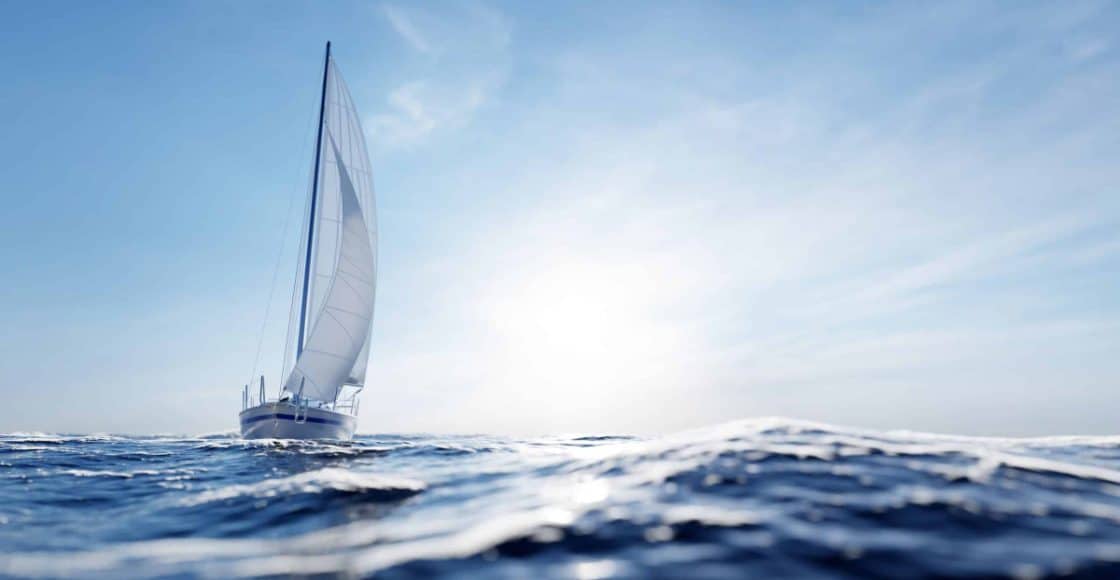
5 Best Ocean Boats
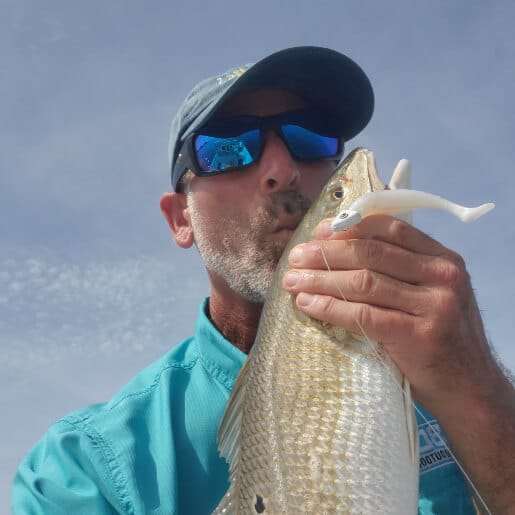
Table of Contents
When it comes to figuring out what type of craft is considered a top ocean boat, it’s important to always remember that ocean conditions vary widely and there will never be a one-size-fits-all answer.
Pro Tip: Your boat needs to be in tip-top shape to be safe in the ocean and no matter the size or type, if it is not mechanically sound and well-maintained, it probably shouldn’t leave protected waterways.
If you’re planning a voyage, consider our five best ocean boat types:
- Inboard Fishing Boats
- Midsize to Large Center Consoles
- Midsize to Large Cabin Cruisers or Yachts
- Some Catamarans (Power or sail)
- Cruising Sailboats
Rent. Charter. Share— Only at Boatsetter
Inboard fishing boats
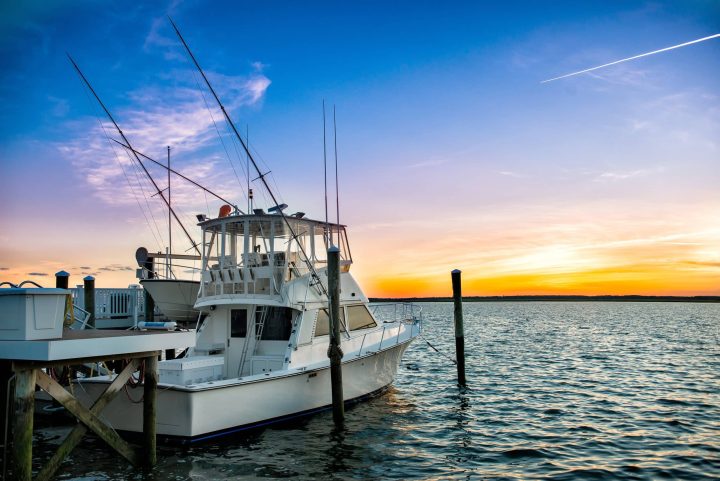
Since outboard power has come to dominate the marketplace among smaller fishing boats, most modern inboard sportfishing boats are large and rugged enough for the ocean. There’s no one specific length you can call sufficient, but 30-plus feet is a good starting point. For many people a great way to get out on the ocean in boats like these is to hire a fishing charter so you not only get the boat, you get a captain with oceanic experience as well.
Midsized to large center consoles
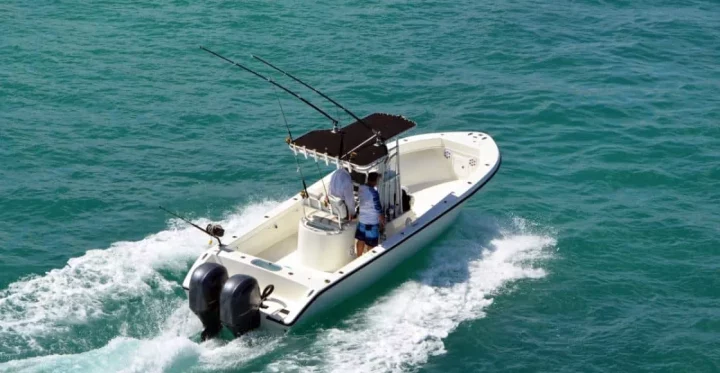
Most larger center consoles carry multiple engines—always a good thing, when you’re going out on the ocean—and have deep-V hulls designed to handle big waves. On calm days most boaters consider it okay to take smaller models into the ocean, too, as long as you don’t stray too far from the inlet.
Midsized to large cabin cruisers or yachts
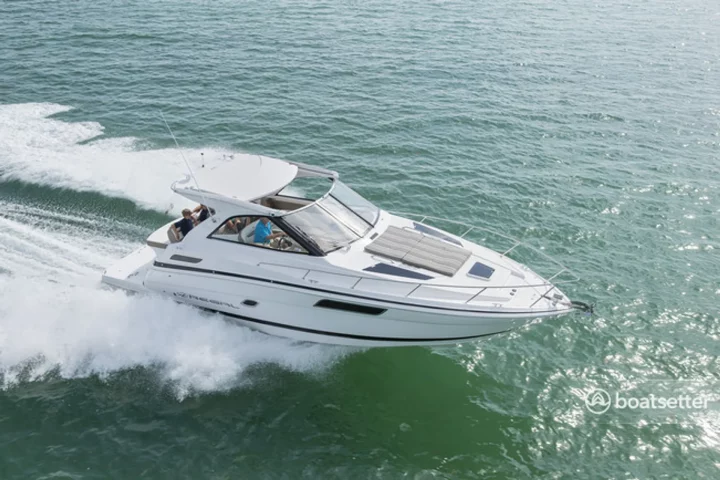
Just about any big cabin cruiser and any boat worthy of being called a yacht can be taken into the ocean. Not all cruisers and yachts are prepared for it—you certainly don’t want to have a set of fine China sitting on the dinette table when oceanic waves start rolling—but most newer models in good mechanical condition can handle a jaunt in open waters.
Some catamarans (power or sail)
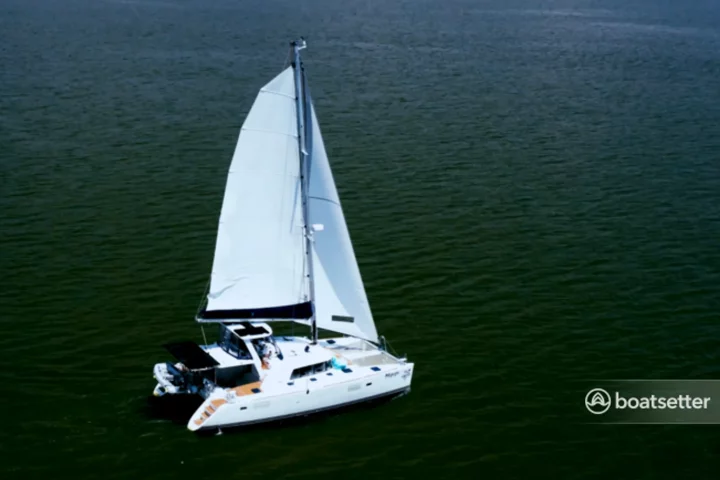
Many catamarans are designed specifically to take on big seas and are appropriate for ocean use, but not all of them. Catamarans designed for long passages or living aboard, be they power or sail, are generally considered appropriate for use in the ocean.
Cruising sailboats
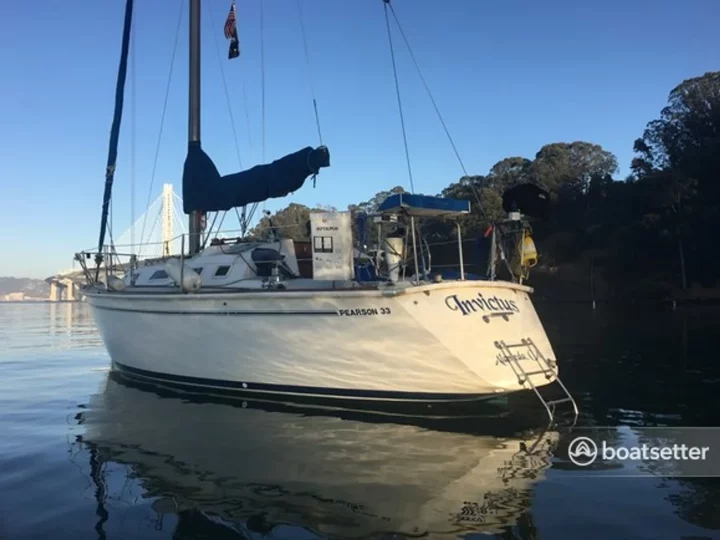
Most sailboats designed for extended cruising are relatively large and can handle fairly significant seas. Even when one is ocean-worthy, however, you do have to remember that sailboats travel slower than most powerboats and will take longer to return to port . This makes keeping an eye on the developing weather patterns even more important, so you can plan your trip appropriately.
Again, remember that each individual boat has to be assessed upon its own merits when determining if it should be taken into the ocean. So use good judgment and keep a close watch on the weather forecast, and your oceanic adventure will be a great one.
Need more answers? We got you covered
What boats are good in the ocean.
The best ocean boats are relatively large and designed to take on open seas. But on a calm day if you stay close to home, just about any boat can be a good boat in the ocean.
What size boat is safe for the ocean?
There’s simply no one-size-fits-all answer to this question. In some conditions, it may be safe to launch something as small as a kayak from the beach and go into the ocean. But in other conditions, even the 60-footers should stay tied up at the dock.
Can any boat go in the ocean?
Pretty much, yes! This is always a judgment call and the answer on any given day depends on a number of variables.
It’s important to understand that the condition of a boat determines whether it’s ocean-worthy or not. One day the ocean could be glass-calm and as smooth as silk, and just about any boat would be fine running through its waters. The next day stormy seas could make it uncomfortable even on a 100-foot superyacht.
No size requirements should be considered hard rules and good judgment plus a look at the weather forecast is in order before setting off into the ocean — regardless of what sort of boat you’re on. Check out Weather Safety Tips for Boaters to learn more about how to gain some weather wisdom as it pertains to boating.
About Boatsetter
Boatsetter is a unique boat-sharing platform that gives everyone — whether you own a boat or you’re just renting — the chance to experience life on the water. You can list a boat , book a boat , or make money as a captain .
List. Rent. Earn— Only at Boatsetter

With over three decades of experience in marine journalism, Lenny Rudow has contributed to dozens of boating and fishing publications and websites ranging from BoatU.S. Magazine to BDOutdoors.com. Rudow is currently the Angler in Chief at Rudow’s FishTalk , he is a past president of Boating Writers International (BWI), a graduate of the Westlawn School of Yacht Design, and has won numerous BWI and OWAA writing awards.
Browse by experience

Explore articles
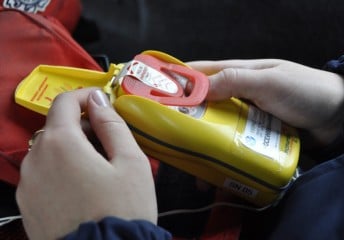
Florida senate approves new boating law, drops anchor on governor’s desk

Boatsetter Owners Tips and Tricks: Improve Your Boat Listing!
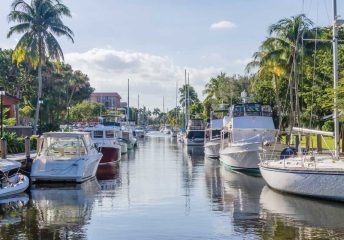
7 Reasons Why Fort Lauderdale Is the Yacht Capital of the World
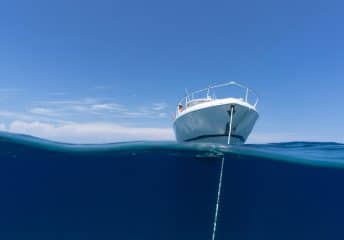
How to Double-Anchor a Boat

Best Sized Catamaran for Ocean Sailing and Liveaboard?
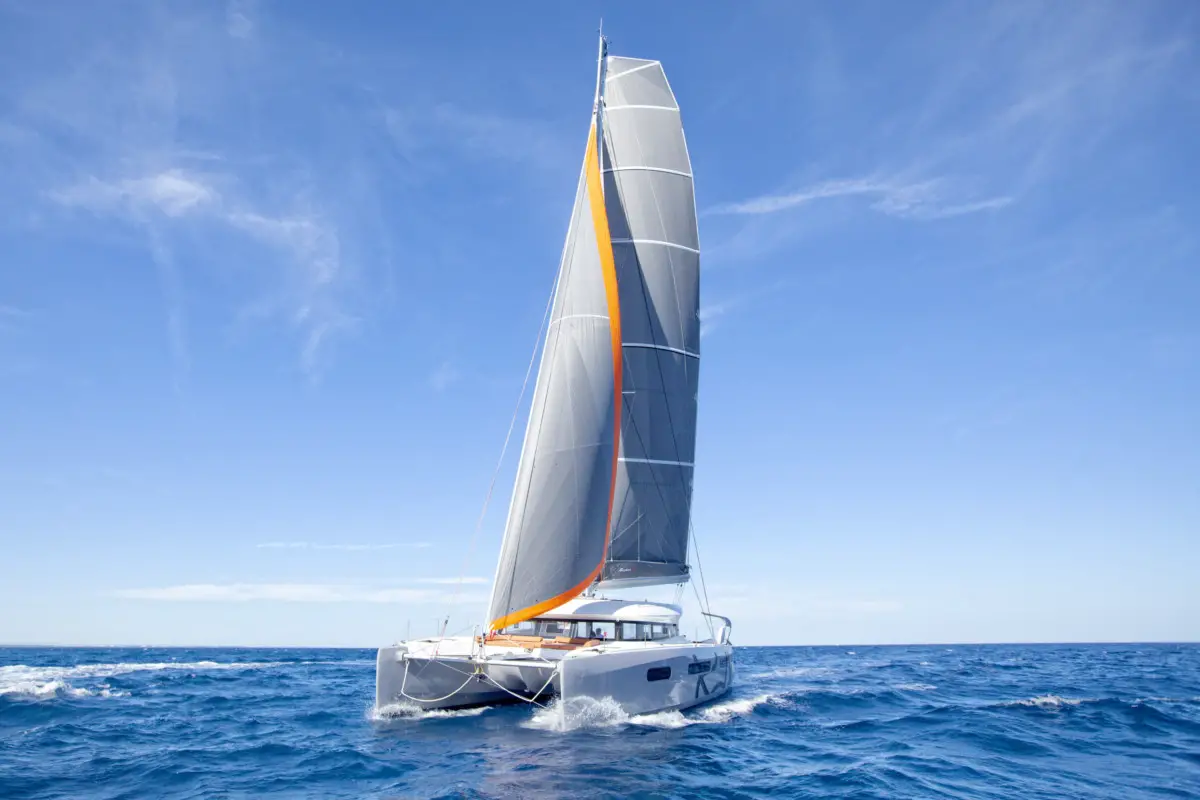
As an Amazon Associate, we earn from qualifying purchases. We may also earn commissions if you purchase products from other retailers after clicking on a link from our site.
Buying a boat is a tricky thing, but once you start figuring out what you’re going to use it for things begin to become more apparent. I’m assuming you’re here because you are interested in knowing how small of a sailing catamaran you can get while balancing factors such as price, length, and space. If so, you have come to the right place!
The perfect sized catamaran for ocean sailing (including around the world sailing) is around 40ft; it is small enough to be sailed by one person but big enough to provide safety and speed. Of course, there are many variables to consider, and below we will discuss many of them.
Before we can decide which one is perfect for our needs, we need to look at all ends of the spectrum: the smallest, biggest, cheapest, and most expensive.
Table of Contents
What is The Smallest Sized Catamaran for Ocean Sailing?
The size of the smallest suitable catamaran that can safely, and somewhat comfortably, cross big oceans is according to consensus in the sailing community, around 30ft. It is possible with less, but a smaller boat has some real downsides, which I will discuss below .
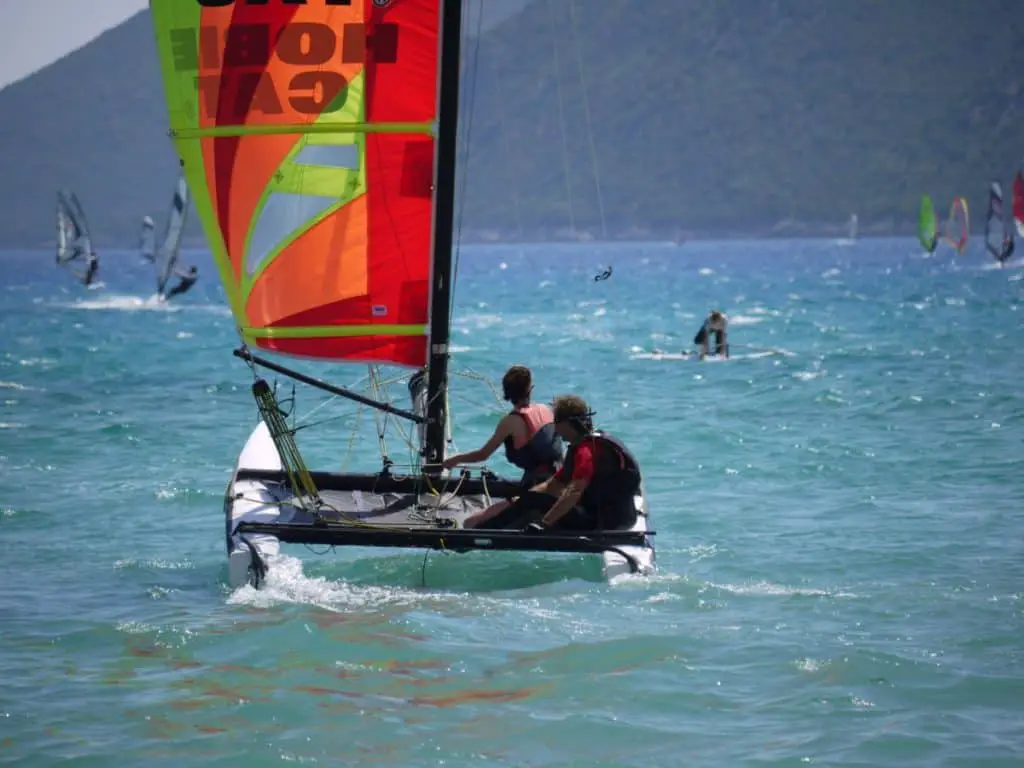
Anything smaller than 30ft is starting to become too much of a tradeoff. When it comes to dealing with huge waves and strong winds, size is an issue. Too small of a catamaran and every wave appears as a mountain.
It also has a significant effect on the crew; if the boat is never at rest always pitching and yawing it really takes its toll on the team, this will sooner or later impair the crew’s ability to make the right decisions, something that is a must in a situation of crisis.
One of the most significant issues with small catamarans is the low bridge deck clearance; most catamarans make some noise when sailing upwind. These loud noises are due to waves coming towards the boat only to get projected with high speed and force straight into the deck’s underside.
This makes for massive noise and vibration, something that isn’t dangerous but adds to the crew’s fatigue while also making for a horrible trip. There are really only two things that you can do to prevent bridge deck slamming, either you get a big boat with a high bridge deck clearance (more on that here) or you sail downwind.
Usually, fitting all the gear you need for a long trip on the boat is not an issue. But there might be a problem with balancing the ship once you have filled it with all that weight, having weight too far out on either the bow or the stern is a safety issue and can lead to unnecessary pitching and in a worst-case scenario make you dive right into a wave instead of staying on top of it.
Why is a Bigger Catamaran Better For Sailing Around The World?
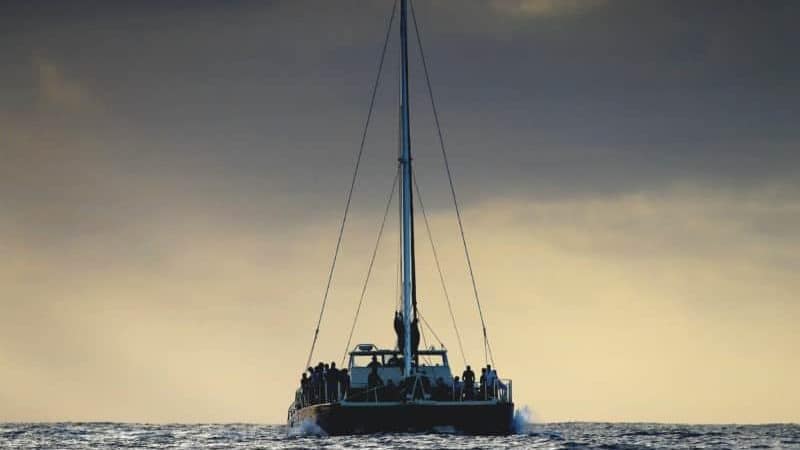
Having a bigger boat offers a lot of advantages, some of them are;
Speed is not only fun, but it is also something that adds to the safety of the trip. If you’re doing ten plus knots instead of just five, that means you will only need half of the time at sea, and if there is a storm on the way, you definitely want to get into safe harbor before it strikes.
It also means that you could “outrun” or at least out-steer a storm, so speed gives possibilities and therefore, safety.
Another aspect of speed is how much fun it is:
“Sailing my old 35ft monohull, it was always a slug, slow and steady wins the race they say, we won nothing but boredom, and when you realize that your speed is so slow that on an average jog you would easily outrun your boat, that sucks.” Gabo
But when you are starting to surf waves and semi-plane, it’s a whole different world; it’s exhilarating, and you go from thinking when is this horrible experience over to thinking, let this never end!
Getting a bigger boat also means a lot more space , and that means more places to store all the fun stuff you want to bring, scuba gear, snorkels, surfing boards, and other fun stuff. Having a smaller boat might mean you won’t have space enough to fill up your dive tanks, so you miss out on many great opportunities.
Another aspect of space is the problem with headroom if you are a tall person and/or you want to bring tall friends onboard then having a saloon where you don’t have to hit your head on the ceiling is a significant factor, and to be honest small catamarans usually don’t have this. This is often not a big issue for short trips, but going on a cruise for multiple days, being comfortable is a big thing.
And speaking of bringing friends along, a bigger boat equals more berths , the bigger ones (40+ft) have full-sized rooms with large beds that are so comfortable that not even grandma will complain, so if you don’t want her to stay for too long, you should probably get a smaller boat.
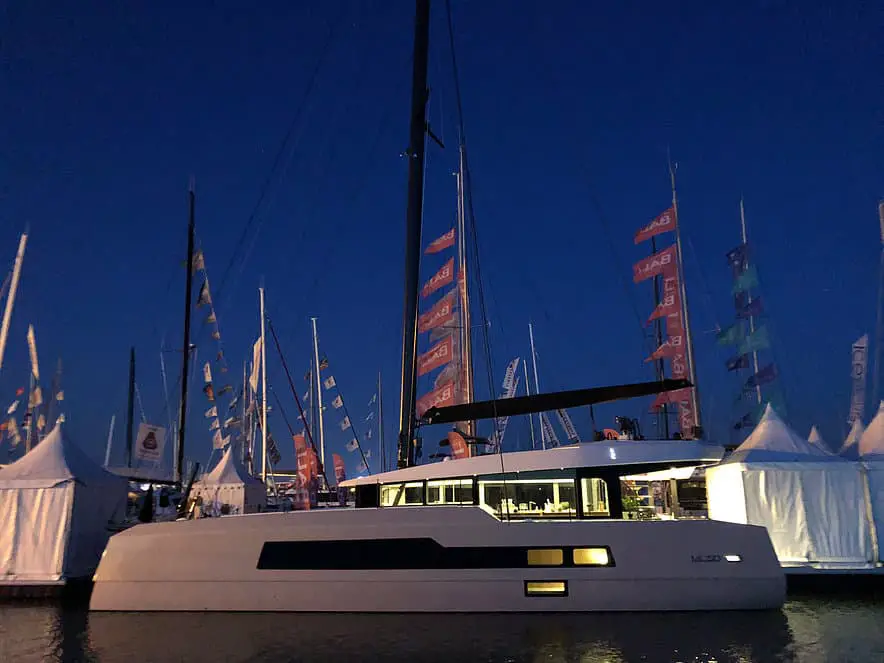
What Sized Catamaran is Too big For Ocean Sailing?
A too big of a catamaran is for most sailors anything longer than 45ft, more specifically a boat which is too expensive, something you can´t handle on your own and that has more space than you need .
This once a little more tricky, a general rule of thumb for many is that you should be able to sail it on your own because you might have to sooner or later.
Bigger boat means sails that are harder to raise and sometimes only possible with an electric winch and having too much electrical stuff are for many a big NO GO. for me it’s not a big deal, just make sure you are able to repair it if it breaks, just like any mechanical system.
A bigger boat means more sail area, which usually means more power, which means higher speeds and sometimes a bit more complicated to handle for a beginner. Make sure you try to get a boat that you are comfortable handling and know precisely how and when to reef.
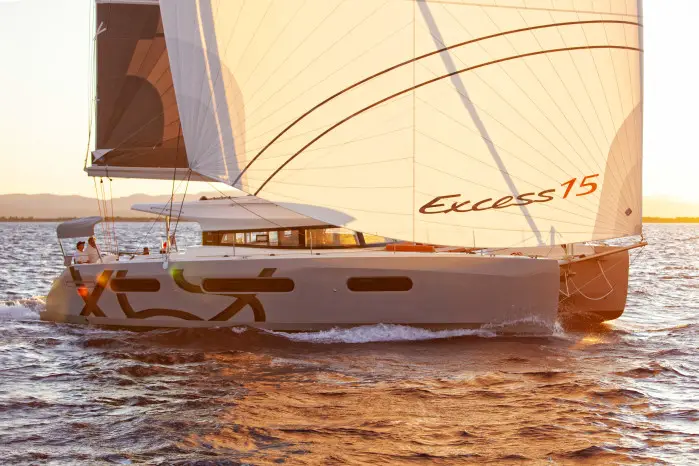
Since catamarans don’t heel ( more on that here ) they offer handling-feedback a little bit different, for example since they don’t have deep keels and don’t lean to their side they tend to almost “sit down “a little on their leeward side (the hull of the lee side of the boat).
This sensation can be a little bit awkward at first but is something that the catamaran captain needs to get used to if he or she wants to understand how to properly reef and maintain the sails. If this is not correctly done the catamaran might be at risk of capsizing .
For most people, anything over 45ft is just too much to handle short-handed.
Balancing Price and comforts
*Exponentially higher costs since the amount of stuff you have to do usually exceeds the time you will have to fix it. Let’s use bottom paint as an example, you can do it yourself trying to save some money, but since the boat is soo big, you’ll end up spending a lot of work hours painting.
And every day spent hauled out is expensive (especially for such a big boat), so trying to do it yourself might even be more costly than hiring a few workers (since if you are the only one working on the ship it needs to be hauled out for a longer time).

Potential Income From a Bigger Boat
When it comes to the potential income I would argue that the bigger boat you have, the more money you can make, not only could you attract high-paying customers since now you are offering luxury yacht sailing instead of low-end stuff aimed at backpackers. This could be a massive resource of income.
I tried taking people out on my boat, but since it was quite small and not even close to what someone wanted to pay a lot of money for, it didn’t really generate much money.
If you find yourself staying at a marina for a longer time and having a couple of berths available, you could AirBnB those to out to people in the area . This is a great way to make some extra income, and it’s also a great way to make some friends. I would definitely recommend this!
Bigger boats also mean the possibility to have a larger paying crew, instead of not being able to take a single crew person, on a 43ft you could have seven people both working and paying to stay at your boat. That’s a sweet deal and a lot of fun!
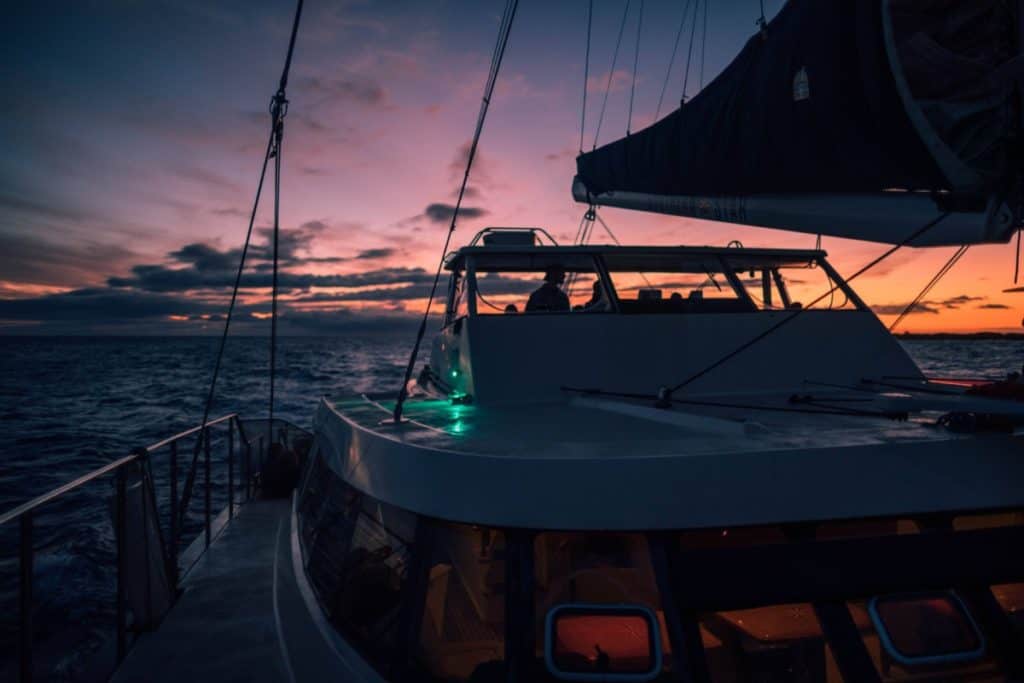
Bigger Boats = Higher Expenses
Size matters; nothing is more accurate in the boating world, but when it comes to the amount of expenses and the size of your pride.
Haul out and placing on stands when it’s time for your repair and maintenance should be thoroughly planned and executed. This is a good tip since you will most definitely pay by the length of your boat, and if you are sailing around in a catamaran, be ready to pay a premium, many times 25 – 50 percent more than the standard price per foot.
So before you take your boat out of the water, make sure you have a solid game plan that includes a rigid timeline of when the contractors should arrive, what the different phases of your maintenance will be, and then push hard to execute according to plan.
If you do it this way there is a lot of money to be saved, what you don’t want to happen is that you have four contractors ready to get to work, but you haven’t bought the paint or the gear needed for the repairs, so they are just sitting around and costing money.
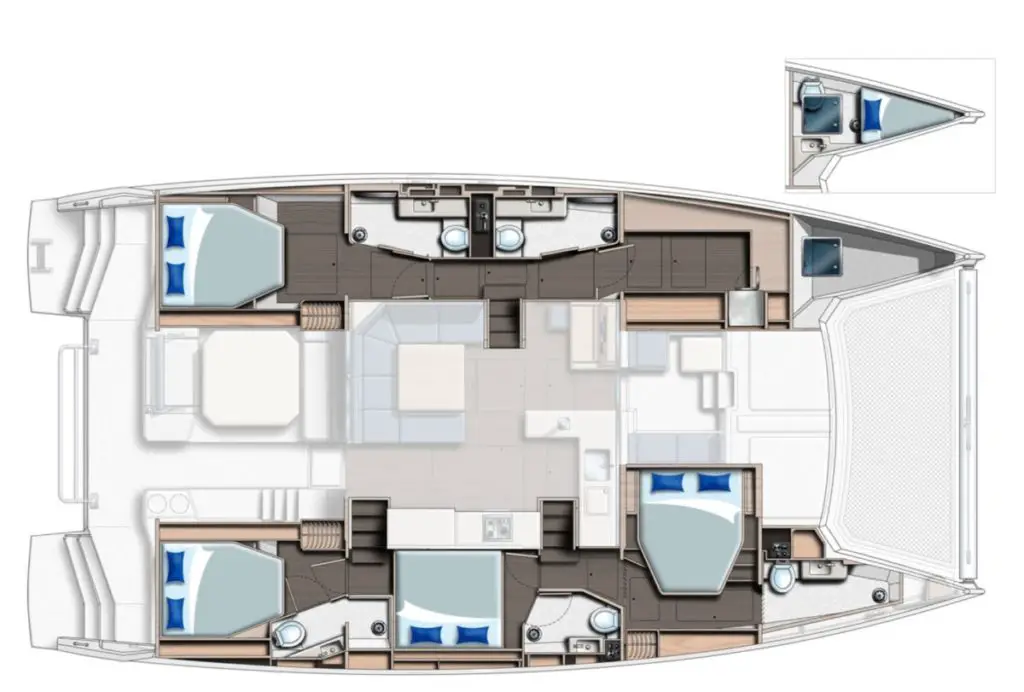
The Best Sized Liveaboard Catamaran
Most ocean-capable catamarans are also more or less suited for living aboard. This means that the best-sized liveaboard catamaran should be around 40-45ft.
When it comes to long-term living on a catamaran, some things are more important than if we only do a single crossing; a liveaboard is about enjoying your house on the water.
In contrast, a catamaran made for hardcore sailing is more about speed and excitement.
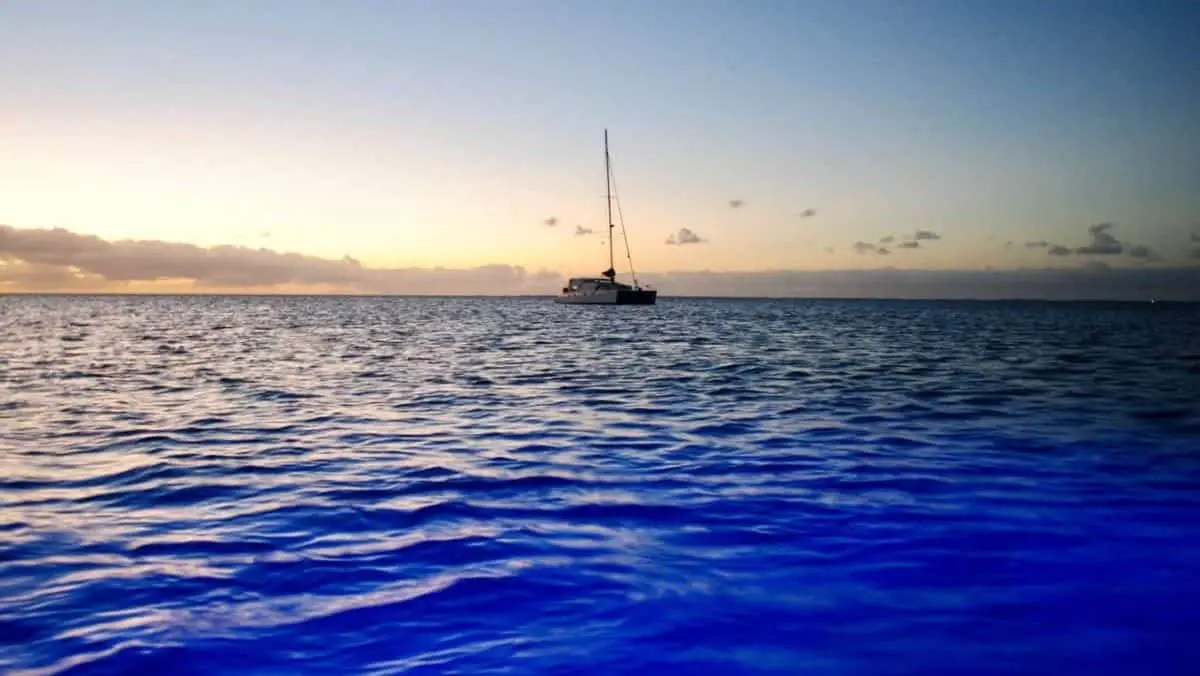
Liveaboard-demands usually include a lot of space to store your stuff, wide hulls with large-sized berths, and for many getting a used charter boat is the right decision. Beware when buying an old charter boat that they are usually made for coastal waters, and not all are suited for offshore multiday sailing.
Living on a boat means you will spend a lot of time doing the usual stuff you would also be doing in an ordinary house, including cooking cleaning, and working.
Once you understand your needs there is a better chance you can find a boat that will suit your needs in the long run. Catamarans in the “cruising” category usually have a lot of space to store gear, this means that they have wider hulls.
Having wider hulls creates more drag and will hinder the boat from going as fast as a catamaran with narrow hulls ( Check out catamaran hull speed explained ).
But having these hulls will greatly improve your comfort since it allows for wider berths(beds) and a boat that is easier to move around in, this might sound like a small thing and you might think that it’s not a big deal. But…
After a couple of weeks sharing a few square feet, every time you bump into someone or something will be a little annoying so I cannot be frank enough when emphasizing how important internal space is when it comes to comfort but also staying good friends with your crew.
If you have an online job, or maybe just a job that you can do from your computer there might also be a need to have a desk or room that is relatively separate and quiet so you can get some work done.
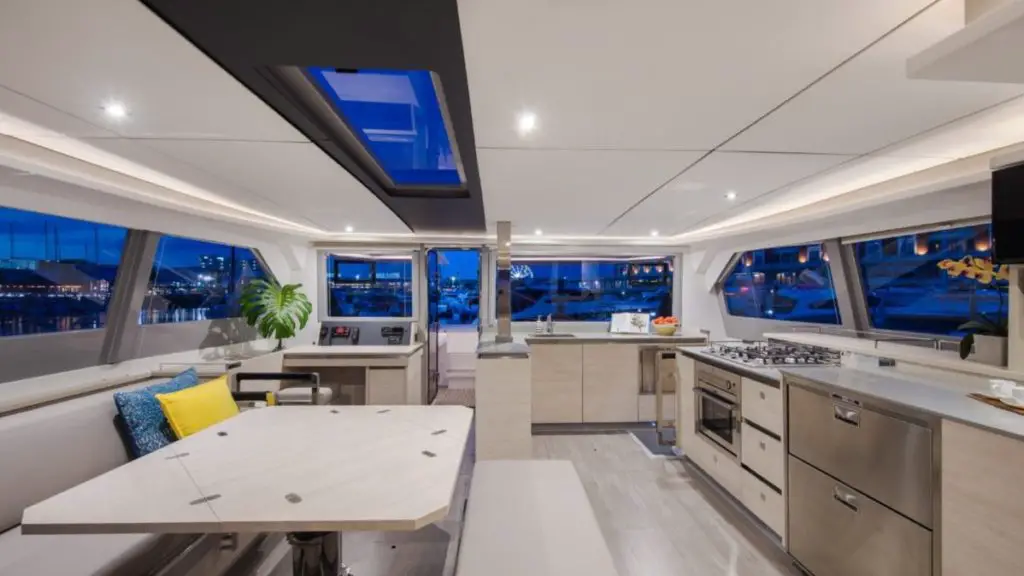
Cruising, Liveaboard, and Ocean Crossing. Guidelines on How to Choose Your Catamaran!
To summarize this article I have put together a shortlist of guidelines that you can use when scouting for a suitable catamaran.
- What is the smallest I can go that still satisfies my needs? This is a great question to ask yourself because, as you have seen above, the smaller you can go, the more money you can redirect into outfitting the boat in a way that you want.
- In a situation where your the only one in “sailable” condition, will you be able to handle the vessel single-handed? Out of a safety perspective, this is very important since you might have to do a man overboard maneuver on your own. This is also a question that only you can answer. If you have a lot of experience and are a very confident sailor, maybe you’ll be okay with a 45ft, but smaller is more appropriate for most people.
- How big of a boat can you afford when including the cost of maintenance , repairs, haul out and all other stuff you have to put money into. Don’t forget BOAT really stands for Break Out Another Thousand.
- When it really comes down to it, do you want speed or space ? You can’t have both, unless your filthy rich, then you can have both 🙂
Hope you find this useful! Take care!
Owner of CatamaranFreedom.com. A minimalist that has lived in a caravan in Sweden, 35ft Monohull in the Bahamas, and right now in his self-built Van. He just started the next adventure, to circumnavigate the world on a Catamaran!
Leave a Reply Cancel reply
Your email address will not be published. Required fields are marked *
Save my name and email in this browser for the next time I comment.
Recent Posts
Must-Have Boat Gear for Catamaran Sailors!
Sailing is probably the most gear-intensive activity I've ever done; there are so many decisions to be made about what gear to buy now, for tomorrow, and what to definitely never buy. The gear on...
6 Best Trailerable Trimarans For Bluewater and Coastal Sailing
Having a boat costs a lot of money, even when you are not using it, marina fees, etc. And once it is in the water most sailors never go very far from their "home marina" and sailing will be somewhat...

- CREATE AN ACCOUNT
- Boat Cover Finder
- Bimini Top Finder
- Boat Propeller Finder
- Engine Parts Finder
- Anchor & Dock
- Watersports
- Clothing and Footwear
- Engine Parts
- Cabin and Galley
- Covers and Biminis
- Electronics
- Paint and Maintenance
- Pumps and Plumbing
- Anchor Chains & Ropes
- Boat Fenders
- Boat Mooring
- Boat Protection
- Dock Storage & Protection
- Ladders, Steps, & Platforms
- Top Sellers

- Fishing Rods
- Fishing Reels
- Fishing Rod & Reel Combos
- Fishing Tools & Tackle Boxes
- Fishing Line
- Fly Fishing
- Fishing Bait & Fishing Lures
- Fishing Rod Holders & Storage Racks
- Fish Finders, Sounders & Sonar
- Trolling Motors
- Fishing Nets
- Fishing Downriggers & Acessories
- Fishing Outriggers & Acessories
- Fishing Kayaks
- Fish Cleaning Tables

- Inflatable Rafts
- Paddle Boarding
- Paddles & Oars
- Wakeboard, Wakesurf & Ski
- Wakeboard Towers
- Tow Ropes & Handles
- Life Jackets & PFDs
- Snow Sports
- Roof Racks, Carriers, Dollies

Men's Clothing
- Accessories
Men's Footwear
- Atheltic Shoes
- Water Shoes
Women's Clothing
- Dresses & Skirts
Women's Footwear
- Fuel Systems
- Sacrificial Anodes & Zincs
- Generator Parts
- Inflatable Boats
- Propeller Parts & Accessories
- Boat Manuals
- PWC Parts & Accessories

- Fishing Boat Seats
- Offshore Boat Seats
- Ski Boat Seats
- Pontoon Boat Seats & Furniture
- Boat Seat Pedestals & Hardware
- Boat Seats by Manufacturer
- Boat Tables & Hardware
- Boat Seat Covers
- Boat Seat Vinyl
- Floating Boat Cushions

- Barbeque Grills
- Boat Drink Holders
- Cabin Accessories & Hardware
- Boat Ventilation
- Interior & Cabin Lighting
- Marine Teak Products
- Carbon Monoxide & Smoke Detectors
- Binoculars & Telescopes

Boat Bimini Tops
- Bimini Top Accessories
- Pontoon Bimini Tops
- Other Biminis
- RV & Trailer Covers
- Boat Shrink Wrap & Accessories
- Boat Shelters
Boat Covers
- Boat Cover Accessories
- Boat Lift Canopy Covers
- Other Covers
- Boat Wiring & Cable
- Marine Batteries & Accessories
- Marine DC Power Plugs & Sockets
- Marine Electrical Meters
- Boat Lights
- Marine Electrical Panels & Circuit Breakers
- Power Packs & Jump Starters
- Marine Solar Power Accessories
- Marine Electrical Terminals
- Marine Fuse Blocks & Terminal Blocks
- Marine Switches
- Shore Power & AC Distribution

- Marine Audio & Video
- GPS Chartplotters & Accessories
- Electronic Navigation Charts & Software
- Digital Instruments
- Display Mounts
- VHF Radios & Communication
- Marine Radar
- Auto Pilot Systems
- Action Cameras

- Fiberglass & Epoxy Boat Repair
- Boat Paint & Varnish
- Marine Adhesives, Sealant, & Caulking
- Marine Engine Maintenance
- Boat Cleaners & Waxes
- Boat Cleaning Supplies

- Fresh Water Boat Systems
- Bilge Pumps
- Marine Plumbing Parts
- Wash Down Pumps
- Livewell Aerator Pumps & Live Bait Wells
- Toilet & Waste Pumps
- Marine Pump Replacement Parts

- Tires, Rims, & Hub Kits
- Boat Trailer Winches
- Boat Motor Supports & Transom Savers
- Boat Trailer Guides & Rollers
- Boat Trailer Fenders
- Boat Trailer Lights
- Boat Trailer Hardware
- Boat Trailer Jacks
- Boat Trailer Brakes & Axles
- Boat Trailer Tie Downs
- Couplers, Mounts, Hitches, & Locks

- Boat Deck Harware
- Marine Nuts, Bolts, & Screws
- Boat Handles, Pulls, & Rings
- Prop Nut Kits & Hardware
- Boat Cabin Hardware
- Marine Fasteners
- Boat Windshield Parts
- Boat Tubing & Rails
- Boat Mirrors
- Marine Tools & Tool Kits
- Boat Lettering

- Women's Clothing Deals
- Men's Clothing Deals
- Fishing Deals
- Anchor & Dock Deals
- Electrical Deals
- Electronics Deals
- Paint & Maintenance Deals
- Pumps & Plumbing Deals
- Boat Seats Deals
- Trailering Deals
- Camping & RV Deals
- Dealer Login

- Forums Login

- Search forums
- General Boating/Outdoors Activities
- Boat Topics and Questions (not engine topics)
What size boat for ocean cruising?
- Thread starter greid
- Start date Feb 14, 2007
- Feb 14, 2007
I am newly in the market for a [power] cruising boat/yacht that is comfortable with extended ocean trips, like up and down the west coast. I live near the coast of northern california and would like a craft that could take my family and perhaps some friends up to British Columbia, or down to San Diego comfortably. I'm curious what the group thinks is the minimum size for such journeys, and/or what the next step up might be that could really go on the open ocean, say to Hawaii. Thanks in advance for your thoughts and views! Glenn Reid Woodside, CA
- Feb 15, 2007
Re: What size boat for ocean cruising? Glenn, after going down the coast(Port Townsend to Southern California) the ideal boat is a Princess cruise line, or one like it. The west coast of the US is known to be one of the most treacherous bodies of water in the world, The ocean can be very unpredictable, many people claim 45feet or larger is required, many have made the trip in alot smaller boats, pick your weather, plan, know what your getting into, have a well found boat, and good luck. Roman
the ideal boat is a Princess cruise line, or one like it. Click to expand...
tashasdaddy
Honorary moderator emeritus.
Re: What size boat for ocean cruising? the pacific has sunk, BIG boats, and little boats. the bigger the better and several power plants. be knowlegeable of where, and the conditions, you are going. are you going to captain yourself.
Re: What size boat for ocean cruising? Yes. What Tom said. I have taken 16' and 18' Boston Whalers to sea, Ft. Lauderdale to Bimini, but wouldn't consider any other boat that size for that cruise. The design and build quality of a boat makes a lot more difference than size, once you get past a certain size, and the skill of the skipper/pilot comes second. I haven't been offshore on the west coast, so I wouldn't venture to suggest a minimum size, and I am not sure that your definition of "cruising" would match mine.
Supreme Mariner
Re: What size boat for ocean cruising? I've thought about the answer to that question numerous times. You have two issues. Personal safety, and personal amenities. Obviously a properly designed ocean going craft is essential, the bigger the better. But think about your day to day creature comforts for you and your guests on an extended cruise.......... Also, what will you all do with your time day in and day out while cruising? If you are within sight of land you can look at it; but he west coast of the USA look pretty much the same for the most part of it? The open ocean however is just that, day after day of looking at water, water, and more water. I like the idea of letting someone else worry about all that and go on a commercial cruise ship and rent a cabin with a shower, and maid and laundry service. My 2c Mark
Fleet Admiral
Re: What size boat for ocean cruising? For extended blue water cruising you beter think sail and not the off shore day sailers either.
Re: What size boat for ocean cruising? Wow, you are unanimous and persuasive. A commercial cruise ship never appealed to me but maybe there's something there after all! Thanks for all your helpful comments. Glenn
Rear Admiral
- Feb 16, 2007
Re: What size boat for ocean cruising? To go to Hawaii your only hope is a Sail boat or a full size ship as there are no gas stops along the way. Luckly people have made it with a good 25 foot ocean going sail boat, but very hard to predict the weather far enough in advance to be sure of a safe trip. Power boats just can not carry enough fuel. UP and down the coast some days a 16 foot open bow is all you need. Other days a 96 by 28 foot full closed deck with 3 CAT Deisels and lots of balest is not enough. This boat lowest deck was 12 feet above the water. i have been on this exact boat while 3 waves went right over the deck and washed almost every thing over board.
rottenray6402
Re: What size boat for ocean cruising? Many fishing boats (commercial fishing) make annual runs from Washington state to Alaska every spring going back in the fall. Most of these boats are in the 40 to 50' range. I personally know a man that bought a 34' Tolleycraft in Seattle and convoyed to Alaska with a group of other boats. He made it with no trouble but said he couldn't hear real good for a few days after listening to twin diesels for a week! I have to agree with the other replies here about a cruise line being the best way to go!
Lieutenant Commander
Re: What size boat for ocean cruising? Boats like this are popular on the West Coast - http://www.horizonyachts.net/core/listing/pl_boat_detail.jsp?&units=Feet&checked_boats=1252853 But forget the hop to Hawaii ! Kelly Cook
Re: What size boat for ocean cruising? I know of just the vessel for you. It is large and stable even in the heaviest of seas. It will reach Hawaii with ease with the fuel on board. Your every whim will be catered for as it has a large crew to serve you. On the downside - it cannot venture into shallow water. It requires considerable space to anchor. Here is a photo: http://www.reagan.navy.mil/ Oh I almost forgot it has extensive defensive and offensive capabilities should you enter water frequented by pirates or other undesirables.
puddle jumper
- Feb 20, 2007
Re: What size boat for ocean cruising? The biggest boat you can buy. As boatist said some days all you need is a small boat and on bad days even the most sea worthy capitains get scared in there 70 footers.Opean water is not something to take lightly.
- Feb 21, 2007
Re: What size boat for ocean cruising? Tommays, I always wondered what it would be like to work on one of those yachts. Must be a real experience.
- Construction
- Optimisations
- Performance
- Equipment care
- Provisioning
- Keeping afloat
- Precautions

What is a comfortable sized sailing vessel for a cruising couple
What is the issue, why address this, how to address this.
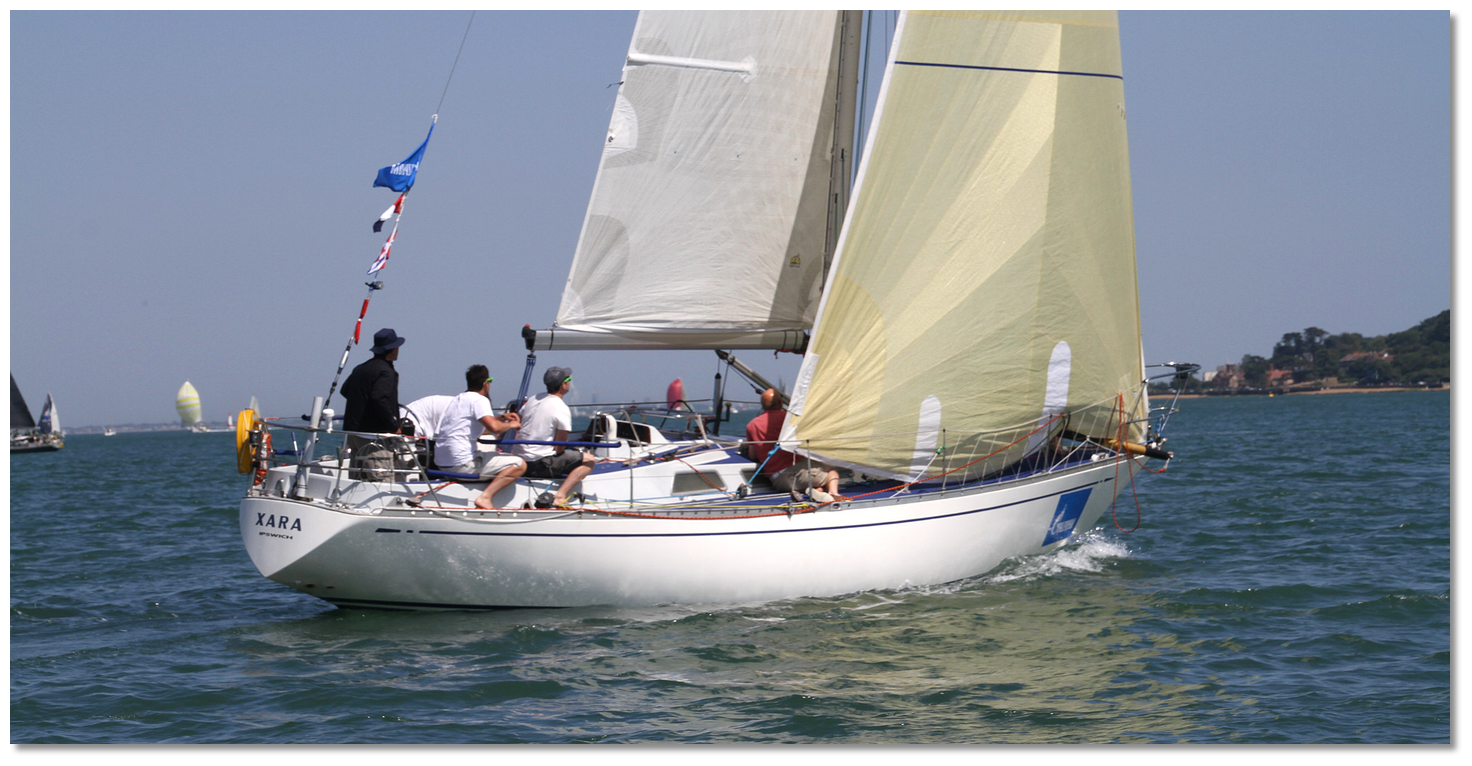
With thanks to:
Add your review or comment:
Please log in to leave a review of this tip.
eOceanic makes no guarantee of the validity of this information, you must read our legal page . However, we ask you to help us increase accuracy. If you spot an inaccuracy or an omission on this page please contact us and we will be delighted to rectify it. Don't forget to help us by sharing your own experience .

- Forum Listing
- Marketplace
- Advanced Search
- About The Boat
- Boat Review Forum
- SailNet is a forum community dedicated to Sailing enthusiasts. Come join the discussion about sailing, modifications, classifieds, troubleshooting, repairs, reviews, maintenance, and more!
22'-24' sail boat ocean worthy?
- Add to quote
Hello again all, I was looking at 27' boats to start on. But people brought up good points basically at my budget 5-7k I will be getting a 22-24' boat in better condition than a 27' boat. A cool thing about these boats is that they are trailer-able. I was wondering if you went on vacation to say cape cod or another beach. Would it be possible to sail this size boat in the ocean as a day sailor? I live on the hudson and it would def be fine here. Just wondering about ocean sailing. Thanks in advance!
It all depends on the boat and the skill of the skipper. I sailed a 22 foot Sea Sprite to England and thought she was just fine and the perfect choice for my first solo trans-Atlantic. What brands of boat are you considering? All the best, Robert Gainer
With good sailing skills, general common sense and a good conditioned boat of that size most boats would be fine for a daysail even on the ocean. Weather would basically be a defining factor here. Common sense, a good weather forcast, knowledge of tides and a good VHF is important and basic knowlege of the engine if any is alway a plus. Enjoy your daysailing. PEACE.
Saurav16- Might want to take a look at John Vigor's Twenty Small Sailboats to Take You Anywhere. There are quite a few boats that are in the 20-30' range and in the $7000-10000 range that are capable of crossing oceans.
Tartan34C said: It all depends on the boat and the skill of the skipper. I sailed a 22 foot Sea Sprite to England and thought she was just fine and the perfect choice for my first solo trans-Atlantic. What brands of boat are you considering? All the best, Robert Gainer Click to expand...
Transatlantic in a 13 1/2' (WOODEN) sloop!! http://i161.photobucket.com/albums/t239/MACHTECH1990/Tinkerbelle.jpg
Yes ...Sabre26...ask him to tell you how he was declared dead in that crossing! El Grande Cojones!!
camaraderie said: Yes ...Sabre26...ask him to tell you how he was declared dead in that crossing! El Grande Cojones!! Click to expand...
Bob...Thanks for your memories! (G)
I'm impressed!.. Did a little bit of googleing, you sir, are the real deal. My hat's off to you and I hope to read/hear more of your exploits.
- ?
- 173.8K members
Top Contributors this Month
- 2024 BOAT BUYERS GUIDE
- Email Newsletters
- Boat of the Year
- 2024 Freshwater Boat and Gear Buyers Guide
- 2024 Boat Buyers Guide
- 2024 Water Sports Boat Buyers Guide
- 2023 Pontoon Boat Buyers Guide
- Cruising Boats
- Pontoon Boats
- Fishing Boats
- Personal Watercraft
- Water Sports
- Boat Walkthroughs
- What To Look For
- Best Marine Electronics & Technology
- Watersports Favorites Spring 2022
- Boating Lab
- Boating Safety

The Best-Riding Center Console Boats for Rough Water
- By Heather Steinberger
- Updated: April 7, 2020
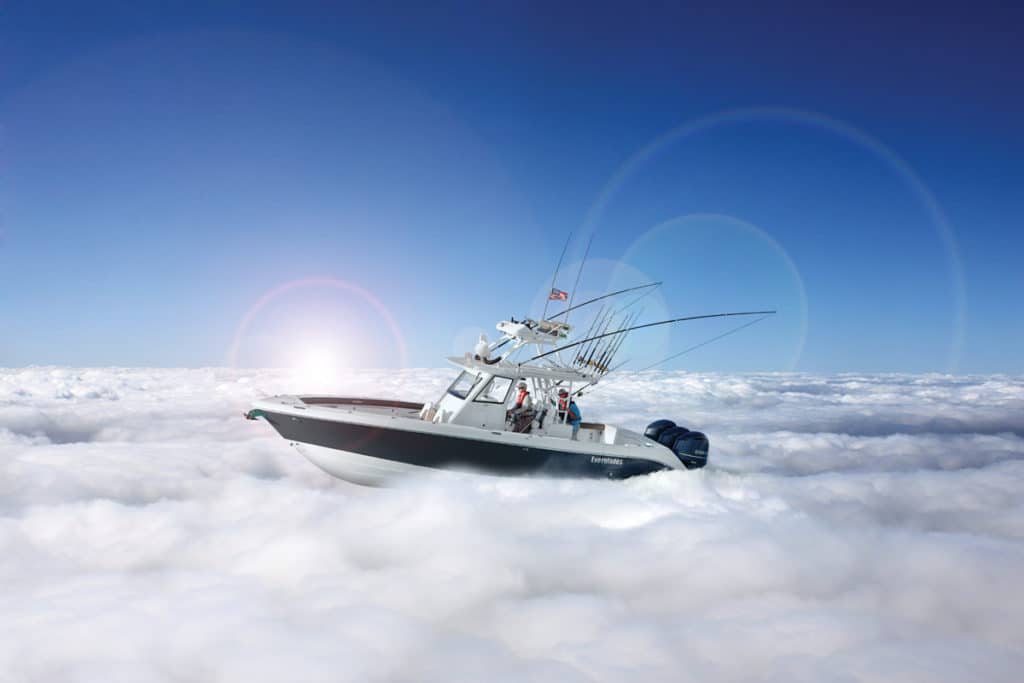
We’ve all been there. A headwind pipes up, and choppy, rough seas dance between you and your destination. You throttle up; you throttle back. You try to help your boat find its comfort zone, and you do your best to quarter the waves.
Inevitably, though, there are those stomach-dropping lurches and the slamming that clenches your muscles and rattles your dental work. Despite your best efforts, you can’t ignore the bangs down below, the ones that make the hull shudder. The ones that make you fervently hope that everyone involved with building this boat did a good job.
That’s a rough ride, even for a rough water boat. And it has happened to all of us, so let’s be honest. Not every boat can provide a soft, smooth ride in snotty conditions, no matter what the glossy brochures say.
We asked three prominent boat designers, and their answers provided much food for thought — regarding how to choose a vessel that’s going to provide a smooth ride, best boat for rough seas, the compromises and trade-offs inherent in your choice, and whether a smooth ride is even what you should be looking for in the first place.
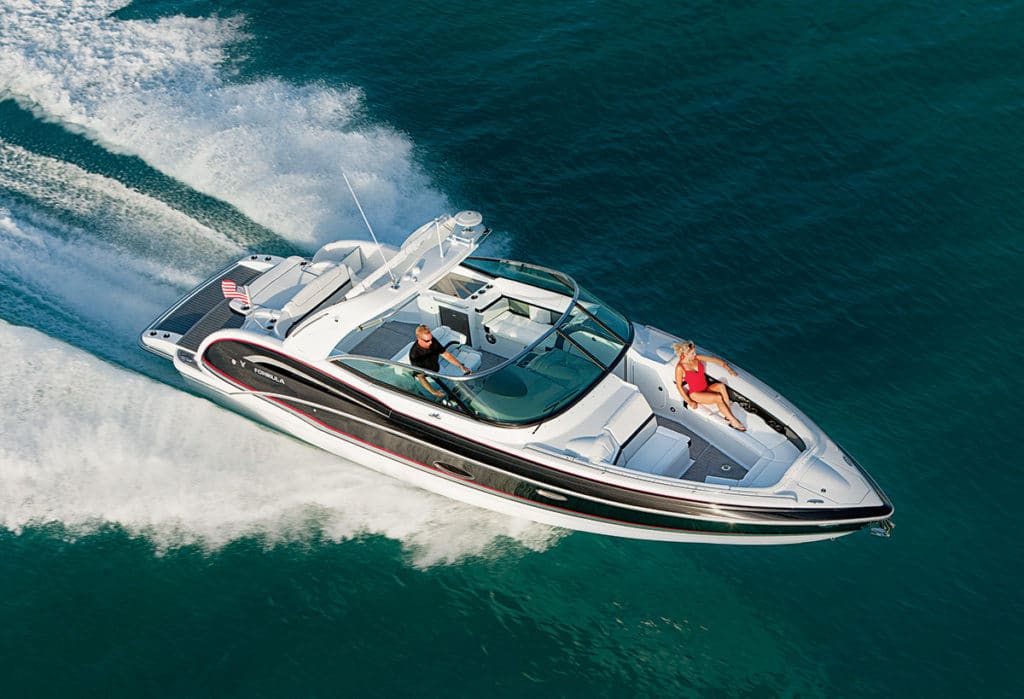
Comparing Displacement and Planing Boat Hulls
Dave Gerr founded New York City-based Gerr Marine Inc. in 1983. He’s designed a broad range of recreational boats and commercial vessels, both monohull and multihull. When it comes to designing a soft-riding hull, he immediately pointed out that there are different sets of criteria for displacement hulls and planing hulls.
Displacement hulls, he noted, don’t pound the way a planing hull will, so they automatically provide a softer ride. To maximize this, designers need to ensure three things: a good roll time, good heave characteristics and deadrise forward.
“For the roll time, we have a formula,” Gerr said. “Every boat has a natural roll period, which is 1 to 1.1 seconds times the boat’s beam in meters. If it’s slower than that, you’ll get that drunken motion. If it’s faster, it’s going to feel snappy and uncomfortable.”
For example, a boat with a 6.7-foot beam ideally should have an approximately two-second roll time. And, Gerr added, a reasonable deadrise forward will make the vessel even more comfortable.
The formula for heave, however, is more complicated. It involves the weight of the boat and the water plane area. The lighter the boat is, and the greater its water plane area, the greater the heave motion will be.
“A wide boat with a large water plane will bounce up and down violently,” Gerr said, “but if you have a small water plane compared to the boat’s weight, that heave will be slow. If it heaves too slowly, you’ve got a wet boat.
“You want to have your roll time and heave in the target region, and then add that deadrise forward,” he continued, “so you won’t have pounding in chop.”
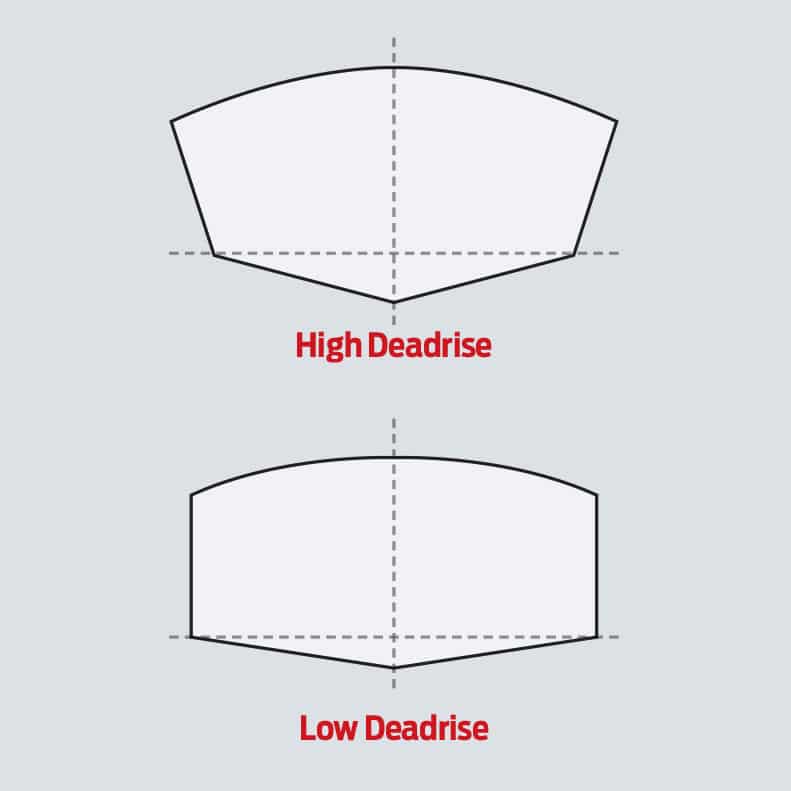
For a planing hull this is hard to achieve. By nature, these hulls are snappy and heave more while trolling or drifting; planing cancels that out, but you can still pound.
“What you really want is more deadrise,” Gerr said. “Just remember: The greater the deadrise, the slower the boat [for the same weight and engine]. That deep-V hull is going to need more power.”
A designer, he said, has to juggle power and what is good deadrise on a boat for optimum comfort.
“You put a deep, high deadrise at the forefoot to get the boat to lift its bow out of the water, or you’ll have steering problems,” he said. “You design it so it planes higher, and then you control it with trim tabs so you won’t trip over that forefoot.”
Deadrise is a difficult thing to visually assess at a boat show or in a dealer’s showroom, so how can a boater ascertain if a soft ride was a design priority? Gerr said the length-to-beam ratio is a dead giveaway.
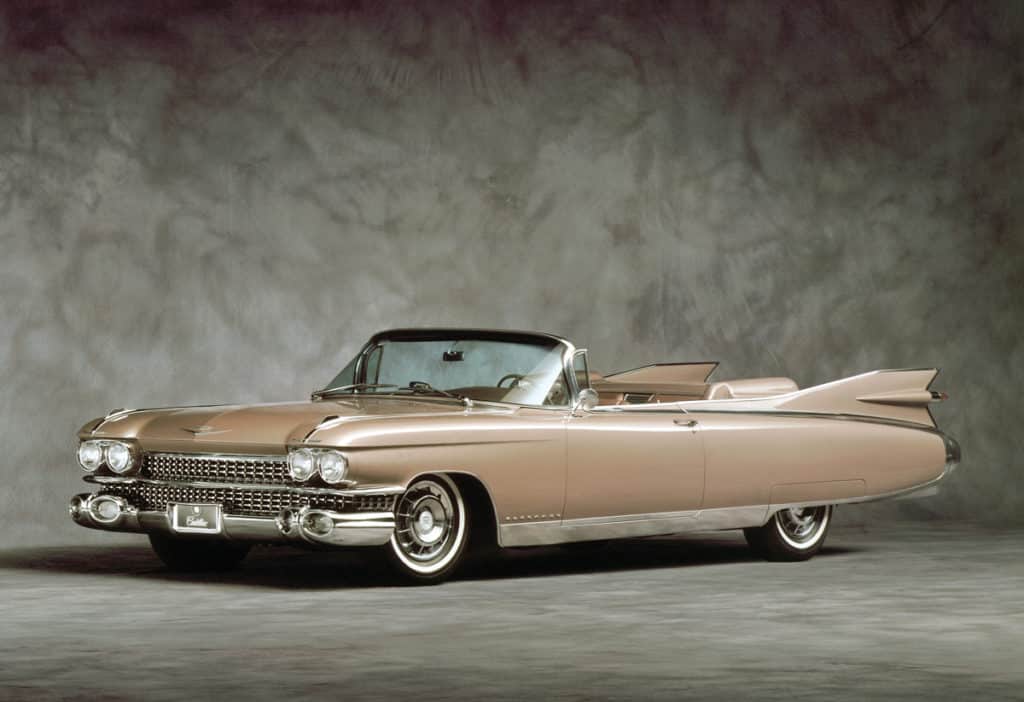
“A long, slender hull is going to have a softer ride, as long as the designer got the roll time right,” he stated. “A wide, shallow hull isn’t going to perform as well. And if you’ve got a high superstructure, you’re going to have increased roll and handling problems.”
Of course, less displacement means it’s a smaller boat inside. You’re going to have to go longer to get the same live-aboard space as that shorter, wider, taller boat next door, but the good news is that your boat is going to be faster and more fuel-efficient than the fat, high version of the same length.
If you are talking deadrise, Gerr said he likes to see a minimum of 17 degrees for offshore boats, although he observed that’s still a bit shallow. Deep-V hulls are considered to be 21 degrees or more. Consider this if you’re looking for the best deadrise for rough water.
“I’d say look for a deadrise of more than 20 degrees,” he advised, “and a length-to-beam ratio on the waterline that is greater than 3.5 to 1. Those two characteristics give you a pretty good idea that the design is intended for a soft ride.”
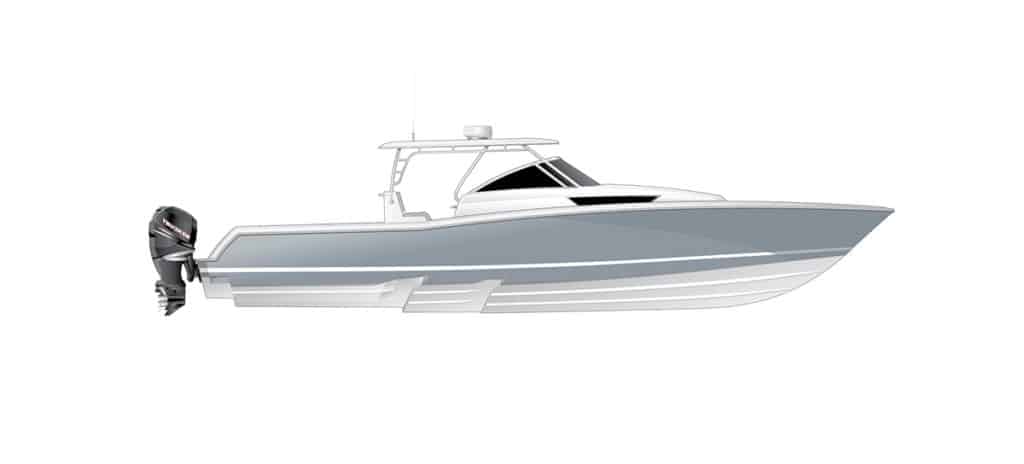
How Does a Boat Hull Handle in Following Seas?
Michael Peters founded Sarasota, Florida-based Michael Peters Yacht Design (MPYD) in 1981. Originally specializing in high-speed boats and offshore racing, MPYD now brings its fusion of performance and aesthetic standards to a wide variety of boat designs. When asked about the search for the perfect soft-riding boat, Peters laughed.
“Think of these ideals: soft-riding, dry and fast,” he said. “Now, pick two.”
The softer-riding a boat is, the wetter it is, because it doesn’t confront the wave. Rather, it splits it. If you want to knock the water down and push it away, then you’ll feel the impact. Boaters clearly need to consider these trade-offs when seeking a soft-riding vessel, but Peters has a more important cautionary tale to share. It’s natural to think of head seas and a soft-riding hull together in the same scenario — but what happens when the boat turns around?
“That’s a different story,” Peters said. “Following seas can pick up the stern, and the sharp angle and deadrise can cause the boat to bow-steer and broach. That’s a much more dangerous situation. It’s uncomfortable to hit the seas on the nose, but it won’t kill you. Boats go out of control in following seas, not head seas.”
Simply put, a hull that is too pointy forward and too flat aft will have an increased risk of broaching. Boaters should look for a hull with deadrise spread evenly — no extremes, such as a professional offshore racing boat’s sharp deadrise throughout the hull. The best boat hull for rough seas must be able to handle following seas.
“If you’re going to have fine forward sections, you’ll balance the hull by putting a lot of deadrise aft,” Peters explained. “You’re looking for recovery, a bow that doesn’t plunge and that can regain its buoyancy in a following sea.
“In our forward sections, we always run a convex section that’s puffed out,” he continued. “Some curvature helps dissipate wave energy and impact. Concave sections look like they’ll provide a softer ride, but they actually focus the energy.”
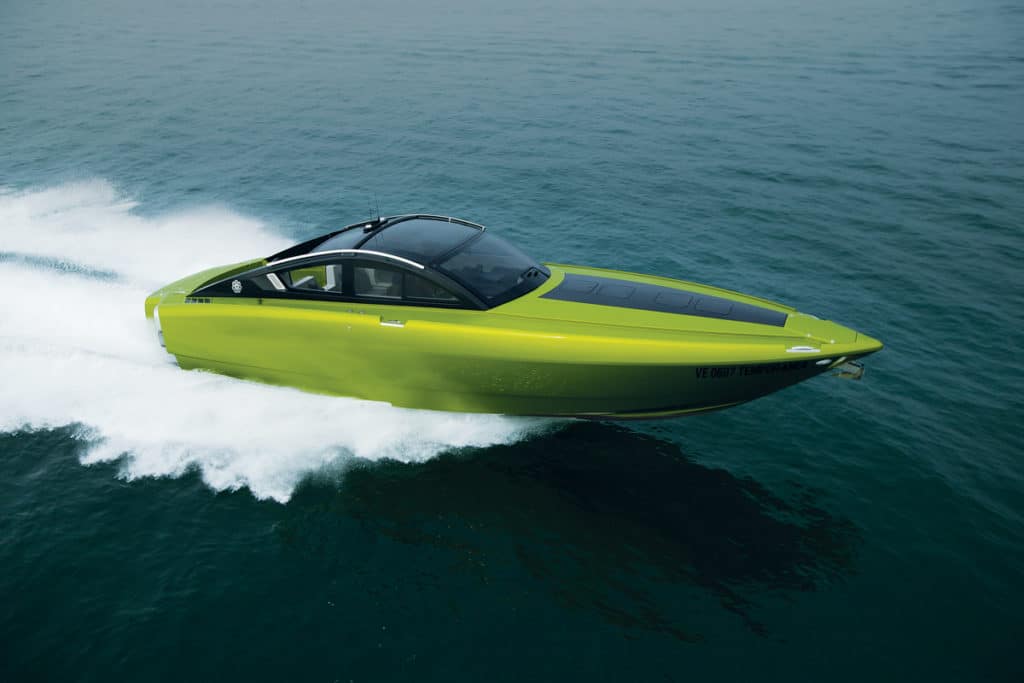
Peters’ advice to boaters is twofold. First, avoid those extremes. They’re not necessary for most recreational boaters. And second, make sure you have a good grasp of where and how you’re going to use the boat. An offshore cruising boat might not be the best choice for a river or inland lake.
“Lakes can be much harder for running a boat than the ocean, where you have long swells rather than steep, breaking seas,” Peters said. “Just make sure you’ve planned for the worst conditions you’ll run in, not the best, and never, ever sign a contract without running the boat in the intended conditions.”
Some boats, he said, are not designed to be the best boat . Sometimes the goal is to provide the best accommodations for the hull’s length and beam, which can mean creating a vessel that has a lot of windage, high freeboard, a high center of gravity and a very wide beam for its length.
“We don’t get to design the best boat in all cases,” Peters said. “No perfect boat? No kidding. But every boat appeals to somebody. One guy might love this particular boat, and he wants that 6-foot-4-inch headroom, while another guy is going to hate the compromises.”
“You always have to be aware that the more you emphasize space, the less boat it’s going to be,” he warned. “And it’s counterintuitive, but what looks good might not be good at all.”
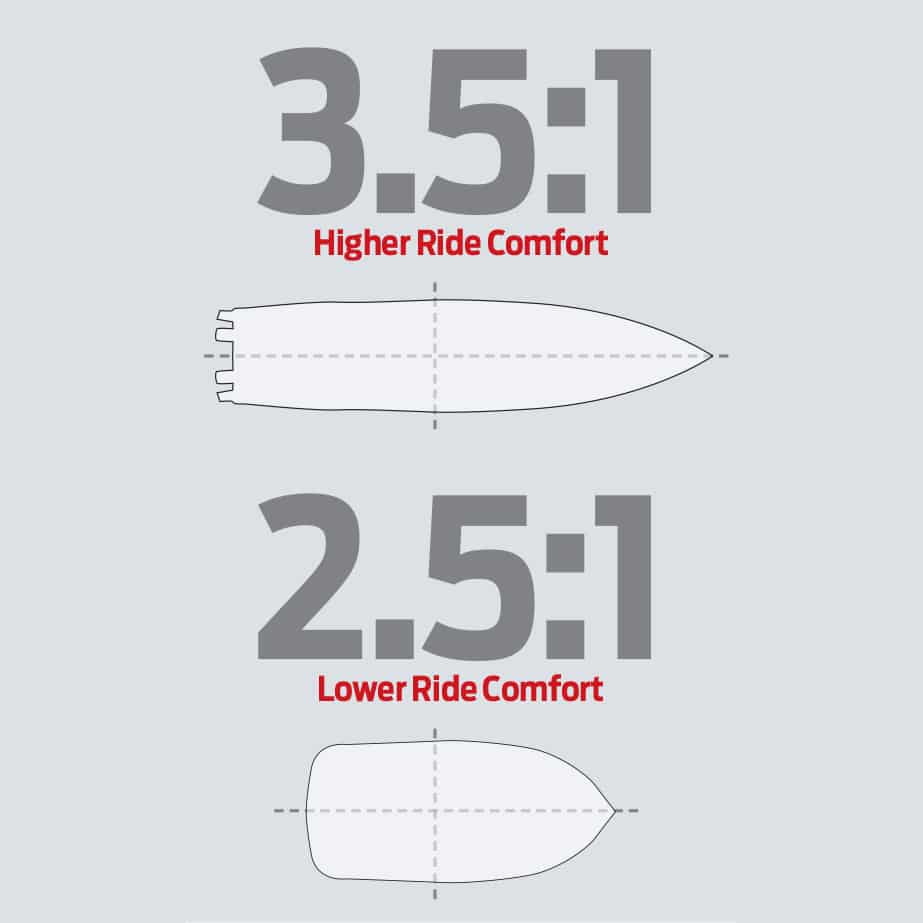
Peters also advised inquiring about a preferred design’s origins. Was it designed in-house at the boatbuilding facility? Was it designed by a naval architect? What are his or her credentials?
“Some people might not care, but it will help you better understand the design,” he said. “With a car, we accept that all the engineering is done correctly, and we can choose our favorite based on appeal alone. With a boat, you should think about engineering and stability calculations, not just styling.”
Finally, Peters noted that good hull designs stand the test of time. With most major advancements taking place in hybrids, like stepped hulls and multihulls, the average boat owner is going to be looking at hull designs that haven’t changed much in 20 or 30 years. And that’s OK.
“Most people just want a good family boat,” he said. “I’d say stay in the middle. The hull should look familiar. That hull from 30 years ago is still a good hull.”
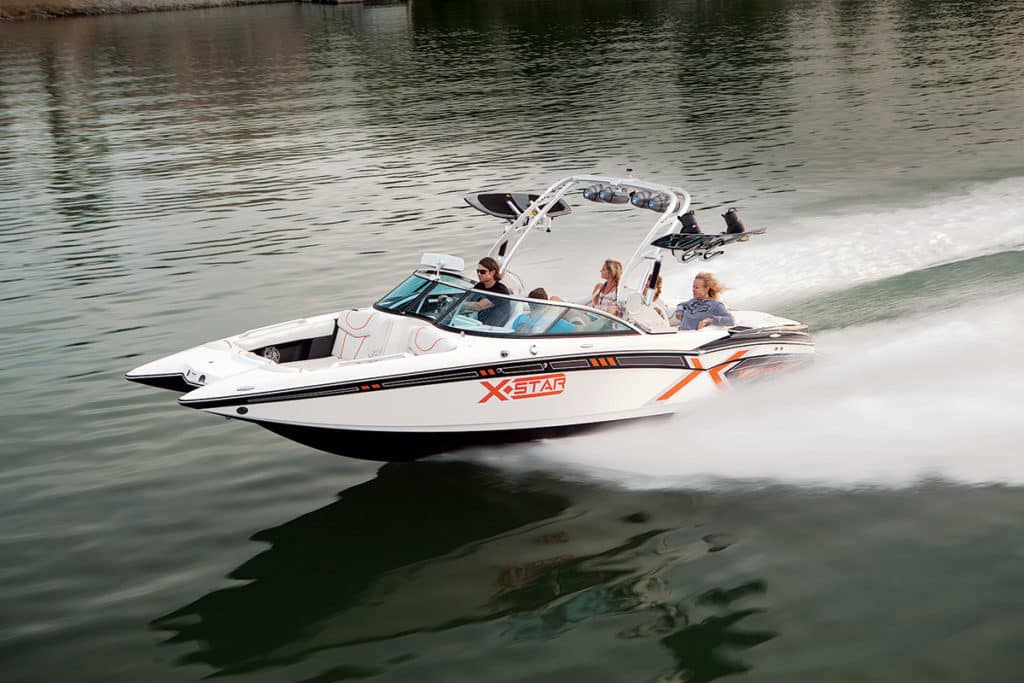
A Boat’s Soft Ride is Subjective
Peter Granata, owner of Palmetto Bluff, South Carolina-based Granata Design , has been designing boats since the early 1970s. With a number of award-winning designs and patented ideas under his belt, he’s firm in his conviction that the soft-ride discussion really shouldn’t be about the boat. It’s about the people involved.
“First of all, the hull ride is felt rather than measured,” he said. “And, it’s based very much on your own individual perception of what the boat looks like and what you expect it to deliver, plus your experience up to that point. It’s very subjective.”
Soft can be a relative term. A boater who is downsizing from a 60-foot yacht to a 30-foot pocket cruiser might find the smaller boat has the worst ride he’s experienced to date, whereas a boater jumping up from a 16-footer will say that 30-footer provides the best ride he’s ever had.
The most important questions a boater can ask, Granata said, are: How well does this design meet its intended purpose, and what can it do for me?
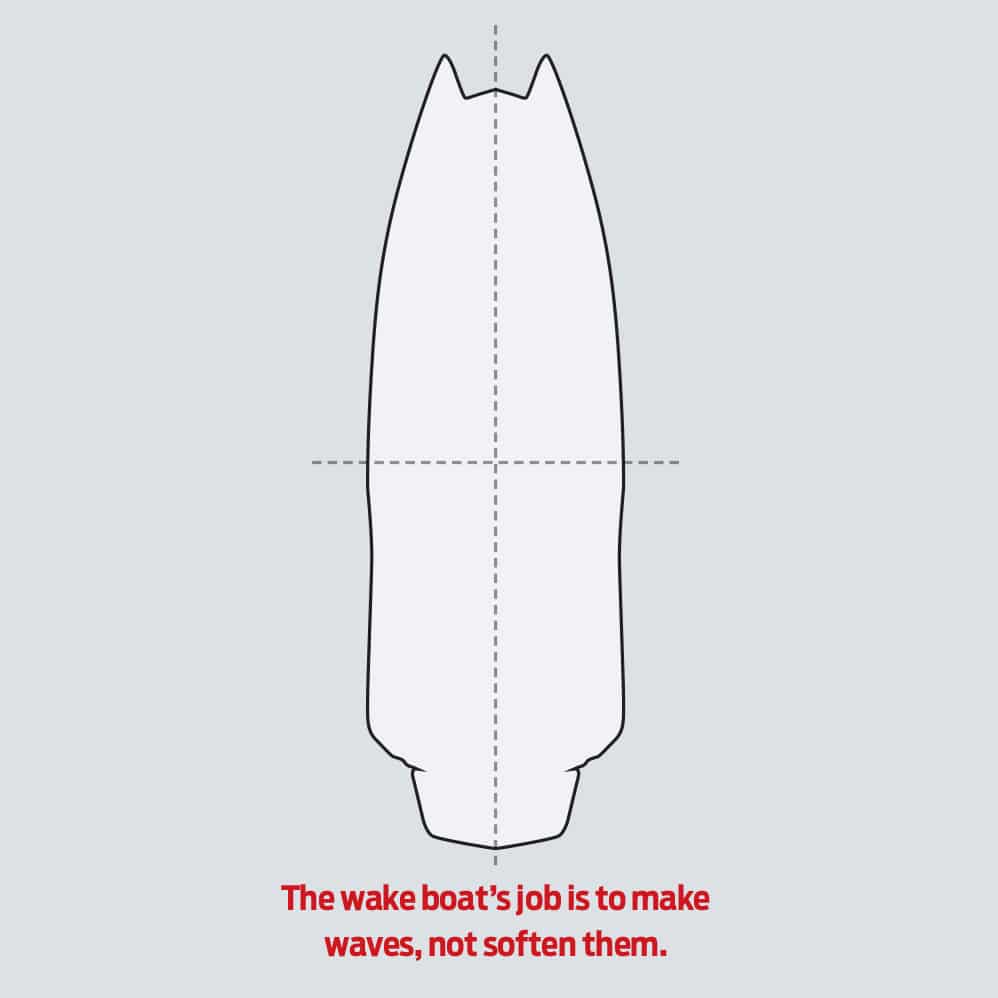
He provided a wakeboard boat as an example. The expectation is for thrills, not the softness of the ride.
“Soft ride is certainly a measurement when it comes to boat design, but it’s not the only one,” he said. “A designer should manage the ride aspect to meet the customer’s expectation. Does the boat do what it’s intended to do?”
The idea is that ride is less important than function, based on customer priorities. If you’re headed offshore and a dry ride is your No. 1 priority, you’ll want to make sure the hull has enough flare to ensure that the water follows the hull and travels outboard rather than over the deck. If you’re an angler, you might look for hull cutaways in the right spots to support the design’s self-bailing characteristics. Bass anglers seek extra buoyancy forward to support their weight.
With “dockominiums,” deep deadrise is unnecessary because owners place a higher priority on stability at rest, accommodations and space for entertaining. And with water-sports boats, the wake is all-important. Without that, the hull is worthless.
“We get so wrapped up in the specifics of hull generation that we forget someone has to buy it and spend time in it,” Granata said. “A designer has to know how the boat will be used, and you do as well. The boat is for you, not for the guy who made it.”
- More: boat building , Boats , Center Consoles
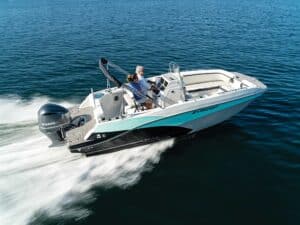
Boat Test: 2024 Starcraft SVX 231 OB CC
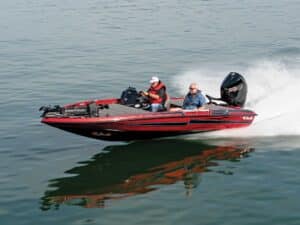
Boat Test: 2024 Bass Cat Caracal STS
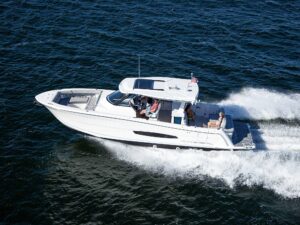
Boat Test: 2024 Regal 38 Surf
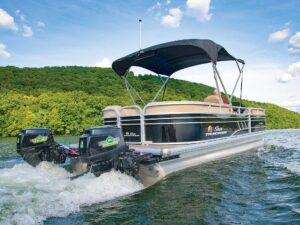
Using Hydrofoils to Improve Boat Performance
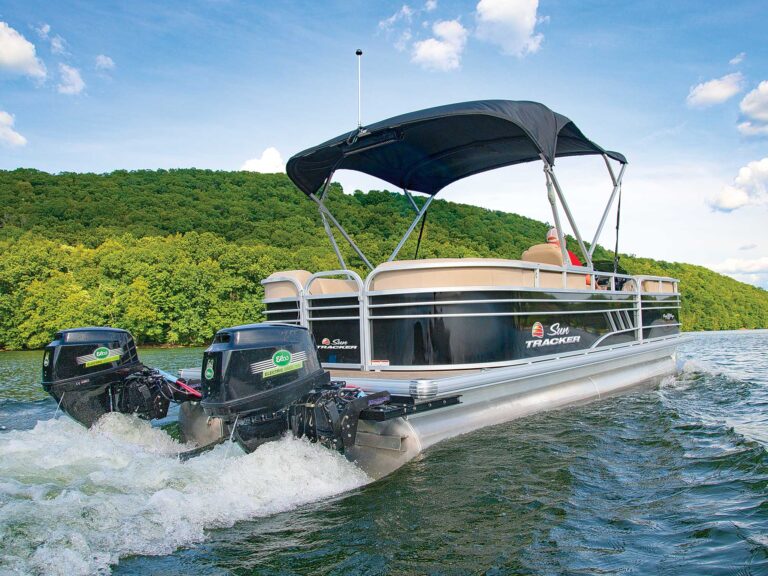
We Test Interlux Trilux 33 Aerosol Antifouling Paint

Boating Shoes for Spring and Summer

MasterCraft Celebrates International Women’s Day With Fourth Annual ‘Let Her Rip’ Campaign

- Digital Edition
- Customer Service
- Privacy Policy
- Cruising World
- Sailing World
- Salt Water Sportsman
- Sport Fishing
- Wakeboarding
Many products featured on this site were editorially chosen. Boating may receive financial compensation for products purchased through this site.
Copyright © 2024 Boating Firecrown . All rights reserved. Reproduction in whole or in part without permission is prohibited.
Best Boats for Ocean Boating
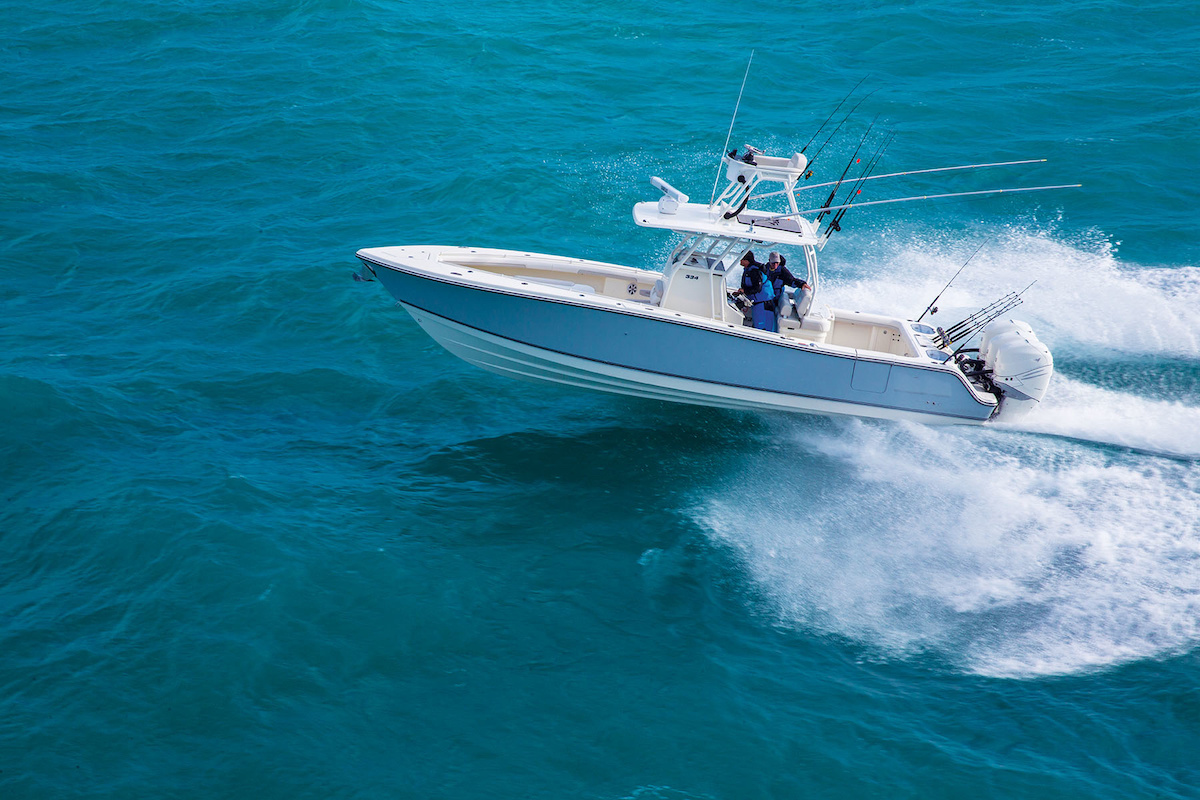
9 Best Ocean Boats
- Cabin Cruisers
- Center Consoles
- High-Performance Boats
- Motor Yachts/Power Cruisers
- Multi-Hull Powerboats (Catamarans)
- Sportfishing Yachts
- Walkarounds
Obviously, this is a wide range of boat types and which will be your personal best choice depends on how you plan to use your boat. If you enjoy saltwater fishing and you dream about hunting down huge pelagic trophy fish, this list of choices shrinks to include center consoles, sportfishing yachts, and walkarounds. But if you just want to go on dolphin- or whale-watching cruises or head down the coast to a new destination, one of the other types of boats will probably be a better pick.
In all of these cases, however, one thing’s for sure: you want to feel safe and confident in your boat’s abilities. To that end, there are some specific attributes any vessel needs if you plan to use it for ocean boating.
Explore Saltwater Fishing Boats
Must-Haves for Boating on the Ocean
First and foremost, any boat that goes through an inlet and into the ocean must be large enough and seaworthy enough to safely handle the conditions .
Just exactly what this means is a judgement call, because boating in the ocean can vary dramatically depending on the location and the weather. Wind speed, sea state, and the potential for storms (see Boat Handling: Riders on the Storm , to make sure you know what to do if you get caught in a sudden squall) all play a role in determining whether or not any boat can safely venture out into the ocean on any given day. That’s why checking the latest weather forecasts and paying close attention to changing conditions is absolutely critical. So, how can one say which are the best boats for ocean boating, in this regard? You simply can’t—the correct answers change from day to day and place to place.
Being properly equipped with safety, communications, and navigational gear is another necessity.
You can check out Boat Safety Checklist & Safety Equipment to see the must-haves as well as recommended safety gear, but in addition, most experienced captains would agree that a VHF radio should be on each and every boat entering the ocean. Naturally you also need to have a full understanding of how to use it; see How to Use a VHF Radio , to get the scoop. And remember that when you’re in the ocean, losing sight of land is almost always a possibility be it due to distance, haze, or fog. In any case you’ll need to be able to find your way back to that inlet, so GPS should also be considered a must-have. In fact, it’s critical for anyone captaining a boat in the ocean to have a firm grasp on how to navigate a boat with and without the assistance of electronics.
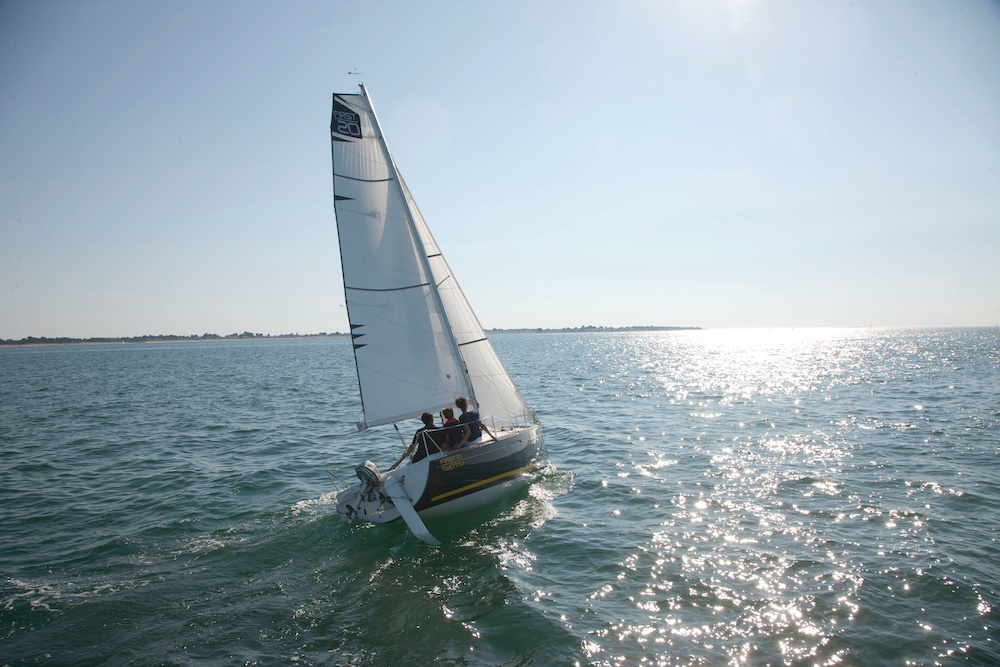
Another critical factor for boats used in the ocean is that they’re designed and built with corrosion-resistant hardware.
Most of the boat types we’ve listed above will have stainless-steel fittings and fasteners, but if you take a boat that was intended for freshwater use and put it in the ocean, you’ll likely have corrosion streaks and deteriorating hardware starting on day one. In just a season or two, serious damage can occur.
Fuel economy and fuel capacity also become important issues to consider when ocean boating.
Remember, the ocean is essentially limitless when you’re on a boat, and while a boat may be perfectly competent to take offshore, some will burn a lot more fuel than others doing so. There are many high-performance boats, for example, that are designed for offshore racing, can handle heavy seas, and are equipped to navigate beyond sight of land. But those big engines need to be fed lots of fuel, and this can mean range restrictions. If the captain miscalculates his or her range, running out of fuel is a much bigger problem than it would be ashore. On the flip side of the equation, some sailboats can travel for literally thousands of miles while requiring little to no fuel. When calculating range for your own boat, most experts advise accounting for a bare minimum of 10-percent of fuel capacity in reserve, and some suggest it’s safest to plan in as much as one-third in reserve.
What are the Best Boats for Ocean Boating?
As is usually the case when it comes to boating in general, the answer to the above question will be different from one person to the next. But we can say one thing for sure: if you have a boat that’s appropriately sized, designed, built, and equipped for ocean boating, you should consider giving it a try. Because the experience of fishing, cruising, or just observing nature outside of the inlet is an amazing adventure that many people in this world never get to enjoy—and that’s one more reason why the boating life is indeed a better life.
Read Next: Best Family Boats
You Might Also Like:
- Best Boats for Beginners
- Best Small Sailboats for Beginners
- When is the Best Time to Buy a Boat?
- The Ultimate Boat Buyer's Guide
- Small Boats: What Are My Options?

Join Our Newsletter!
Get community news, buying bargains, and how-to guides at your fingertips.
Best Sailboats for One Person (With 9 Examples)
One of the most common challenges of sailing is finding the right boat to sail alone. Luckily, there are some good sailboats out there suited for one person. Let's take a look at them, and find out why they're especially good for single-handing.
In this article, I talk about single-handed sailing and look at the nine best sailboats for one person, ranging from small lake dinghies all the way to comfy cruisers capable of oceanic crossings.
Here are the best sailboats for solo sailing
Jeanneau Sunfast 3200
Beneteau oceanis 62, pacific seacraft flicka 20, tartan 3700, hunter channel 31, j boats 109.
Now let's look at them in detail so that you can choose the one best for you.
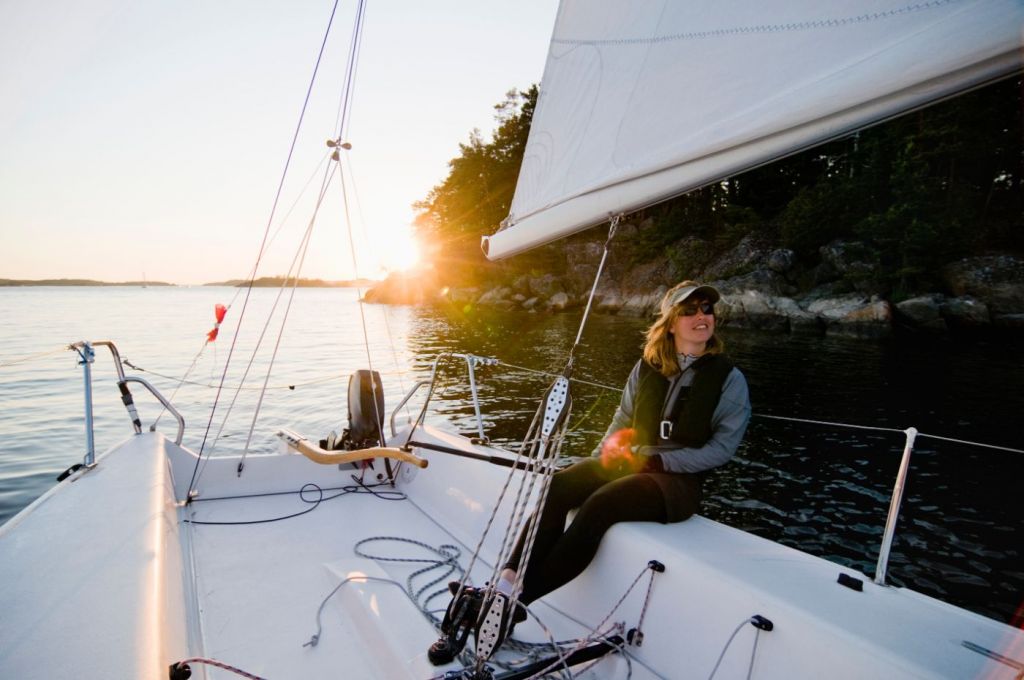
On this page:
What you need for short-handed sailing, features of a good single-handed boat.
Before talking about anything else, let's take a quick look at the features you want in a sailboat for short-handing (a fancy way of saying sailing alone ).
Scroll down to the list of sailboats here .

What to look for in a single-handed sailboat:
- Easy-to-operate sails
- Self-tacking jib
- Self-reefing sails
- Good autopilot
It's nice to have a team of friends, each with their own position within the crew, taking care of their specific thing. One behind the helm, one at the navigation, one trimming the mainsail, one taking care of the foresail, and an extra deckhand just to be sure. But if for whatever reason you want to sail on your own, you'll be the one to fill all those positions.
To make sure that it is physically possible and as easy as can be under the circumstances, start with a good boat choice. The idea is to pick a design that will be easy to operate with just one person available.
Now the good news is that since around 1990, many boat manufacturers have been focusing on ease of operation. That's just what the current market demand dictates. In other words, good single-handed sailboats aren't a rare find.
So what are the specific features to look for when sailing on your own? Let's clear a common misconception first - single-handed doesn't mean the boat has to be small.
Sure, small boats are easier to dock, and things tend to be within reach… but you will find large numbers of 70-footers that are designed as single-handed projects.
You can operate 100-footers on your own. Read all about it in our article What's the largest boat one person can operate?
Easily Operated Sails
A good start are sails that can be operated without much hassle. That doesn't necessarily mean being able to reach all the lines and winches from the helm. If you can, that's great, but if the boat has an autopilot, all you need is to be able to tweak the sails from the front of the cockpit.
Try to avoid setups where you'd have to walk to the mast to play with your sheets - not only it takes time but doing that in heavy winds, tall waves, on a boat that is healing, is a recipe for disaster that nobody is there to save you from.
When solo sailing, the ability to reef and tack quickly is important since those are oftentimes time-sensitive maneuvers. So self-tacking jibs would make your life way easier.
Individually Suitable Boat
The best test, though, is to take the boat out and try it out for yourself. A boat that handles easily in the hands of one person can be unmanageable in the hands of another.
A spinnaker pole might be a handful for the shorter folks, while a 6'2'' 200lbs bloke won't have issues with it.
But don't go around shopping with a 'must-have' checklist. Sometimes the boat is almost there, and all it needs is a little DIY technical push, like adding an extra jammer to the cockpit and running a reef line through it, or getting your hands on a windvane self-steering kit.
As somewhat touched upon before, manufacturers are trying to cater to the ease of use and since technology is going forward, what used to be a hi-tech racing equipment piece years ago, has now made its way into the affordable mainstream.
The canting keel is such an example, something you used to see on racing sailboats only, but now can be put on your average cruiser.
Autopilot Matters
An important part of solo sailing is a good autopilot, for obvious reasons. Luckily, nowadays, these are very reliable compared to what the standard used to be years ago in the cruiser world.
That being said, if you can get your hands on a boat with a proper below-the-deck autopilot with a gyrocompass, you will be much happier than with your average on-deck system, which does the job well, but when things get windier, it might become less reliable.
By the way, racing boats tend to be good solo sailing vessels—they are set up for efficiency. They feature more robust rigging and hulls that can withstand rough conditions and gusts better, and thus are more forgiving, without the necessity to tweak to detail.
I'm not saying that to necessarily have you look for racing boats for your short-handed trips, but rather so that you don't steer away from them on purpose, thinking they would be too much of a handful.
On deck, navigation is a big one too. Again, nothing to cry about if your boat of choice doesn't have one, as it can be easily solved with aftermarket solutions. Or an iPad with the proper app. But having to run below the deck to see where you are isn't the handiest of scenarios, especially in tricky situations.
If possible, consider investing in side thrusters. They can make maneuvering your boat infinitely easier, docking can turn from an unpleasant procedure to a relatively simple joystick play, and especially if you are on a bigger boat, you will appreciate this feature.
We haven't touched on the topic of interiors since it isn't as sensitive as a matter. But having plenty of handles to grab onto regardless of where you are is a good idea, since hitting your head and passing out is unpleasant with a crew, but potentially fatal without it.
To continue with the topic of safety, equipment and boat design aside, remember that you can't really afford mistakes you could make with friends on board. So make sure you have enough spots to clip your harness to, that the boat is sufficiently equipped with communication devices and that all the equipment works as it should.
So let's get specific. What are the nine boats that make great companions for solo sailors?
Let's start with the obvious one—a dinghy. It won't probably be your choice when crossing an ocean, but for practice or a fun day close to the shore, this is one hell of a boat. In comparison to its rivals in the same category, RS Aero is super light weighing 66 lbs. It is among the most technologically advanced sailing dinghies designed specifically for one person.
All of this comes for a price though - 10 000 to over 15 000 USD. You will be getting your money's worth for sure though. An enormous amount of hi-tech work went into this project, and you'd be buying a design that won more awards than could fit on its 13-foot body.
This is a big step up from a dinghy, while still keeping things very simple. It is a lightweight boat, originally designed for a transatlantic race. Thanks to that and its small size, it is easy to handle, the racing pedigree shows in the efficient layout, so everything is within reach. Despite its smaller size, it can reach speeds you would expect of much larger boats.
You can find small family cruisers of the same size, but don't let that fool you. This is very much a Spartan sailboat. Inside, you won't find much more than the bare necessities - two aft cabins, curtains instead of doors, simple seating, not much lining or wood, just a notch above barebones interiors. You get a toilet though, a chart table and a galley as well as much stowage. But you will be reminded of being on a racer, because unless you are shorter than 5'7'', you won't be able to stand up straight.
As mentioned, this boat was designed for a cross-ocean race, so it is a seaworthy bluewater mate that should be able to take you more or less wherever you want to.
Time to go big. As previously mentioned, solo sailing doesn't mean you have to stick to smaller sizes. Why? Because it is a trend now. Even though just some ten years ago, the situation was vastly different, these days, single-handed 60+ footers aren't anything rare.
So why this Beneteau? Well, for one, to meet the new kinds of market demand, it was designed for ease of use, meaning it can be successfully operated by a single person. I don't know what you'd do alone with all that space, but if you want to enjoy oceanic solitude while not giving up the luxuries of having space the size of a family apartment, you can.
And while there are more boats of this size suited for short-handed sailing, like the larger Jeanneaus, Hanses, or even Bavarias, the Oceanis 62 can be yours for around 600 000 EUR new, which is a figure unheard of in that size and quality range up until relatively recently.
This is not the first time I am mentioning this boat in an article, and no wonder, it has so much character! Like others in this list, this one has been designed for single-handed sailing - it had to be. You couldn't fit two people on it comfortably anyway.
So aside from its solo capabilities, why does it deserve to be on the list? Well, it's towable, which you could say about the RS Aero too, but you can actually live on a Flicka, and it is seaworthy. It is about as small as you can go while still being able to cross oceans.
There is no question about everything being within the hand's reach on this one. Ergonomics almost don't matter at this size. Given its towability, the fact that you can park it in your garden, and its short-handed potential makes for the perfect spontaneous getaway mobile.
Another boat you can live on. It is a seaworthy ocean crosser, and thanks to its setup and a self-tacking jib, it is a proper short-handed boat. It also has quite a wide beam, thanks to which you'll get additional stability, further supporting comfort when operating it solo. It is made by a brand that proved its worth over time, as since the 70s, it is still going strong. It's comfortable enough for long distances, with a spacious salon, shower, and space for a small family.
Used, you can get one starting around 150 000 USD, which is one of the reasons why it belongs on this list - if you are serious about solo sailing and want a proper boat without compromises that come with smaller sizes or sportiness, this one is within a reasonable reach. Among the affordable, high-quality, short-handed sailing cruisers, Tartan 3700 has its definite place.
This is the kind of boat I was talking about when I mentioned that formerly racing design aspects started to make it into the cruising world. Hunter started as a racer builder and then shifted to cruisers, while, of course, taking its know-how with them, which makes for boats that are easy to operate, also well-performing ones.
This specific model got on the list because of its low center of gravity, high ballast ratio, and stable hull, which means you won't have to trim the sails all the time to go fast. And less work is always welcome if you are the only person to do all of it.
Another reason it's gotta be here is it is very efficient layout, self-tacking jib, and single-line mainsail reefing system—a smart choice for solo sailors.
If you like what you saw in Hunter Channel 31, but fancy something a bit faster, with a higher quality build, this one's what you want. It has lost much of its sportiness as it is too heavy to be thought of as a proper performance boat today, but in the worst-case scenario, it is a quick cruiser capable of satisfying sprints.
It was designed for single-handed sailing as well as for full crewed racing, so if you want to push as much as you can out of it with a team of your mates, you can, while knowing you will be able to cruise at a good pace when they leave.
So unless you mind the slightly higher price tag, which comes with the high build and components quality, as well as the less generous interior fanciness usually seen in racers, you've found yourself a boat.
The best thing about solo sailing is also the most dangerous thing about it - you will be alone. So you want your boat to be your buddy - forgiving as much as can be, having your back. Amel 60 is such a boat. It has watertight bulkheads, so it is hardly sinkable, its cockpit has a solid roof and windows, so no matter the weather, you'll be protected while behind the helm, it has a stable hull, offering support even in tricky weather, it features electric winches, so you can operate the sails without even touching a line…
...and inside, you get more space and luxury than you could wish for, including a washing machine. All in all, if there is a boat that's got your back even if your skill level isn't the greatest, it is Amel 60. All it wants from you is to be ok with the 1.5 million USD price tag.
Have you seen the film "All Is Lost"? An incredible project without dialogue, where a solo sailor on a Cal 39 makes his way through an ocean. Now, what makes Cal 39 such a great boat for solo sailing? As it turns out, nothing in particular. It wasn't designed with this in mind. It isn't even a notably successful model - though that's mostly due to technical circumstances rather than a lack of quality.
And that's why it must be on this list. To represent all the boats that aren't single-handed projects by design, but make it possible, if you get to know the boat, spend some time with it, and, as mentioned at the very beginning of this article, tweak it so that it makes solo sailing easier.
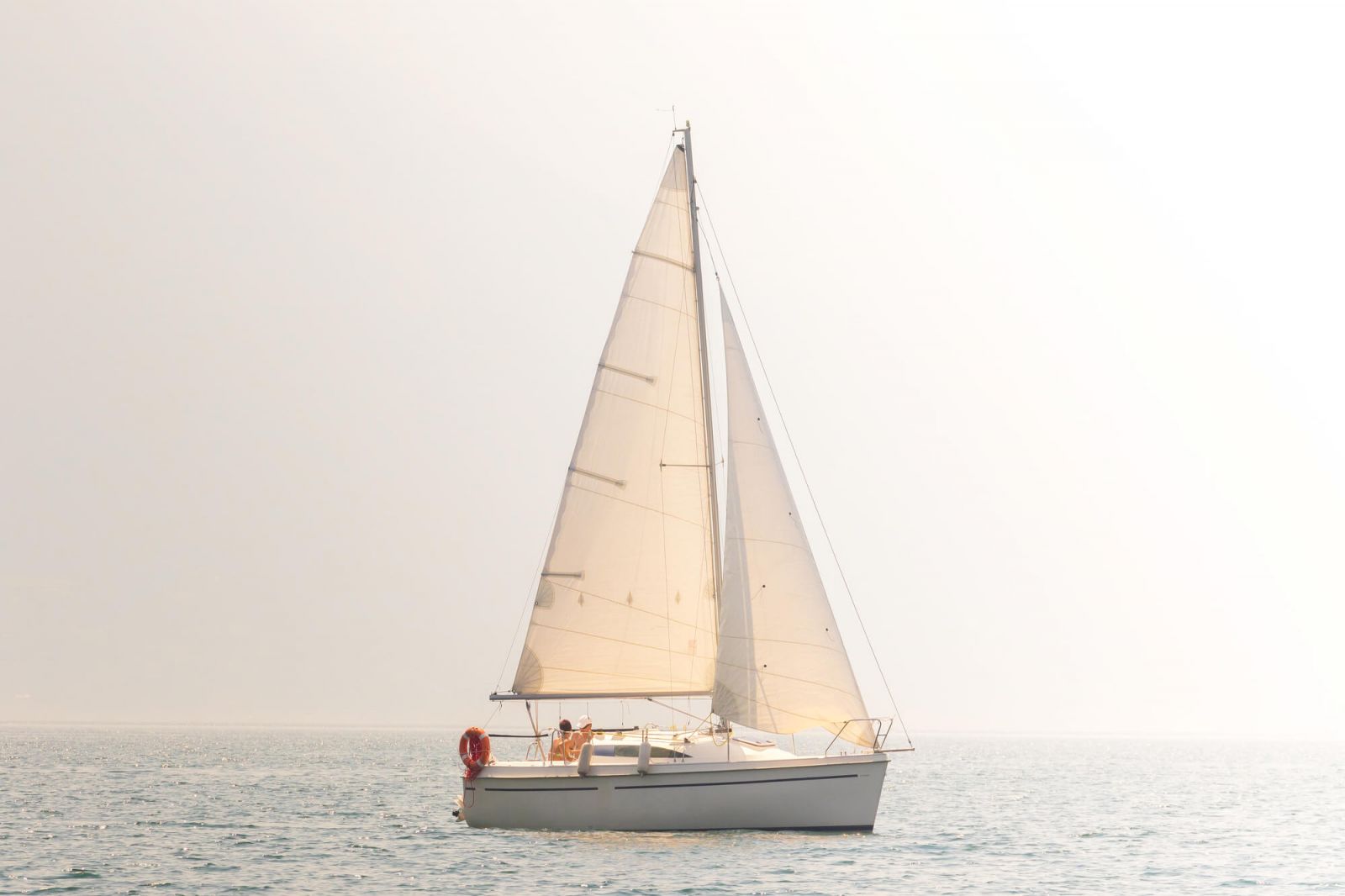
By this, I want to encourage you to get into solo sailing, even if you lack a sailboat that is specifically made for a one-person crew. Quite a few single-handed passages have been done on boats that wouldn't make it to this list because technically, they don't fit the profile. But they were made to be, either with tweaks or with skills. Be honest to yourself regarding your skill level, the boat design, and if it passes the test, go for it.
Happy sailing!
Leave a comment
You may also like, what’s the largest boat one person can operate.
So you're looking for something big, but want to go at it alone. Sailing single-handed (also known as short-handed) is perfectly doable, although not always ideal. …

Raising the Mainsail Single Handed: 5 Pro Tips

How Big Should a Sailboat Be to Sail Around the World?
Own your first boat within a year on any budget.
A sailboat doesn't have to be expensive if you know what you're doing. If you want to learn how to make your sailing dream reality within a year, leave your email and I'll send you free updates . I don't like spam - I will only send helpful content.
Ready to Own Your First Boat?
Just tell us the best email address to send your tips to:
You’ll Want To Save Every Penny To Buy One Of These Extraordinary Boats
Say it with us: “I’m on a boat!”
Of course, depending on where you live and what layer of the economic strata you land in, you’ll probably be picturing something different than the person next to you . Some of us think of the humble fisherman bracing against a storm at sea. Others might be taken back to memories of their parents ditching the 9-to-5 and sailing them around the world . Others still may be thinking about the studio yacht party at last year’s Cannes.
Whatever thought or memory is conjured for you, one constant remains — those boats had to be built well, so as not to end up at the bottom of the drink. Last month, Van Dam Custom Boats showed us the mastery that goes into their stunning crafts. Here, take a peek:
In honor of that mastery, we’ve compiled a list of some of our other favorite boats we’d love to spend a day or 70 out on the water with. Some are humble, some are bombastic, some are faraway dreams. All of them are superb.
BOSTON WHALER – FISHING BOAT
View this post on Instagram #conquest #sunset A post shared by Official Boston Whaler, Inc. (@boston_whaler) on Aug 23, 2016 at 4:24am PDT
Perhaps it’s best to start out with a little sport and utility before we get into the big hauls. A solid, well-equipped fishing boat is the first step in anyone’s sea-adventuring life. You go out, find some fish, fish those fish, and bring home dinner — all with the added benefit of knowing exactly what that dinner is . It can be a solo journey or a family affair. Either way a fishing boat is where most of us will start our water journeys.
There are so many fishing boat companies to chose from out there. Boston Whalers are always sturdy and reliable. They come completely customizable and tend to last in rough seas or calm.
View this post on Instagram #420Outrage A post shared by Official Boston Whaler, Inc. (@boston_whaler) on Feb 29, 2016 at 1:12pm PST
VAN DAM CLASSIC RUNABOUT
View this post on Instagram Throwback to a 2005 Van Dam build, Susan C. #vandamcustomboat #vandamboats #tbt #vandamsusanc #woodboat #boating #woodenboat #boats #wood #detail #unique #beauty #onthelake #boat #boatbuilders #custom A post shared by Van Dam Custom Boats (@vandamcustomboats) on May 12, 2016 at 11:17am PDT
A classic runabout or tender can get you from Point A to Point B in sleek style. Or they can help you get away from the Holy Grail henchmen along the canals of Venice . It’s a throwback to the days when people summered on bays and lakes and needed a water-savvy form of transportation to skim speedily across the water. Although these boats aren’t equipped to land a marlin or pull crab pots, they’re going to get you around while looking fly. And that’s worthwhile.
Van Dam is your best bet of getting behind the wheel of one of these throwback beauties — unless you’re a Kennedy or Bush and summer in New England .
View this post on Instagram Discussing details of the dash. #vandamcustomboats #vandamvictoriaz #vandamboats #boats #boat #vandamcustom #customboat #boating #woodboat #woodboats #woodenboats #woodenboat #woodenboatsarebetter #barco #barca #bateau #woodwork #details #custommade #custom #vz #craftsmanship #dashwork #dash #wood #fast A post shared by Van Dam Custom Boats (@vandamcustomboats) on Jul 7, 2016 at 8:26am PDT
POLYNEISAN VOYAGING CANOE
View this post on Instagram Got to see @kala_dacaptain participate in an opening ceremony of the #UltimateWatermanChallenge and see this beautiful #WakaHaunui sail into #OkahuBay in Auckland! Reminded me our our beloved #Hōkūleʻa #hokuleawwv sailing somewhere in the middle of the sea. Check out hokulea.com to support their efforts and see all the good works they have been up to! #MalamaPono A post shared by Paula Fuga (@pfunklove) on Mar 15, 2016 at 12:04pm PDT
Long before Columbus sailed the ocean blue, Polynesians were bobbing around the Pacific on massive outrigger canoes. These canoes got the Polynesians from deep in the South Pacific all the way to the North American coast with nothing more than a couple hauls, sails, and the starry night to guide them.
Although this may be a more advanced form of sailing (outrigger canoes take some serious skills), it’d still be a blast retracing the steps of ancient Hawaiians or Polynesians across the Pacific or around the world in your very own voyaging canoe. After all, an entire culture of people spent millennia perfecting their boats to do exactly that.
Alternately, you can spend a few years, and less dollars, custom building one yourself — there’s space in your garage, right?
View this post on Instagram Crossings #hōkūleʻa #rough A post shared by Bruddah Cliff (@cliff_kapono) on May 5, 2013 at 9:51pm PDT
HALLBERG-RASSEY 64
View this post on Instagram The Hallberg-Rassy Rally where everybody wins 2016 #hallbergrassy #sailingyacht #hallbergrassyrally #vsyc #yacht #yachting #segling #sailchecker #sailcheck #sailingstagram #sailuniversedaily #ellös #orust #segeln #sailinglife #sailzone #segling #sailing #segeln #hallbergrassy43mkii A post shared by Hallberg-Rassy (@hallbergrassy) on Jun 19, 2016 at 12:32am PDT
Full disclosure, I sailed one of these boats across an ocean. So my including it on the list isn’t negating the abundance of other great makes of sailboats on the market. I just like this one. I know it. I sailed her blind in the pitch black nights. I slept, cooked, ate, and bathed with this boat for months. And that’s the rub. You can live in this boat and make the world your oyster (also, you’ll be on the sea, so oysters can be your oyster).
For about the same price as a small house ($250,000), you can call this boat your home. Hallberg -Rassey make seriously well constructed and spacious sailing vessels that can handle any of the seven seas. A family of four to six can easily live in the 64-foot sloop. Maybe you’re making the wrong mortgage payment and it’s time to live life at sea? Well, then this is a solid investment in your future and well-being. Adventure literally awaits.
View this post on Instagram Hallberg-Rassy 46 Mahina Tiare III repost @tor.johnson.photography In Fiji with our friends John and Amanda of Mahina Expeditions. They do offshore sailing courses all over the world, and occasionally we bump into each other. ⛵️#sailing #sailingstagram #fiji #SailUniverseDaily #hallbergrassy #hallbergrassy46 #mahinatiare #båtliv #magasinetseilas #seilmagasinet #sailcheck #sailchecker #sailzone #sailingstagram #yacht #Yachting #vsyc #bluewatersailing #långfärdssegling #fahrtensegeln #långsegling #upptäckbåtlivet A post shared by Hallberg-Rassy (@hallbergrassy) on May 2, 2016 at 6:15am PDT
DRAGONFLY TRIMARAN
View this post on Instagram New for 2016 – Dragonfly 28 Performance #trimaran #sailing faster than wind speed A post shared by Dragonfly UK (@dragonflytrimarans.uk) on Apr 9, 2016 at 1:00am PDT
Now we’re getting into speed, class, and design brilliance. A streamlined main hull has two outer floats attached to bring the speed. Overall, this class of sailboat is for someone seeking a side of adventure with their main course of easy cruising.
Dragonfly’s Trimarans are consistently considered some of the best boats in their class for sailing competitively or leisurely . Their compact and sleek design is award-winning . If you’re thinking of getting into racing, this may be your gateway boat.
View this post on Instagram Dragonfly 32 #trimaran A post shared by Dragonfly UK (@dragonflytrimarans.uk) on Jan 22, 2015 at 12:04am PST
ITALIA YACHTS
View this post on Instagram Italia 15.98, a true blue water dream / Sailing near @portopiccolosistiana #trieste / Ph @nicolabrollo #italiandesign #vela #luxury #italiayachts #sailing #cruising #crociera / www.italiayachts.it A post shared by Italia Yachts Venezia (@italiayachts) on May 18, 2016 at 1:29am PDT
So you’ve decided to become a sailboat racer… You’ll need a boat that is hydrodynamical, built by masters who take the time to design a cruiser that can cut through the water at competitive speeds.
Italia Yachts combine the same devotion to hydrodynamics as they do to classic Italian style. Their boats are sleek. Their decks are clean and designed photo ready. The boats are big enough — and well laid out enough — for your racing team to live comfortably while you cross the sea. And they are fast .
View this post on Instagram Flying with Italia 10.98 #trilli! Photo by the great Tony Costa #tonycosta #trilli #italiayachts #italia1098 #italiandesign #sailing #regatta www.italiayachts.it A post shared by Italia Yachts Venezia (@italiayachts) on Mar 11, 2016 at 8:26am PST
SANLORENZO LUXURY YACHT
View this post on Instagram Good morning with Sanlorenzo 460EXP))) ⚓️☀️ #sanlorenzo #sanlorenzoyachts #460exp #explorer #yachts #yacht #yachting #smartyachts #goodmorning #gmorning A post shared by Julia Skoptsova (@julia_skoptsova) on Aug 21, 2016 at 10:43pm PDT
There’s another class of sailing boat that tops all of these. They’re the luxury yachts. And when you win the lottery or invent whatever it is that replaces Facebook this will be your boat. These are for the dreamers whose dreams come true. Lucky bastards.
Sanlorenzo’s yachts are nicer than most 5-star hotels, and they cost about as much as a castle . But you can probably afford that with your lottery winnings too. These boats are for the 1 percent of the 1 percent, and their luxury knows no bounds. Now, where’d I put that lottery ticket…?
View this post on Instagram The spacious and all-new 138ft/42m superyacht 460EXP built by @sanlorenzoyacht Photo: @robbreportbsb A post shared by MRSUPERYACHTS (@mrsuperyachts) on Sep 30, 2015 at 12:01pm PDT
A FREAKING PIRATE SHIP
https://www.instagram.com/p/BKqKEs4ggte/
Childhood fantasies of buried treasure and adventure on the high seas are always fun to live out. So, why not buy a dang pirate ship? Yes, you can buy a pirate ship (or build one if that’s your thing). Whether or not you’ll find treasure or plunder other ships, well, that’s up to you.
You’ll be hard-pressed to find a pirate ship on the market, but they are out there . Otherwise, you’re going to have to build one yourself. Either way, it’s the most kickass way to sail the world’s seven seas. Let’s face it, who doesn’t want to roll into a new country in a foreboding, badass pirate ship with black sails and a Jolly Rodger flying from the mizzen mast?
View this post on Instagram Photo: Hannah. #photography #beautifulpic #boat #ship #pirateship #sailboat #ocean #sky A post shared by 🌙☀️🌲🍂🌸 (@curiousadventurez) on Sep 22, 2016 at 1:28pm PDT

- 2024 BOAT BUYERS GUIDE
- SHALLOW WATER FISHING
- Email Newsletters
- Boating Tips
- Boating Safety
- Electronics
- Best Marine Electronics & Technology
- Baits & Lures
- Fishing Tackle
- Fishing Travel
- Conservation
- Fishing Knots
- Women in Fishing

Small Boats for Offshore Fishing
- By Sport Fishing Staff
- Updated: July 28, 2020
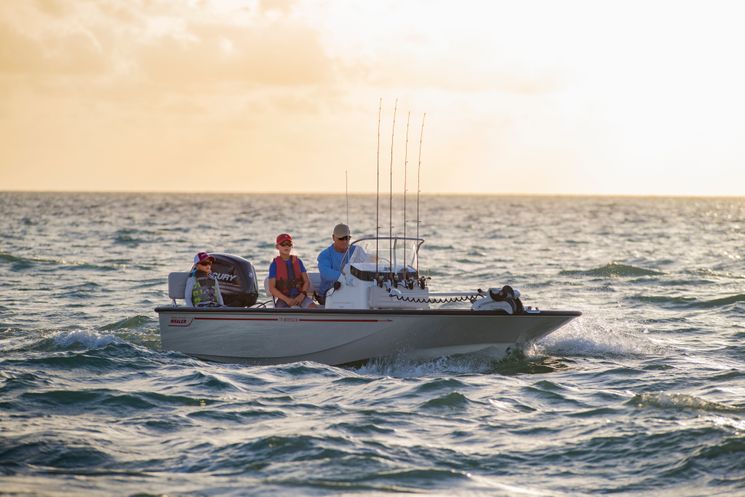
What is the minimum size boat for offshore fishing? The answer depends on who you ask. The challenge and your budget are the two biggest reasons for fishing from a small offshore boat. Many cite the unique satisfaction of taking on the ocean to fish it on their own terms, knowing they have the boat, the knowledge and the ability to get out there, catch some good fish and get back.
“There’s definitely the excitement of being out there in a small boat where you’re in control and doing your own thing,” said Angelo Cuanang, a West Coast offshore fishing writer and expert who regularly runs out to fish off San Francisco Bay. He’s done so for many years — all in a 17-foot Boston Whaler Montauk. Being unsinkable, the Whaler is one of the best small boats for ocean fishing.
One school of thought from skilled mariners actually considers a smaller hull advantageous in large swells. Tom King, once a professional mate in Massachusetts, for years made the 20-plus-mile run to fish Stellwagen Bank aboard his 19-foot Midland (“a Nova Scotia-style hull,” he said, with a very high bow and very low freeboard). “We came home riding on top of the big seas like an eggshell, while much bigger sport-fishing boats were having a tough time rolling in the swells.”
For purposes of this discussion, let’s focus on saltwater fishing boats with a minimum size ranging from 17 to 22 feet in length overall (LOA). A boat this size has an element of responsiveness that much larger hulls lose. In addition to being a criterion for offshore fishing, this size range also offers the best small boats for rough seas. Of course, rough seas are relative, and distance from shore often dictates the decision to go or not go.
Offshore Boating Benefits of Small Fishing Boats
Besides the challenge, downsized boats are less expensive and easy to tow on the road than king-size boats. Small boats can also be easier to handle and dock in tight quarters, though features such as joystick controls on larger boats are making low-speed maneuvers easier for skippers of large boats.
Start comparing costs of purchase, insurance , moorage or storage, maintenance and so on for a 30-foot center-console with those of a 22-footer. Then of course there are fuel costs. At today’s prices, a day fishing a 30-footer with twin 300 hp outboards can cost you in the high hundreds of dollars, if not more than $1,000. But you can run offshore and troll all day in a boat such as the Robalo R222 (21 feet 6 inches LOA) or Sea Chaser 22 HFC (21 feet 9 inches LOA) with a single 200 or 250 hp outboard for a few hundred or less.
Lots of anglers trailer their boats 50 to 100 miles at the drop of a hat. Compare hauling a double- or triple-axle trailer behind a ¾- to 1-ton pickup versus a lighter, single- or double-axle trailer behind a half-ton pickup — and there’s even more economy.
Small-Boat Knowledge, Ability and Common Sense
There’s no federal regulation stating that “Thou shalt not take thy boat and go (offshore),” and in fact the Coast Guard only has authority in a few places to prevent boaters from going where they want, a Coast Guard spokesman said.
To go or not to go is not the question. Rather, focus on knowing your small boat, recognizing when to go or not, and with what gear and preparation.
Accident reports often retell scenarios where anglers in small boats perished before the Coast Guard could reach them. Often these are cases where knowing the boat and having the right equipment could have saved lives.
Experience often makes a major difference when it comes to safety. Anglers who know what the ocean can dish out and respect that power choose to err on the side of caution, and do not scrimp on safety gear.
Many who skipper such mighty mites far from land tend to be independent by nature. Still, many make it a point to travel offshore with another boat — known as “buddy boating”— when possible, small or large, which in effect offers a second engine.
Whether or not you have a buddy going with you, be sure to file a float plan before you leave. That can be as simple as making sure someone back on land knows when you plan to depart and return, and where — in general — you expect to fish.
The Right Boat: Moderate Vees and Hard Chines
What is the best small boat for offshore fishing? There are plenty of 17- to 22-footers for fishing bays, channels or flats. But if you plan to run offshore, you’ll need to investigate construction, quality and design.
That said, some bay boats such as the Pathfinder 2200 TE (22 feet 2 inches LOA) or Sea Born FX22 Bay Sport (21 foot 9 inches LOA) offer offshore fishing capability, as well as the ability to sneak into shallow inshore waters.
Still, there can be no doubt that with the specialized demands of offshore fishing, not all small hulls are created equal. When it comes to hull design, opinions vary — suggesting competent small hulls might come in more than one style.
A modified V rather than the deep V common on larger center consoles ranks as the top choice among experts looking for the optimal small planing hull for big water. While the steeper deadrise angle of up to 26 degrees at the transom offers the softest ride through waves, an angle in the 17- to 20-degree range proves more stable. That way you still get some damping effect from the V but also get some benefit of lateral stability.
Fuel capacity becomes a serious consideration for any small boat heading offshore. On the minus side: Many small boats have built-in tanks and some provide space only for portables. On the plus side: Light boats with small outboards can go all day on amazingly little fuel. Once you pick a boat, know its range and always allow for at least a 10 percent reserve.
A small but important point: marine battery placement . Batteries should ride forward, beneath the console, rather than at the transom, where they can get wet and add unnecessary weight.
One other essential element of small boat construction that becomes particularly important offshore is flotation. Positive flotation is required for certification by the National Marine Manufacturers Association in boats less than 20 feet, but the best hulls are fully filled with foam, and the reasons should be obvious. In an emergency, water can force air out of a hull or sides but not out of foam. A light hull gains little weight (always a factor) but considerable strength and rigidity from foam.
Water In; Water Out
A small boat easily takes on spray and, on rough days, some green water as well. That’s when scuppers become critical. (This assumes that no angler without a death wish would be offshore in a boat that’s not self-bailing.) The scuppers must be able to drain water as fast as it comes into the hull — if not, you’ll soon be playing submarine.
Transom height and design also play key roles in keeping water out of small boats. A small outboard-powered boat faces trouble fast once enough ocean water enters and runs to one side or the other in heavy seas. To help avoid that, look for small offshore boats with a full transom. A cut-out transom might work with a really good, generous motorwell. Worst case for offshore: a low, cut-out transom with no well. If that describes your boat, stick to the bay.
The Right Offshore Boating Equipment
No small boat, however seaworthy and stable, belongs offshore — ever — if it’s not properly equipped. The most major piece of equipment to consider is your outboard engine . A traditional preference among blue-water anglers has been twin or even triple outboards for safety. However, adding a second engine for the small boater might be either cost-, design- or weight-prohibitive. Fortunately, today’s outboard engines are more reliable than ever.
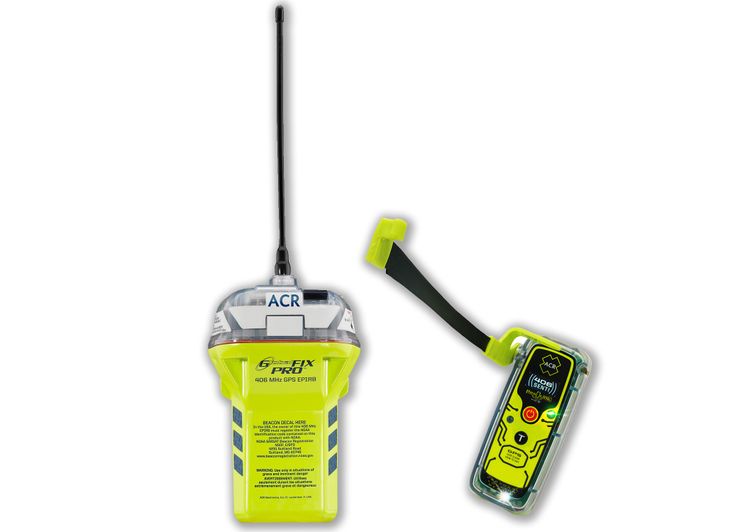
When feasible, a small auxiliary engine (aka kicker) is a great addition since it can get you home in a pinch — but, again, it may not be worth the additional weight on the stern of a 17- to 22-footer.
Additional key safety equipment to carry when fishing offshore includes the following:
Fixed-Mount VHF Radio — Fundamental and essential. Fixed-mount radios offer a range of 15 to 20 miles while handhelds only reach out 3 to 8 miles. All new VHFs, by law, come with Digital Selective Calling, which instantly sends a distress call to authorities anywhere in the world. Be sure that you set up your DSC calling feature before leaving port. Cell phones have become popular everywhere, including offshore, and offer some backup. But these can’t substitute for a VHF in a pinch since users might not find coverage in all areas offshore, and a phone call does not immediately summon on-water help. Mate your VHF radio to a tall (8-foot) VHF antenna for the range necessary when fishing offshore.
GPS Plotter/Sounder — As critical for navigation as for fishing. Separate units are fine, but a single unit (capable of showing both chart plotter and sounder reading on screen simultaneously) maximizes limited space on small consoles.
Compass — With a good nautical chart, a compass will keep you headed in the right direction if your GPS fails. Amazingly, some small boaters venture far offshore with neither radio nor compass, according to the Coast Guard.
Extra Battery — Any boat fishing offshore should have a dual-battery system with a selector switch. This allows you to keep one battery in reserve in case one goes dead.
Emergency Beacons — An EPIRB (Emergency Position Indicator Radio Beacon) and a PLB (Personal Locator Beacon) are good ideas for any boat fishing offshore. Once activated, an encoded digital message is received by satellites, and is then transmitted back to ground-based search and rescue authorities. This signal provides information to assist in the search. Assuming you have properly registered the EPIRB or PLB, it tells rescuers who you are, your boat type and size, where you are, and other important data, including emergency contact information. An EPIRB is registered to the boat and is usually mounted on deck, while a PLB is registered to an individual and is carried by that person.
Life Jackets — Going offshore without them would not only be illegal but insane. Make sure your jackets are Coast Guard rated for offshore use (Type I). It is a good idea to wear a life jacket at all times, especially if fishing alone.
Emergency Kit — including flare gun and flares, cyalume sticks and waterproof strobe lights. (I also make sure my boat’s running lights are in good working order.) Don’t forget a good flashlight and extra sunscreen.
Emergency Food and Water — At least a half-gallon of water, some granola bars and beef jerky or canned meat can get you through a day or two.
Anchor and Lots of Line — Even if you don’t anchor to fish, you might find an anchor valuable, and plenty of heavy line is a must if you need to be towed.
Sea Anchor — Space might preclude stowing a small sea anchor, but make sure you have at least a bucket or, in a pinch, even a spare life jacket. Most boats tend to drift stern-to — the worst situation in a building sea. Your odds of staying afloat when broken down and adrift go up by a big chunk if you can keep the bow into the waves, and any sort of sea anchor will help accomplish this.
Pick the Right Fishing Weather
Given a seaworthy boat, properly equipped, everything else comes down to common sense. And nowhere can the small boater better demonstrate that than by reading the weather before and during a trip.
Starting out the morning in a 3-foot sea is a mere irritant to a 30-footer, but for the mini-boater who has his head screwed on right, it means a canceled trip. Many mornings I’ve arisen to find the weather service data revised from the previous evening’s 5- to 10-knot wind forecast to one of 10 to 20 knots. Anyone hoping to go offshore in a 17- to 22-footer has to realize his fishing days will be limited.
Look for periods between frontal systems, particularly in fall, winter and spring when dead-calm days sneak in between blows. During the summer, high pressure systems often bring many successive days of calm weather, particularly in the morning. The run home in many regions might mean a moderate but manageable chop, thanks to afternoon sea breezes.
Just be sure you know the marine forecast for the day, before you head out. When the forecast calls for light breezes all day and into the night, boating anglers with small boats can usually venture forth into offshore ocean waters with peace of mind. Otherwise, the best rule of thumb is a simple one: When in doubt, don’t go out.
- More: Boating Skills , Center Consoles , fishing boats , Marine Electronics , Saltwater Fishing Gear

What’s Good Fuel Economy for a Fishing Boat?

Yamaha Releases New 350 Horsepower Outboard
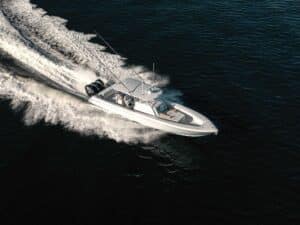
Supersize Center-Consoles Expand Angling Horizons
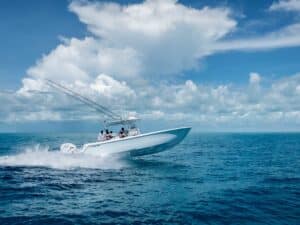
Things To Look For in a Jig-and-Pop Boat
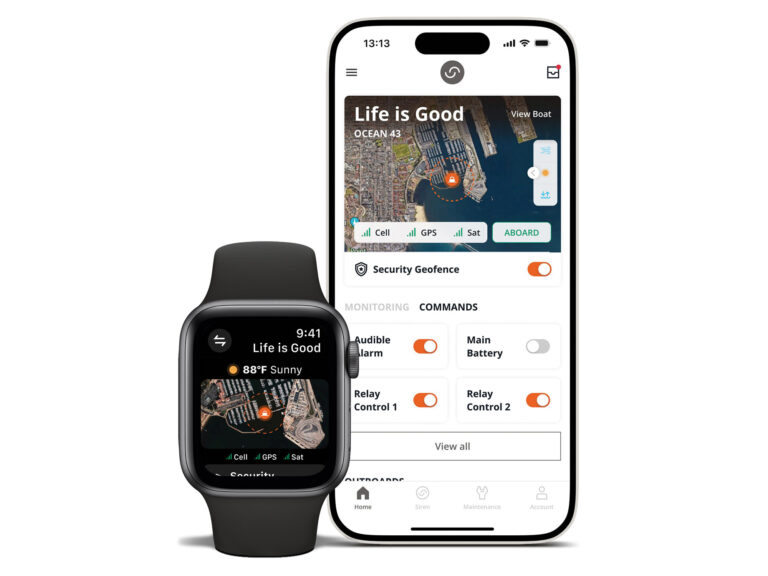
New Gear: The Siren Connected Boat App
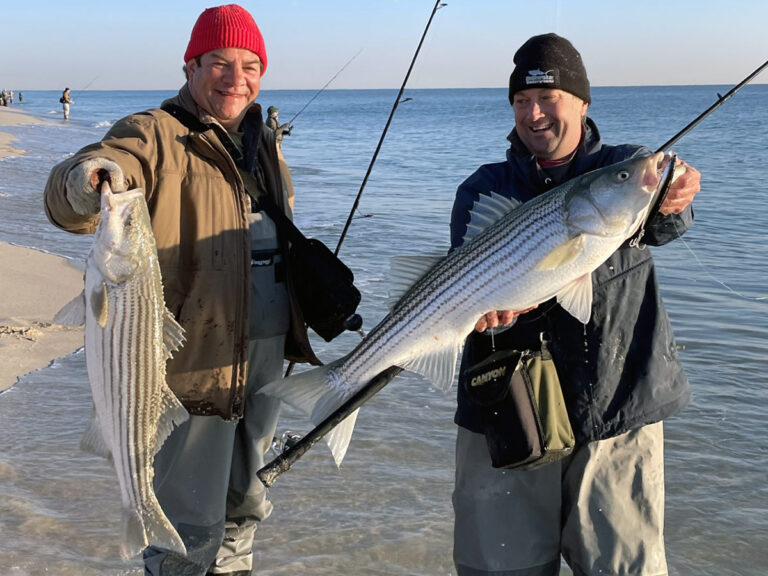
QUICK GUIDE: Surf Fishing Etiquette
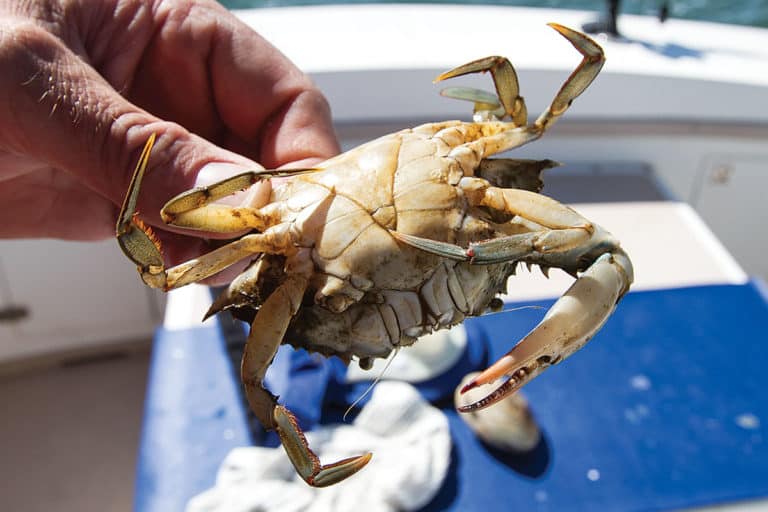
Fishing With Crabs as Bait
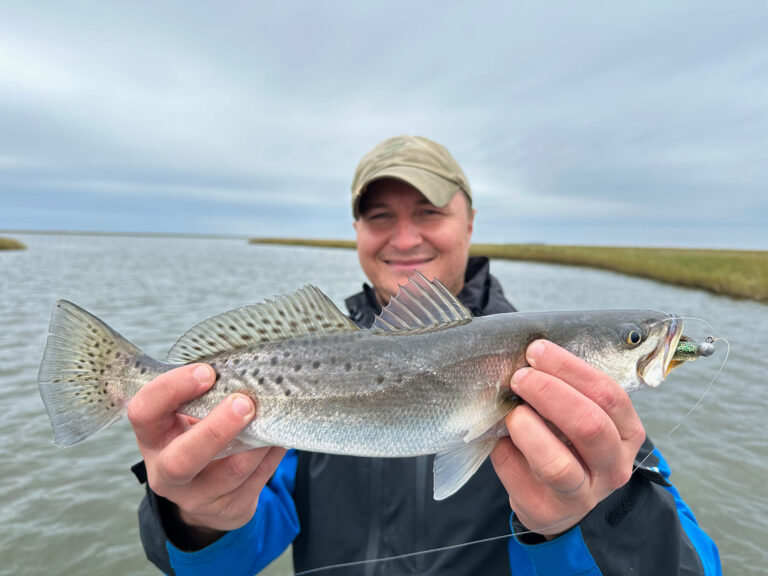
West Winds Are the Best Winds
- Privacy Policy
- Cruising World
- Sailing World
- Salt Water Sportsman
- Sport Fishing
- Wakeboarding
Many products featured on this site were editorially chosen. Sport Fishing may receive financial compensation for products purchased through this site.
Copyright © 2024 Sport Fishing Firecrown . All rights reserved. Reproduction in whole or in part without permission is prohibited.

IMAGES
VIDEO
COMMENTS
Choosing the right sailboat size for ocean sailing is a crucial decision that can greatly impact your experience on the water. Whether you're planning to embark on a long-distance voyage or cross oceans, finding an ocean-worthy sailboat is essential for safety, comfort, and performance.
The average sailor needs a boat that is at least 30 to 40 ft long to sail in the ocean. Transatlantic sails have been made on boats under 10 feet long, but the smaller the boat, the more dangerous the journey, and the more skilled the sailor must be. Here is everything that you need to learn about how big of a sailboat you need for ocean ...
Take that same flat board and put a keel on it. If the keel is on a flat face, it will be very stable, but still stable upside down, as well. Put the keel on the edge, it will only ever settle keel down. A skinny boat rolls less because there is less outboard flotation to be lifted by a wave.
The size of the sail area determines the boat's power and speed. It is essential to strike a balance between sail area and boat size to ensure safety and stability. For smaller sailboats (10-15 feet), it is recommended to have a sail area of 50-100 square feet, which is approximately 6-7% of the boat's displacement.
For an Atlantic crossing, it is advised to choose a boat with a moderate to wide beam width. This will ensure stability in unpredictable ocean conditions. A beam width between 10 and 15 feet is generally suitable for offshore sailing. A real-life example illustrates the importance of beam width.
What Size Boat For Ocean Crossing? If you're looking for a quick answer to this question, the Atlantic Rally For Cruisers (ARC), which is run by the World Cruising Club every year in November from the Canary Islands to the Caribbean, requires a length of 27 feet minimum sailboat sizes for ocean crossing, in order to enter the competition.
Consider your needs before buying your boat. If you are a solo sailor or have a huge family, if you cruise or race, or if you want to sail the ocean, your needs and size of the boat will change. Most sailboats range between 15-40 feet. Depending on your needs, you may need 15-25 or 25-40 feet.
Vancouver 28. Photo credit: YachtFathom.co.uk. A sensible small boat with a "go-anywhere" attitude, this pocket cruiser was designed with ocean sailors in mind. One of the best cruising sailboats under 40 feet, the Vancouver 28 is great sailing in a small package. Hull Type:Full keel with transom hung rudder.
The greatest advantage a modern yacht has over an older, heavier boat is speed. A modern yacht's ability to make headway fast is in fact one of its most seaworthy points as it allows the crew to navigate around a slow-moving storm or to sail off . a dangerous lee shore in the event the engine dies or the anchor drags.
June 15, 2022. American sailboats come in all shapes and sizes, from tiny inflatable 12-foot dinghies to enormous 150-foot mega yachts. The average sailboat size in the United States is about 30 to 35 feet overall in length. These vessels are usually classified as 'coastal cruisers,' as they're seaworthy enough for limited offshore use.
What size boat is safe for the ocean? ... It's important to understand that the condition of a boat determines whether it's ocean-worthy or not. One day the ocean could be glass-calm and as smooth as silk, and just about any boat would be fine running through its waters. The next day stormy seas could make it uncomfortable even on a 100 ...
The perfect sized catamaran for ocean sailing (including around the world sailing) is around 40ft; it is small enough to be sailed by one person but big enough to provide safety and speed. Of course, there are many variables to consider, and below we will discuss many of them. Before we can decide which one is perfect for our needs, we need to ...
The west coast of the US is known to be one of the most treacherous bodies of water in the world, The ocean can be very unpredictable, many people claim 45feet or larger is required, many have made the trip in alot smaller boats, pick your weather, plan, know what your getting into, have a well found boat, and good luck. Roman.
It took me some time to get there but with time and experience I found the ideal boat for the cruising couple is 35 - 45 feet (10.5 - 14 metres). Go smaller, or larger, than this cruising sweet spot and you start to encounter problems. A 35 - 45 feet vessel with a draft of about 2 metres, 6' to 8', to help the vessel sail in most weather ...
With good sailing skills, general common sense and a good conditioned boat of that size most boats would be fine for a daysail even on the ocean. Weather would basically be a defining factor here. Common sense, a good weather forcast, knowledge of tides and a good VHF is important and basic knowlege of the engine if any is alway a plus.
Deep-V hulls are considered to be 21 degrees or more. Consider this if you're looking for the best deadrise for rough water. "I'd say look for a deadrise of more than 20 degrees," he advised, "and a length-to-beam ratio on the waterline that is greater than 3.5 to 1.
Checking out our Boat Finder tool is an excellent way to find the best boat for you and your family, but if you want to limit your search to the best boats for ocean boating, there are some special considerations to take into account. Filter your search by "Boat Offshore" on the Boat Finder, and you'll find you're left with nine choices. 9 Best Ocean Boats
The Atlantic Ocean, for example, is a journey of 3,000 nautical miles, so you'll want to ensure the yacht you are using to cross it is a sturdy, ocean going vessel. Many superyachts will make the Atlantic Ocean crossing twice a year - in the fall to head to the Caribbean, and in the spring to return to the Mediterranean.
In this article, I talk about single-handed sailing and look at the nine best sailboats for one person, ranging from small lake dinghies all the way to comfy cruisers capable of oceanic crossings. Here are the best sailboats for solo sailing. RS Aero. Jeanneau Sunfast 3200. Beneteau Oceanis 62.
The Baba 30 also offers a nice extra perk. According to Jack Hornon, she "continues to have one of the highest resale values of any boat of this type and size.". A quick look at Yacht World reveals Baba 30s from the mid-70s and mid-80s typically cost anywhere between $20,000 and $70,000.
Dragonfly's Trimarans are consistently considered some of the best boats in their class for sailing competitively or leisurely. Their compact and sleek design is award-winning. If you're ...
It was designed for it, stiff boat with good stability. At the same level you can find rank overrigged 45feet boats that behave erratic in ocean sailing. So the most important part is the boats stiffness together with its stability, not so much its size. Though size ofcourse make things more comfortable.
Being unsinkable, the Whaler is one of the best small boats for ocean fishing. One school of thought from skilled mariners actually considers a smaller hull advantageous in large swells. Tom King, once a professional mate in Massachusetts, for years made the 20-plus-mile run to fish Stellwagen Bank aboard his 19-foot Midland ("a Nova Scotia ...